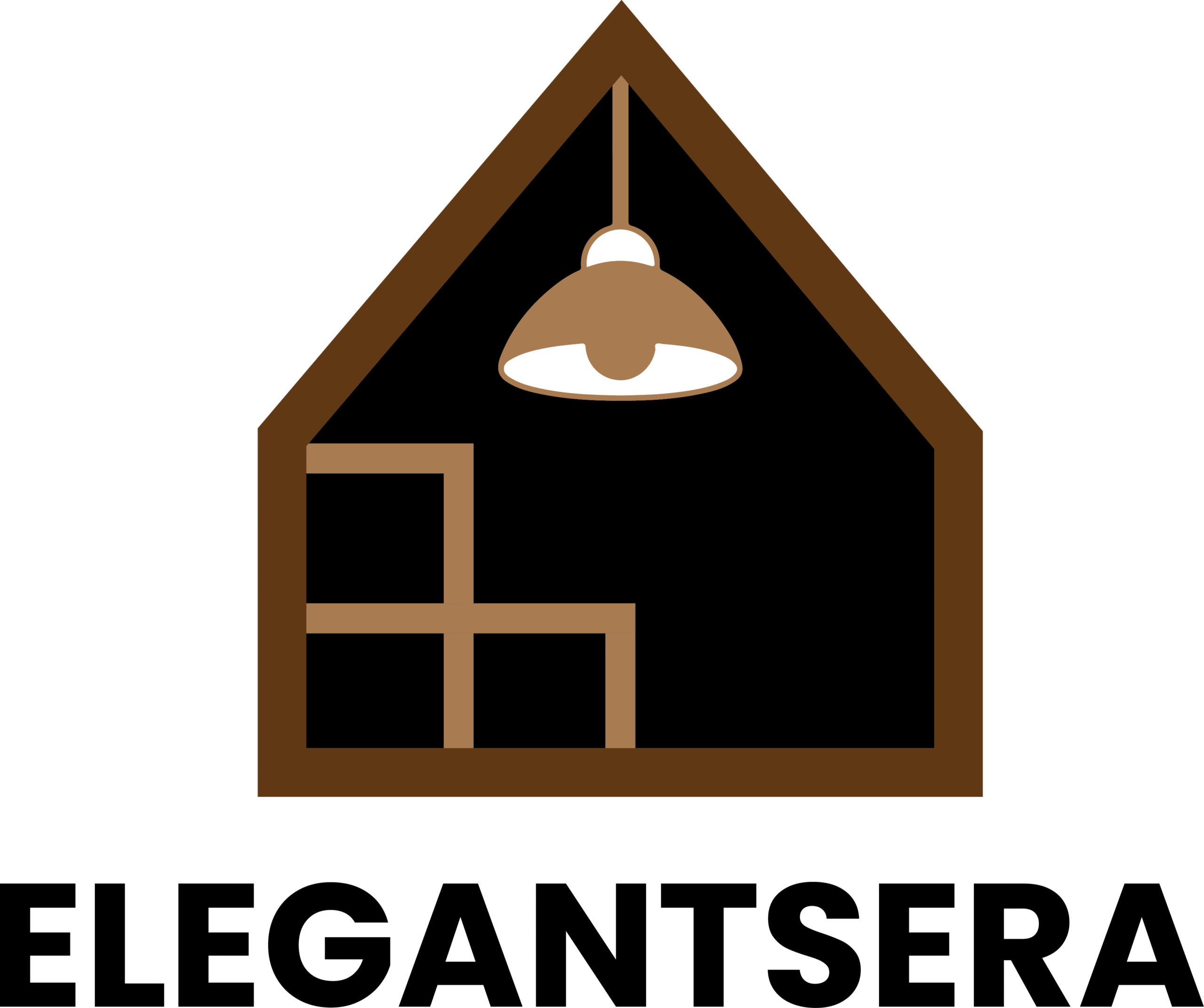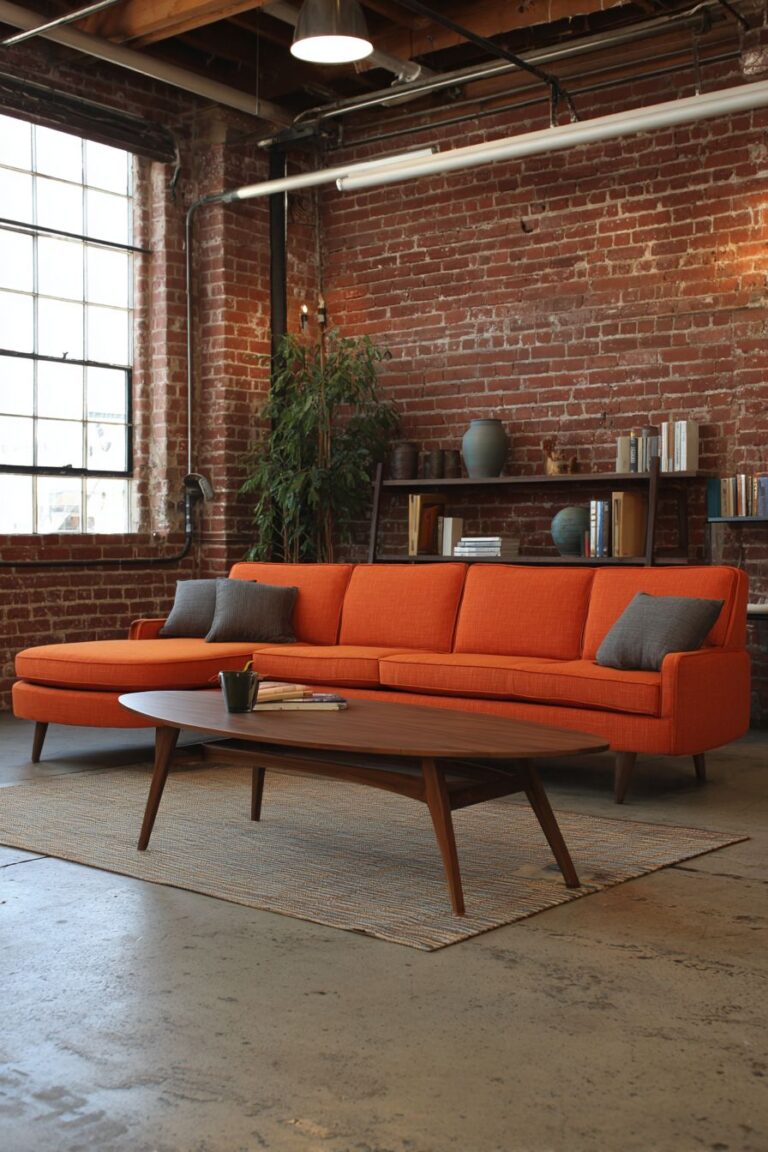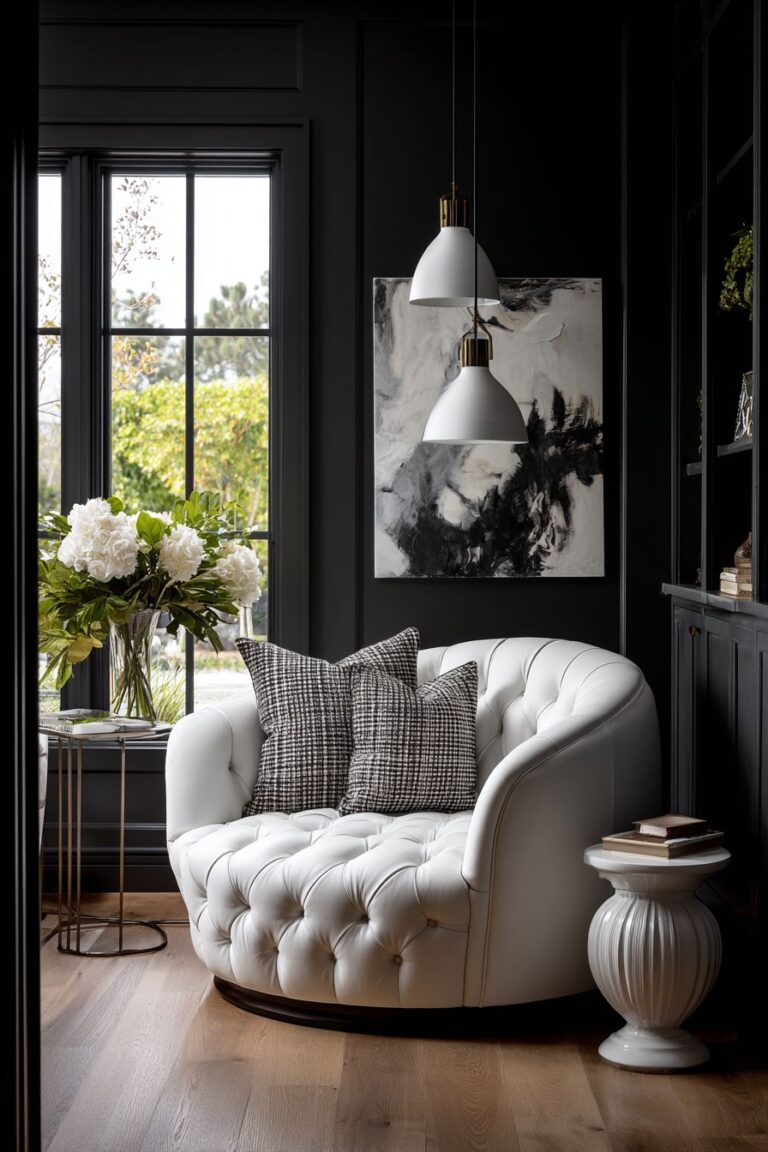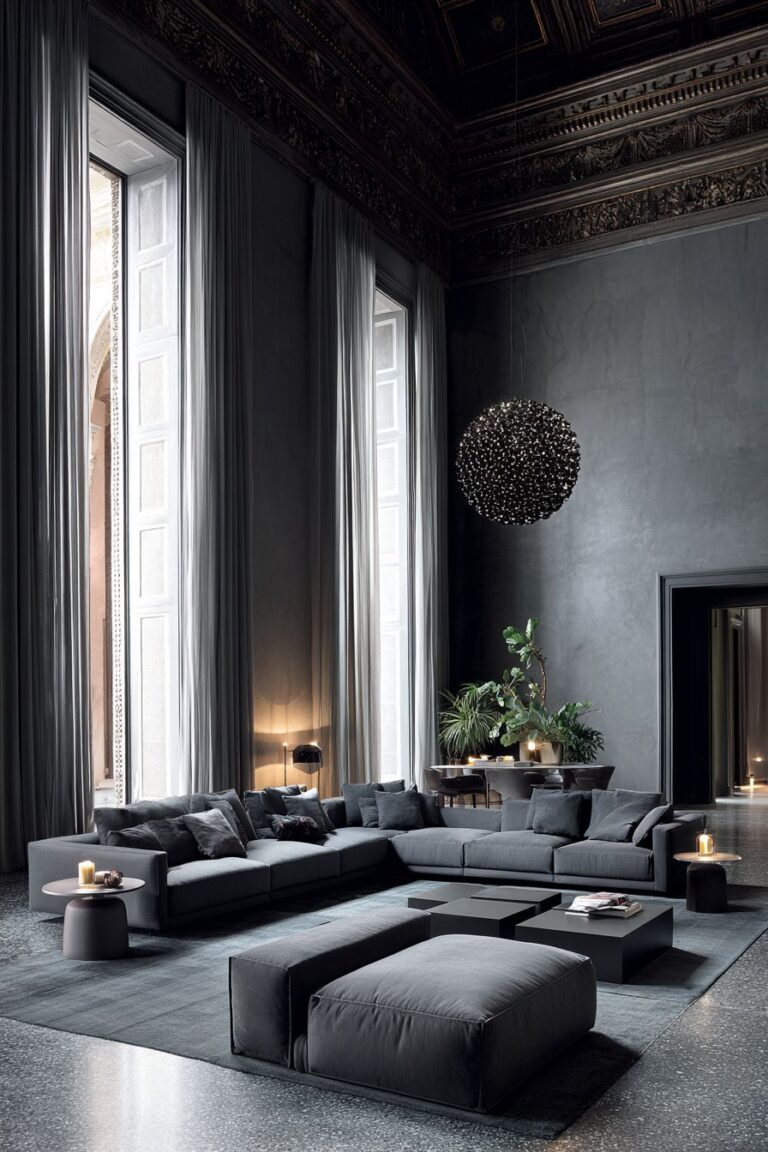20 Transitional Living Room Ideas: Balance Between Classic & Modern
In the ever-evolving world of interior design, few styles capture the essence of sophisticated living quite like the transitional living room. This design approach masterfully bridges the gap between traditional elegance and contemporary functionality, creating spaces that feel both timeless and refreshingly current. The transitional style has emerged as one of the most sought-after design philosophies for homeowners who appreciate classic beauty but refuse to sacrifice modern convenience and comfort.
The beauty of transitional design lies in its ability to honor the past while embracing the present. This style speaks to those who find themselves drawn to both the ornate details of traditional furniture and the clean lines of contemporary pieces. Rather than forcing a choice between these seemingly opposing aesthetics, transitional design creates harmony through careful curation and thoughtful placement. The result is a living space that feels both familiar and fresh, sophisticated yet approachable.
Throughout this comprehensive exploration, we’ll discover twenty distinct transitional living room concepts that showcase the versatility and appeal of this beloved design style. From neutral sectionals paired with dark wood coffee tables to built-in entertainment centers housing modern technology, each space demonstrates how traditional elements can be seamlessly integrated with contemporary features. These designs prove that transitional style isn’t just about compromise—it’s about creating the perfect synthesis of form and function that enhances daily living while maintaining timeless appeal.
1. Classic Comfort Meets Contemporary Clean Lines
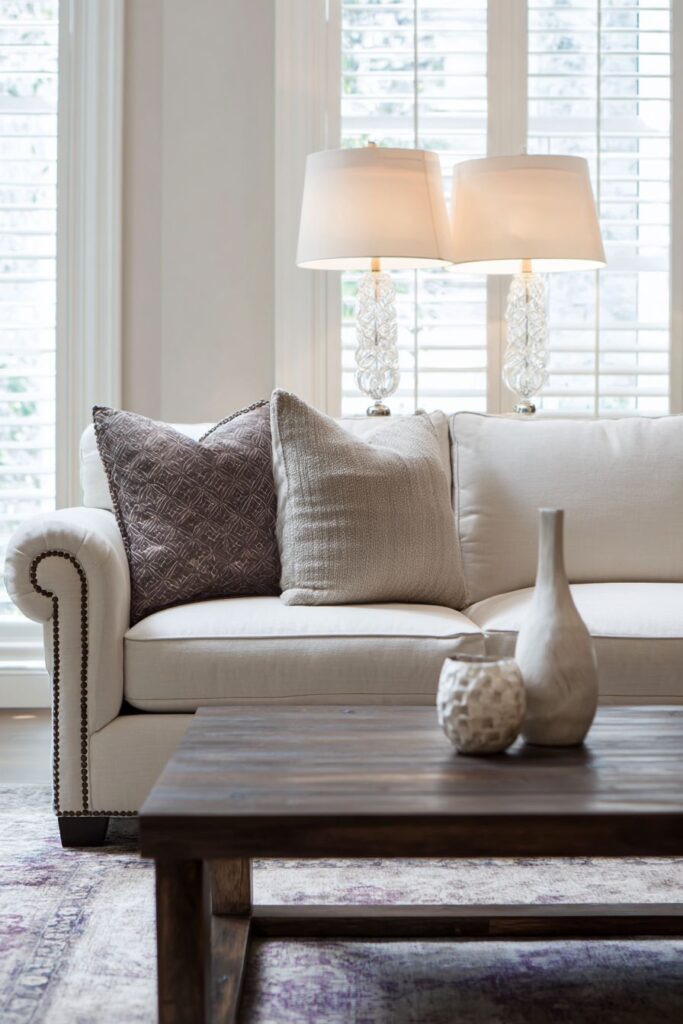
The foundation of this transitional living room rests on a luxurious neutral beige sectional sofa, where traditional rolled arms and sophisticated nailhead trim details create an immediate sense of established elegance. The sectional’s generous proportions invite relaxation while maintaining the refined silhouette that speaks to classical design sensibilities. This substantial seating arrangement becomes the anchor point around which all other elements harmoniously revolve.
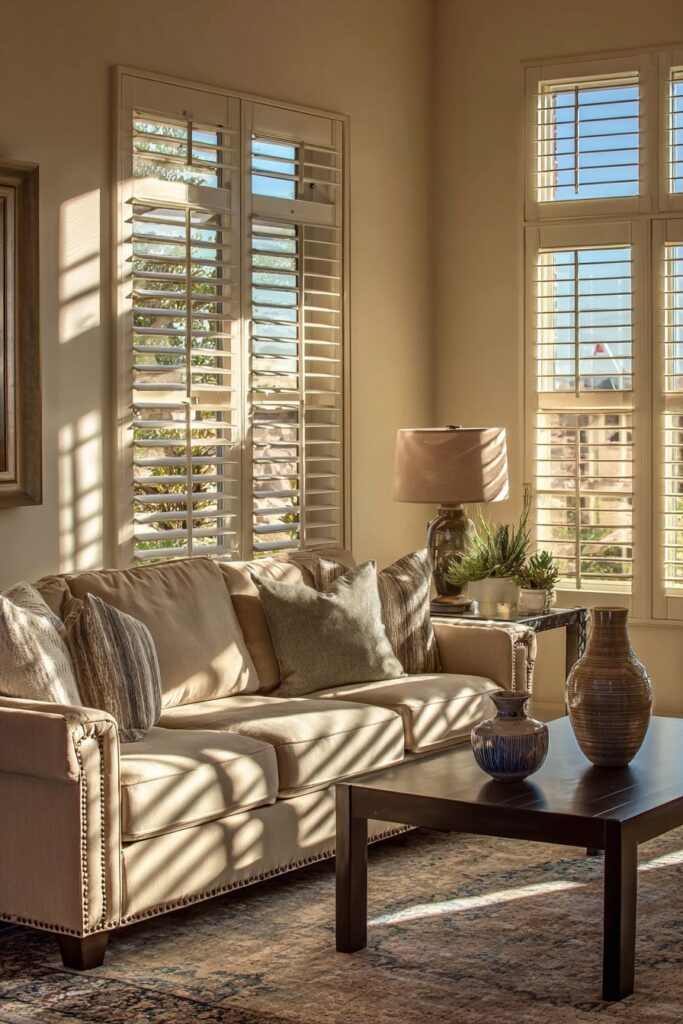
A dark wood coffee table with impeccably clean lines provides the perfect counterpoint to the sectional’s traditional styling. The rich wood grain brings natural warmth to the space while its simplified form speaks to contemporary design principles. This pairing demonstrates the fundamental principle of transitional design: allowing each piece to maintain its distinct character while contributing to a cohesive whole.
The lighting scheme thoughtfully layers traditional and contemporary elements through classic table lamps crowned with fabric shades positioned alongside sleek ceramic accent pieces. This combination ensures both functional illumination and visual interest, creating pools of warm light that enhance the room’s welcoming atmosphere. The Persian-inspired area rug, rendered in sophisticated muted colors, serves as the foundation that unifies all seating elements while adding pattern and texture underfoot.
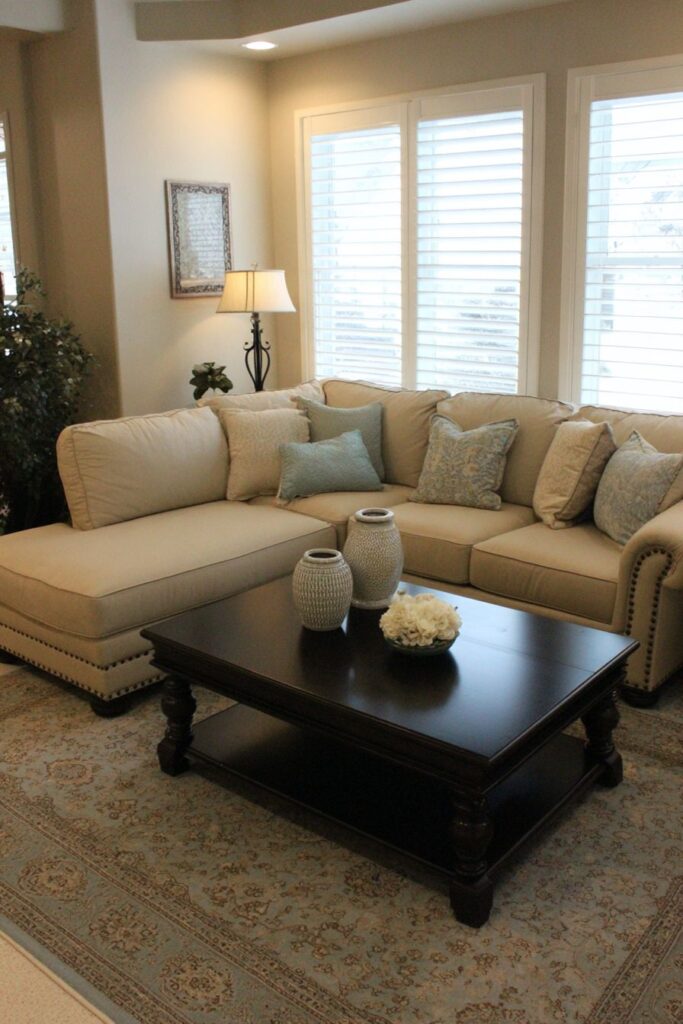
Natural light filtering through plantation shutters creates ever-changing shadows and highlights that bring the space to life throughout the day. These architectural window treatments provide both privacy and light control while maintaining the room’s refined aesthetic. The shutters’ clean horizontal lines complement the contemporary elements while their classic styling honors traditional design heritage.
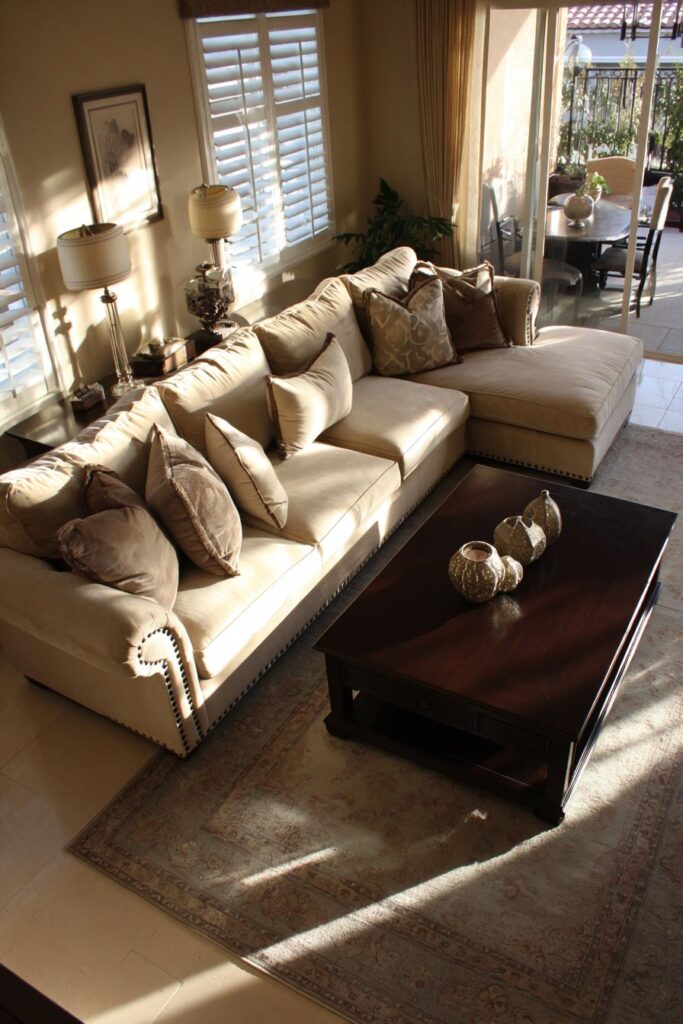
Key design elements for achieving this balanced look include choosing a substantial sectional with traditional details like rolled arms or nailhead trim for anchoring the space, selecting a coffee table that contrasts in style but complements in scale and proportion, incorporating both traditional table lamps and contemporary accent pieces for visual variety, using area rugs with classic patterns in subdued colorways to bridge different style elements, and utilizing architectural window treatments that provide both function and style continuity.
2. Built-In Beauty with Contemporary Flair
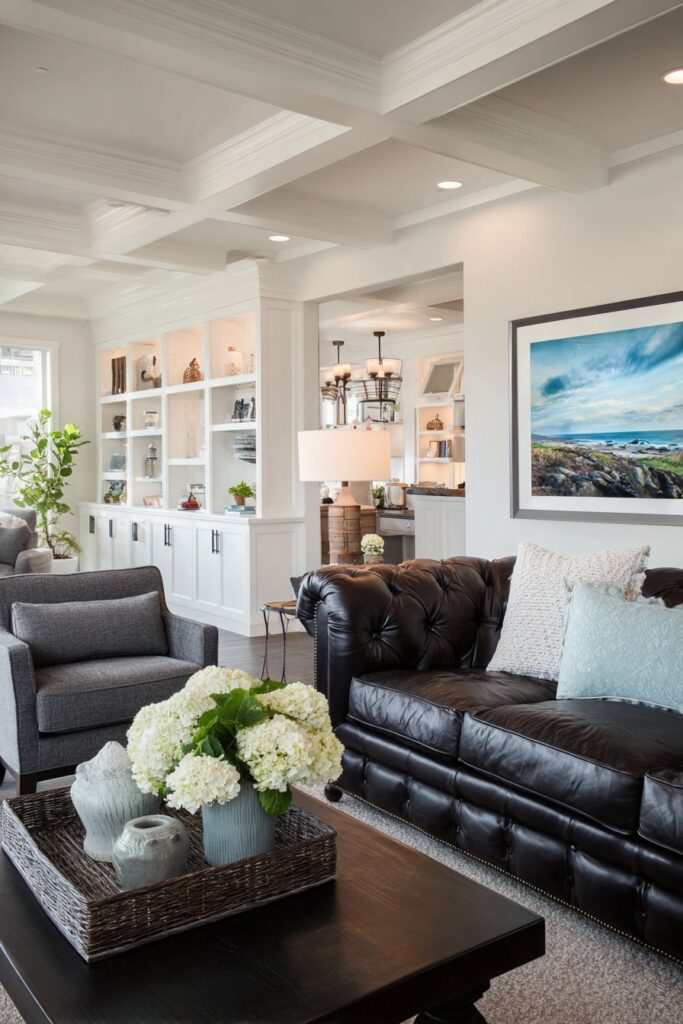
This sophisticated transitional living room showcases the power of built-in storage solutions that seamlessly blend traditional craftsmanship with modern functionality. The custom bookcases, painted in soft white with rich dark wood shelving, create a stunning focal wall that provides both open display space and concealed storage. The combination of open and closed storage options reflects the transitional approach of honoring traditional built-in furniture while adapting to contemporary organizational needs.
The seating arrangement presents a masterful study in contrasts, featuring a classic Chesterfield sofa in sophisticated charcoal fabric paired with sleek modern accent chairs. The Chesterfield’s deeply tufted surface and traditional silhouette brings gravitas and established elegance to the room, while the contemporary chairs introduce fresh lines and updated proportions. This pairing exemplifies how transitional design allows different eras to coexist beautifully within the same space.
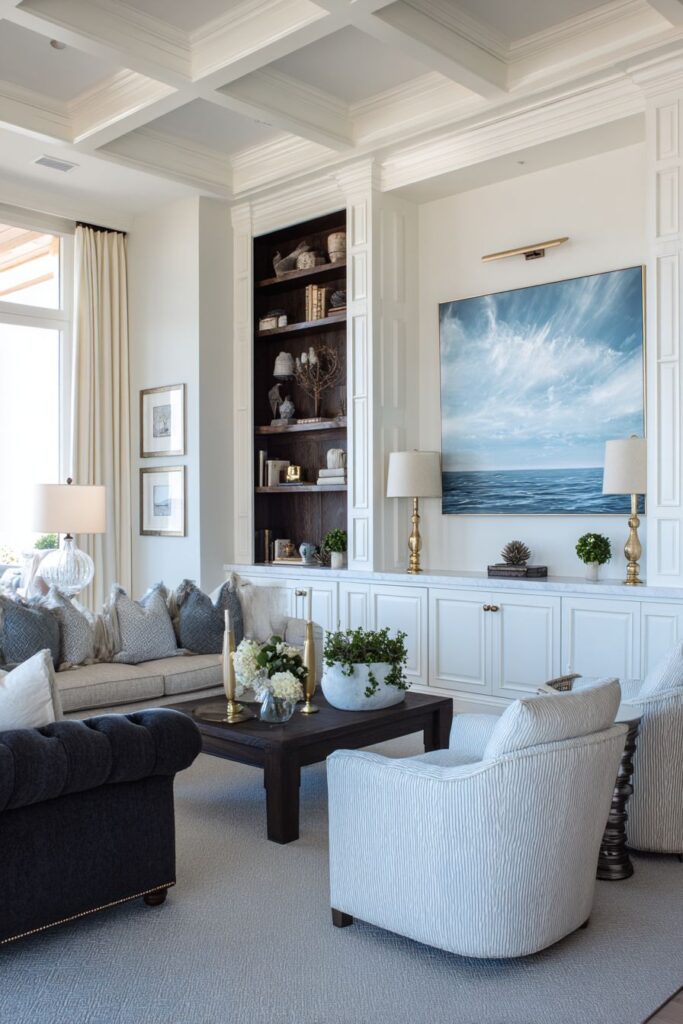
Brass table lamps contribute warm ambient lighting that enhances the room’s sophisticated atmosphere while contemporary artwork adds visual punch and personality. The brass fixtures nod to traditional materials and craftsmanship while their clean forms keep the overall aesthetic current. The artwork selection provides an opportunity to inject color, pattern, or abstract forms that energize the more traditional furnishings.
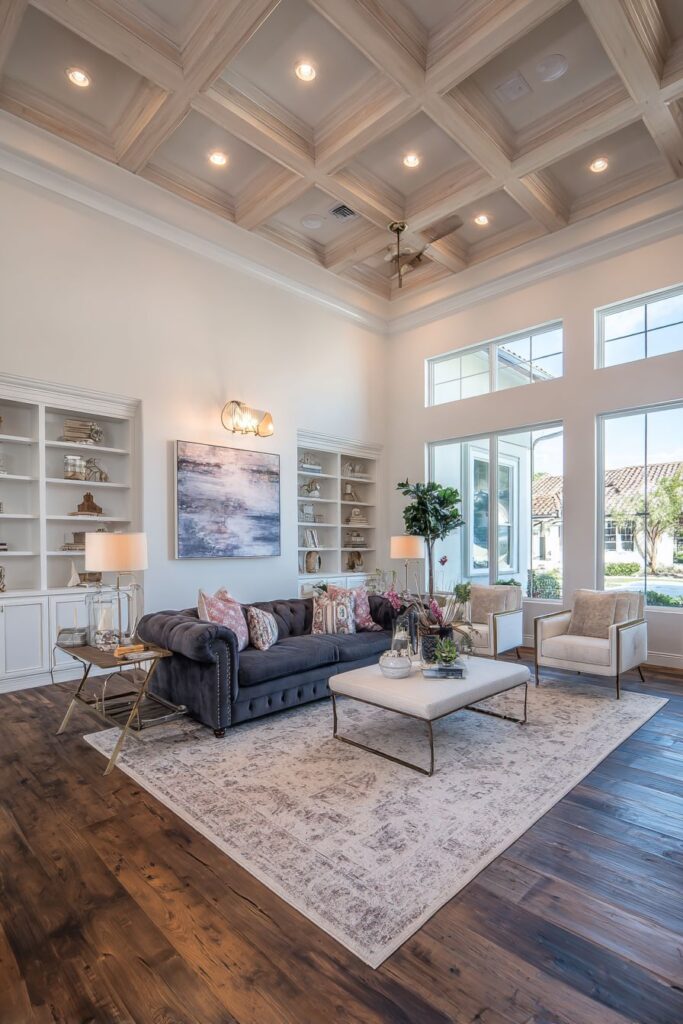
The built-in storage solution deserves particular attention for its thoughtful design that addresses modern living needs while maintaining traditional aesthetic appeal. The combination of open shelving for displaying treasured objects and closed cabinetry for concealing everyday items creates a space that can remain beautiful and organized. The contrast between the painted white frames and dark wood shelving adds visual depth and sophistication.
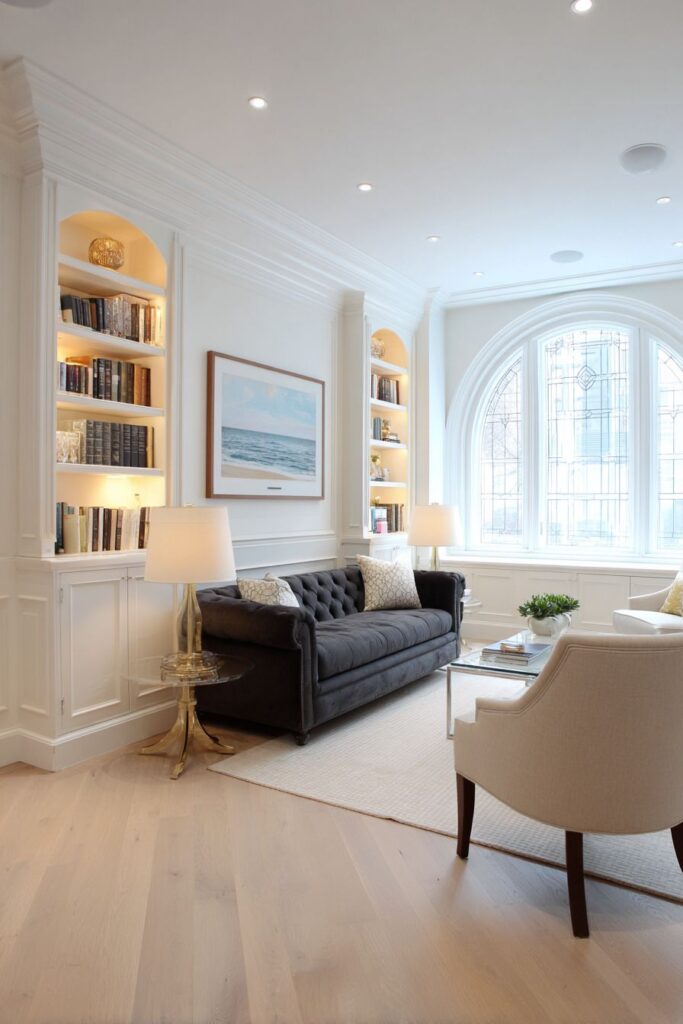
Essential strategies for incorporating built-in storage include designing custom storage solutions that combine open and closed options for maximum functionality, using contrasting materials like painted frames with wood shelving for visual interest, balancing traditional furniture silhouettes with contemporary accent pieces for style variety, selecting brass or warm metal fixtures to bridge traditional and contemporary lighting needs, and choosing contemporary artwork that energizes traditional furnishings while maintaining overall cohesion.
3. Sophisticated Gray Palette with Leather Accents
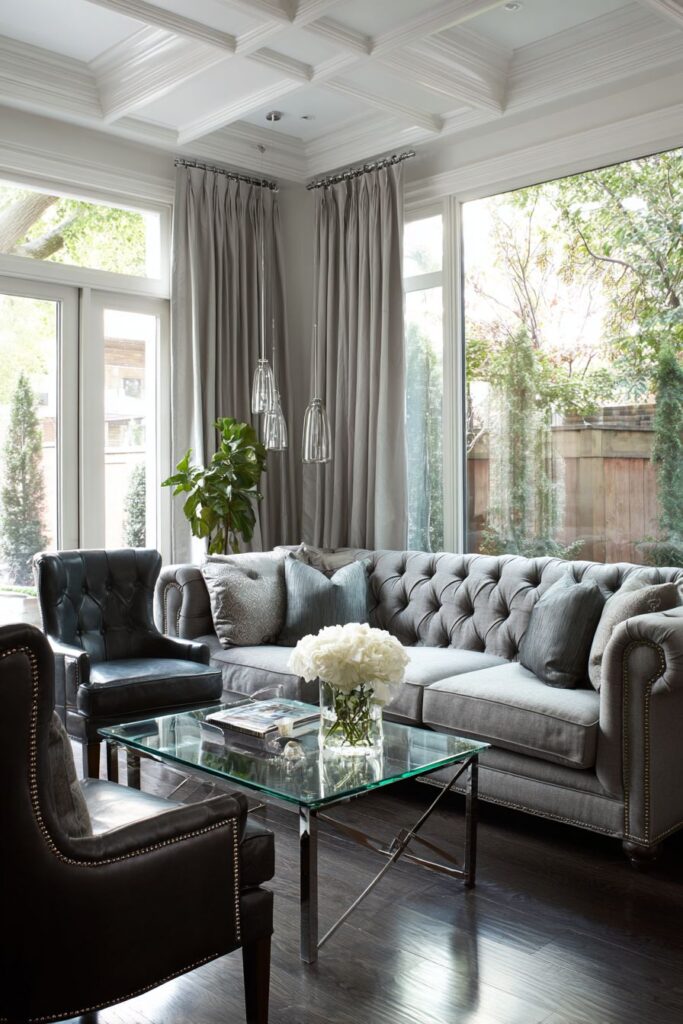
This elegant transitional living room centers around a generous sectional upholstered in soft gray linen, where traditional button tufting details add textural interest and classic appeal. The linen fabric choice brings natural beauty and contemporary casualness to the traditional tufted silhouette, creating a piece that feels both refined and approachable. The sectional’s substantial size ensures ample seating for family gatherings while maintaining the sophisticated proportions that anchor the entire room design.
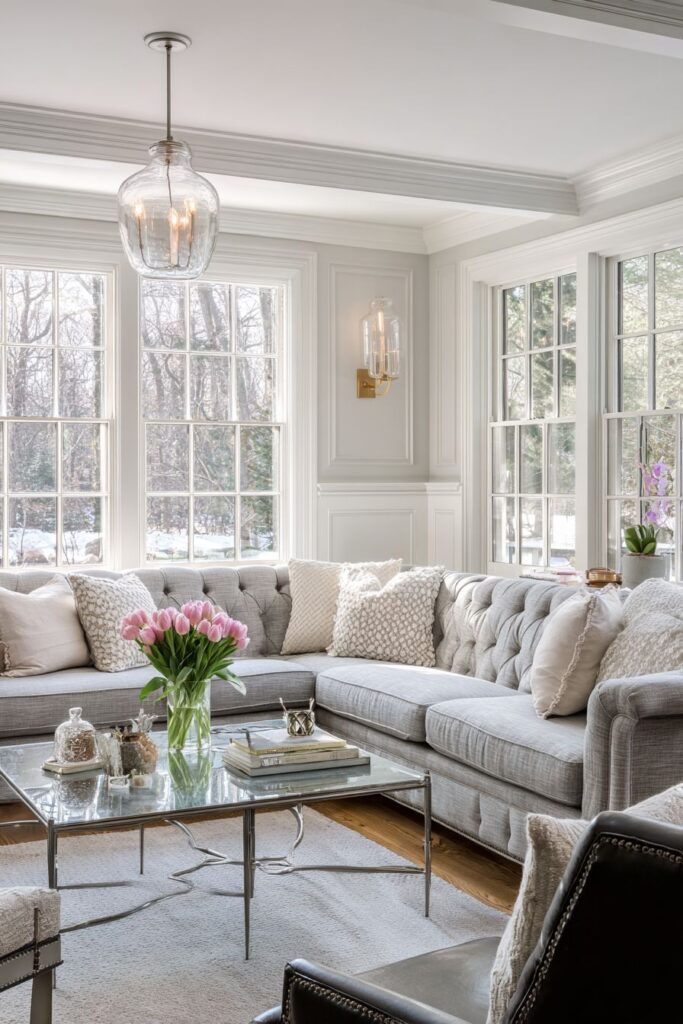
The modern glass-top coffee table with sleek metal legs provides a striking contemporary counterpoint to the traditional sectional. This transparent surface allows the beautiful area rug beneath to show through while the metal framework introduces industrial materials in an elegant way. The coffee table’s minimal profile ensures it doesn’t compete with the sectional’s substantial presence while providing essential functionality for daily living.
Classic wingback chairs in rich navy leather add both additional seating and a dose of traditional luxury to the space. The wingback silhouette represents one of furniture design’s most enduring forms, while the navy leather brings both durability and sophisticated color contrast. These chairs serve as statement pieces that demonstrate how traditional furniture forms can maintain their relevance in contemporary spaces through thoughtful material and color choices.
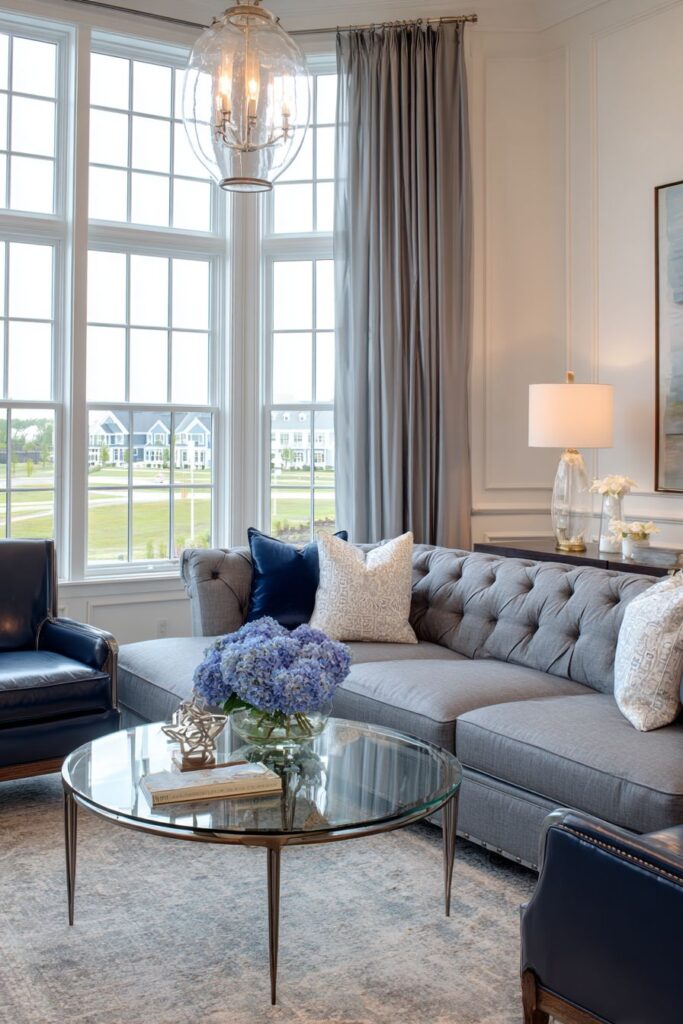
The room’s architectural details, including crown molding and wainscoting painted in crisp white, provide the traditional framework that allows contemporary furnishings to shine. These classic millwork details add visual height and architectural interest while their clean white finish keeps the overall palette fresh and current. Contemporary pendant lighting introduces modern illumination solutions that complement rather than compete with the traditional architectural features.
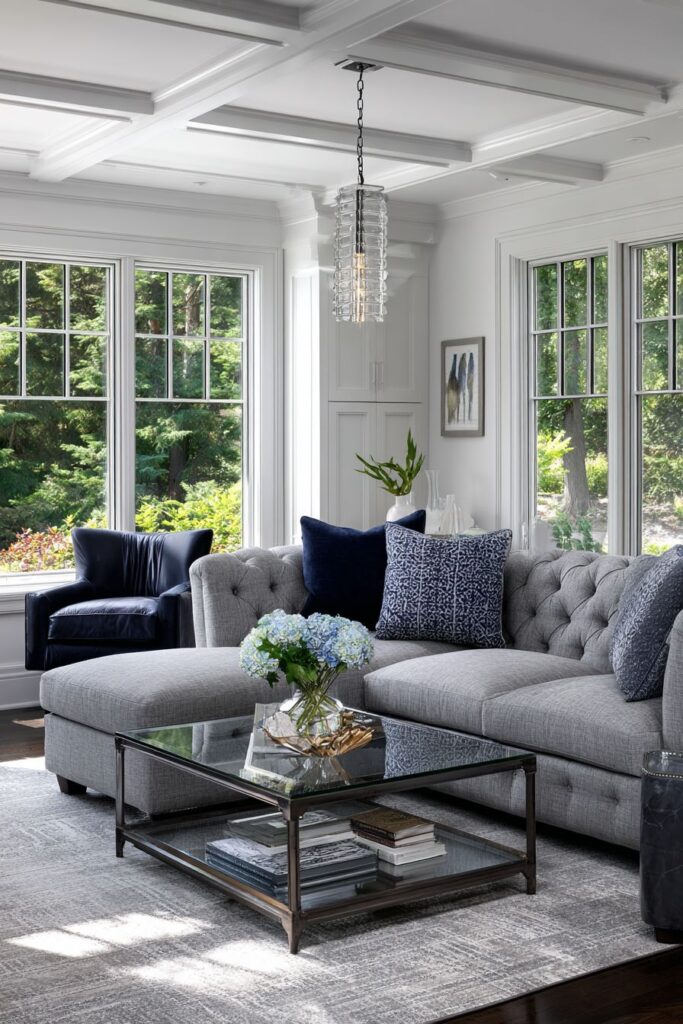
Key approaches for achieving this sophisticated balance include selecting sectional seating with traditional details like button tufting in contemporary fabrics, incorporating transparent coffee tables that don’t visually compete with substantial seating, adding classic wingback chairs in rich materials for both seating and visual anchor points, using architectural details like crown molding to create traditional framework for contemporary elements, and choosing pendant lighting that provides modern function while respecting traditional proportions.
4. Fireplace Focus with Modern Technology
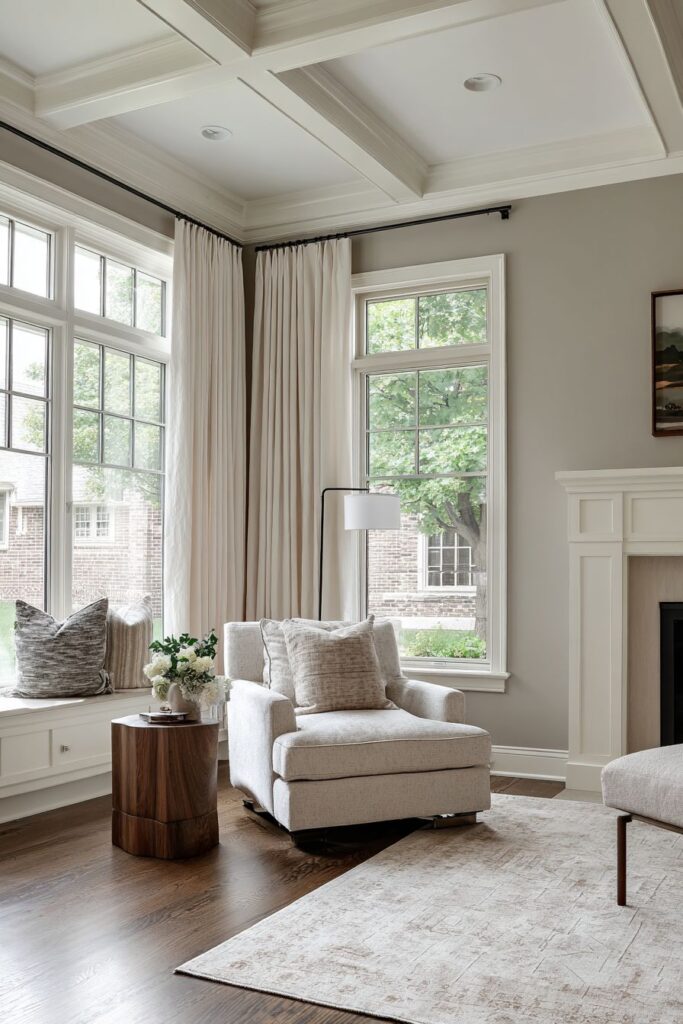
The heart of this transitional living room revolves around a beautifully appointed fireplace area where traditional architecture meets contemporary technology. The classic mantelpiece, painted in clean white, provides the perfect frame for a sleek contemporary linear electric fireplace insert. This pairing demonstrates how transitional design can honor traditional architectural elements while embracing modern conveniences and energy-efficient solutions.
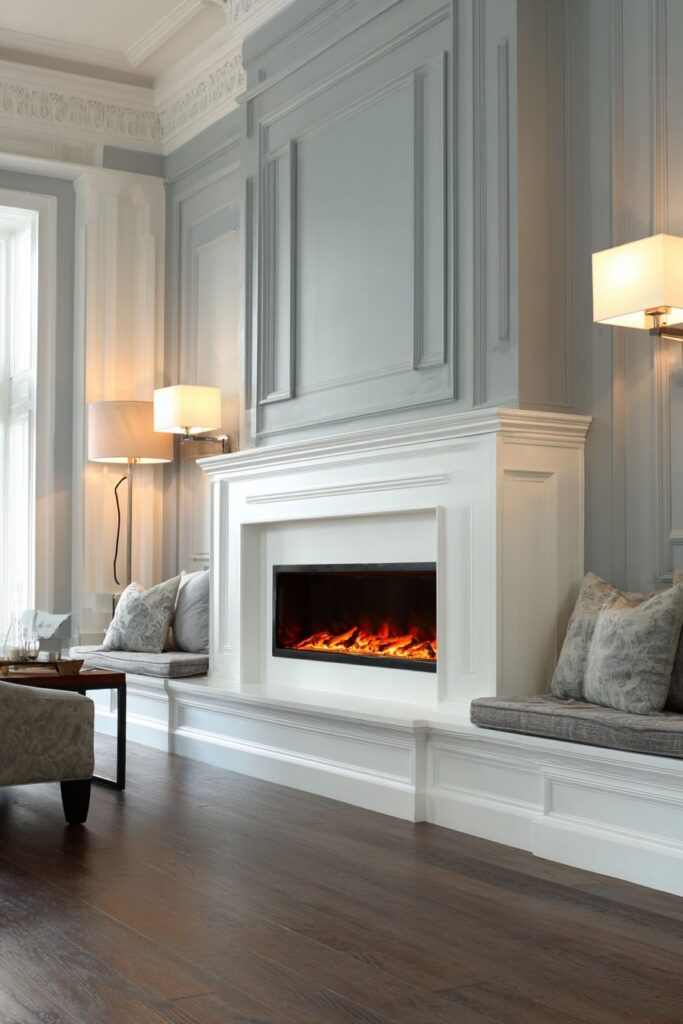
Built-in seating with plush upholstered cushions flanks the fireplace, creating an intimate conversation area that maximizes both seating and visual appeal. These custom seating solutions serve multiple purposes: they provide additional seating, create storage opportunities, and contribute to the room’s symmetrical composition. The upholstered cushions can be updated seasonally or as style preferences evolve, making this a practical long-term design investment.
Modern floor lamps positioned strategically throughout the space provide essential task lighting while contributing to the room’s contemporary elements. These sleek lighting solutions offer adjustable illumination for reading or other activities while their clean lines complement the linear fireplace insert. The floor lamps’ mobility allows for flexible lighting arrangements as the room’s function changes throughout the day.
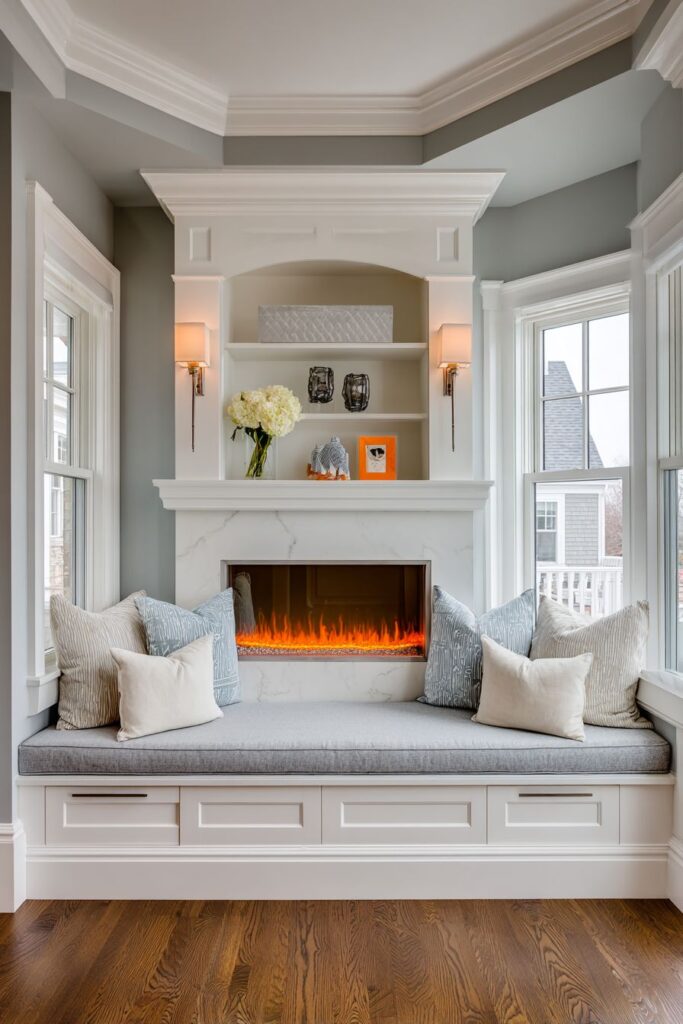
The soft gray paint color with crisp white trim work creates a sophisticated backdrop that allows both traditional and contemporary elements to shine. This neutral palette provides the perfect foundation for introducing color through accessories, artwork, or textiles while ensuring the room maintains its timeless appeal. The gray and white combination offers sufficient contrast to highlight architectural details without overwhelming the space.
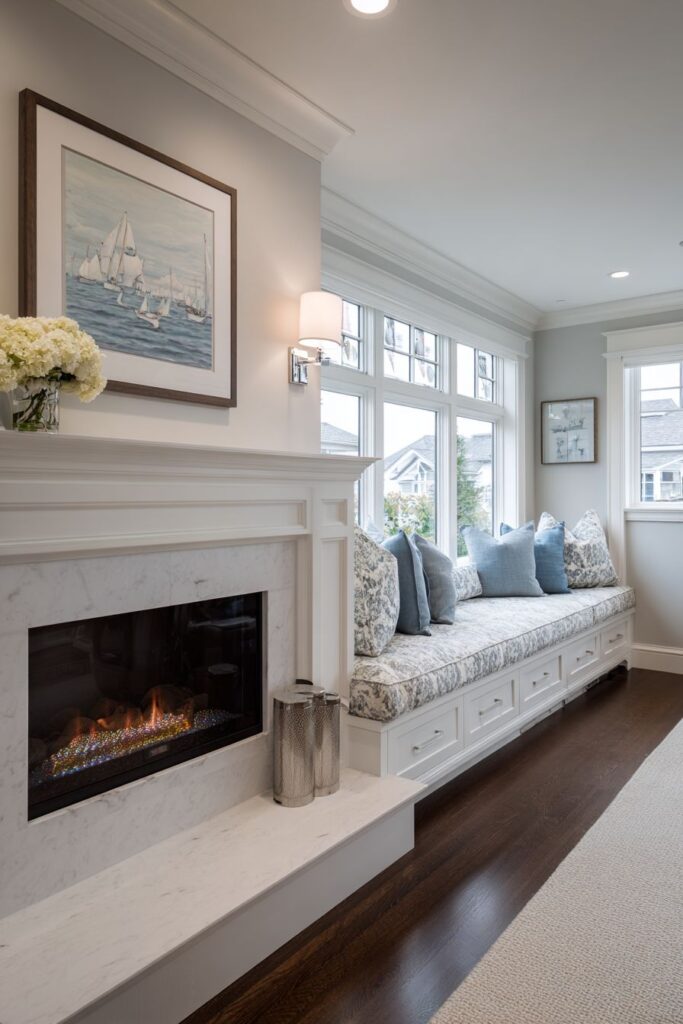
Successful fireplace area integration requires selecting electric or gas fireplace inserts with clean lines that complement traditional mantels, incorporating built-in seating that provides both function and visual balance around the focal point, using modern floor lamps to provide flexible task lighting without compromising the traditional architecture, choosing neutral paint colors that highlight both contemporary and traditional elements, and ensuring all technology integration maintains the room’s sophisticated aesthetic appeal.
5. Comfortable Sectional with Rustic Accents
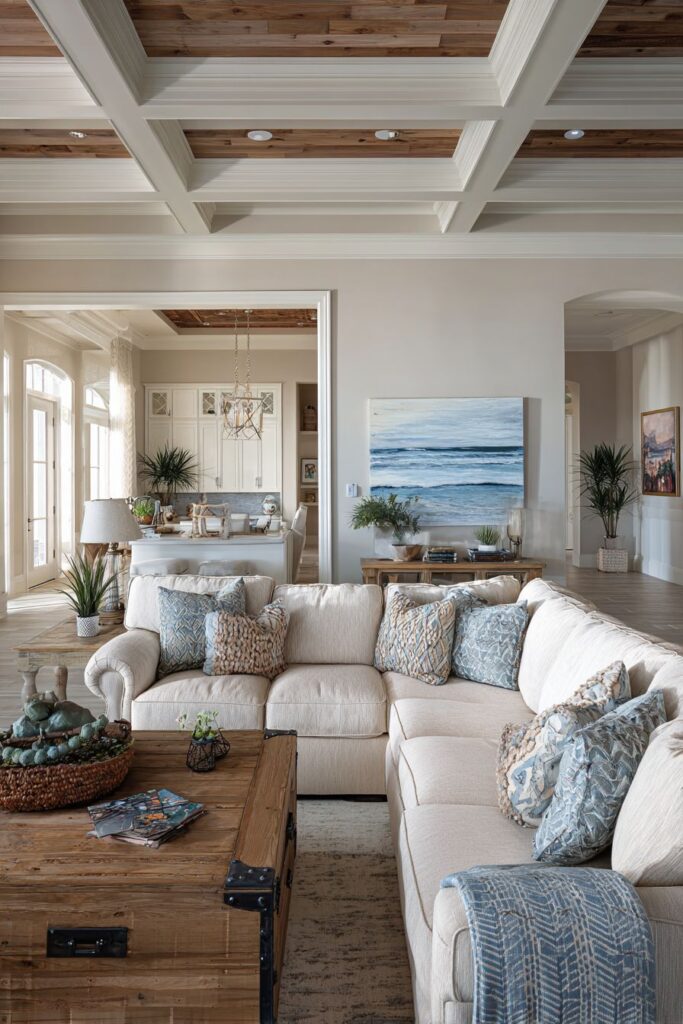
This inviting transitional living room showcases how comfortable contemporary seating can be perfectly paired with rustic natural elements to create a space that feels both current and warmly traditional. The cream fabric sectional with classic track arms provides generous seating while maintaining clean lines that speak to contemporary sensibilities. The track arm detail offers a simplified alternative to rolled arms while still providing the structured appearance that anchors transitional design.
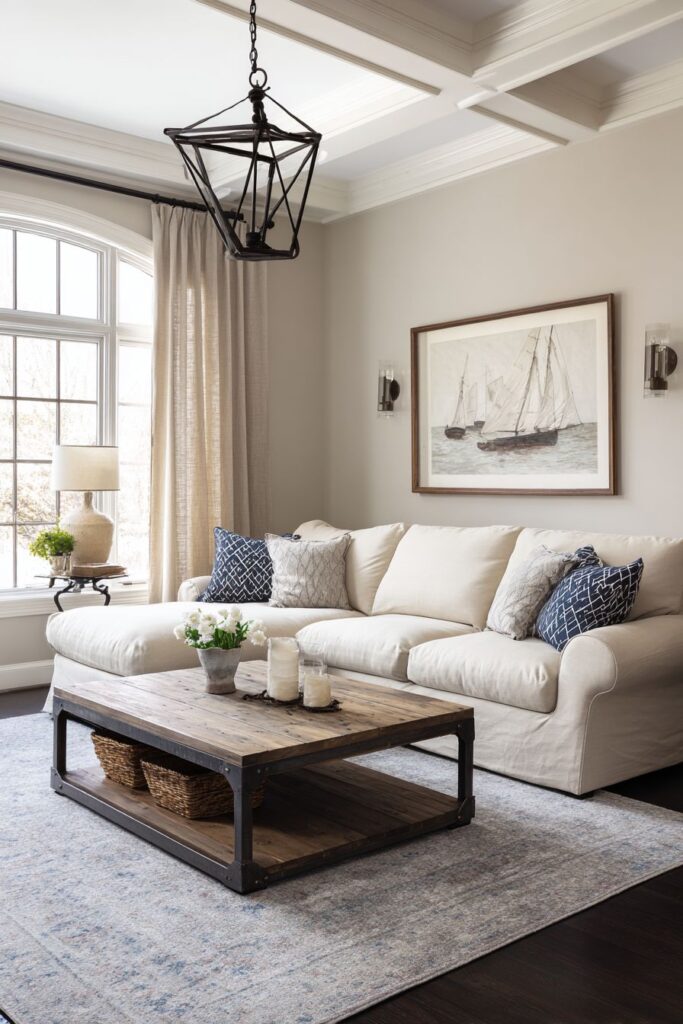
The rustic wood coffee table with metal accents becomes the room’s centerpiece, bringing natural texture and industrial elements into the sophisticated space. The combination of weathered wood and metal hardware creates visual interest while providing a sturdy, functional surface for daily use. This piece demonstrates how rustic elements can be incorporated into transitional design without overwhelming the space’s refined atmosphere.
Traditional architectural elements including crown molding and rich hardwood floors provide the classic foundation that allows contemporary furnishings to feel grounded and appropriate. These established architectural features speak to the room’s traditional heritage while their clean lines and neutral finishes ensure they complement modern furniture choices. The hardwood floors’ warm brown tones create a beautiful contrast with the cream sectional and neutral wall colors.
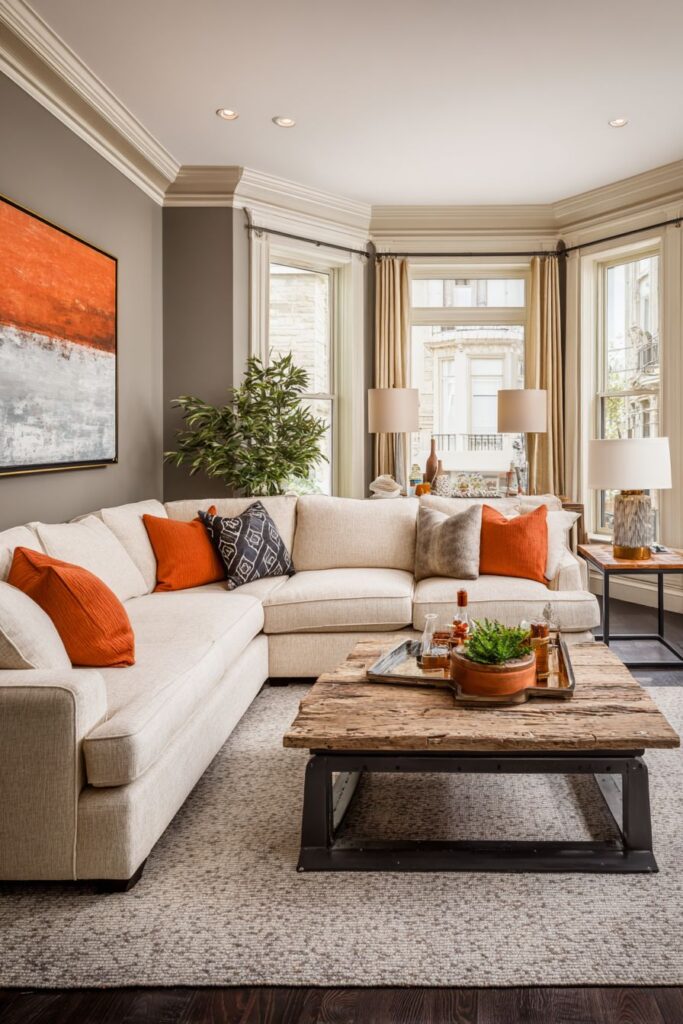
Contemporary geometric throw pillows and modern artwork introduce current design trends without overwhelming the room’s traditional foundation. These smaller elements can be easily updated as styles change, making them perfect vehicles for incorporating seasonal colors or trending patterns. The geometric pillows add visual texture and interest to the sectional while the modern artwork provides focal points that energize the overall composition.
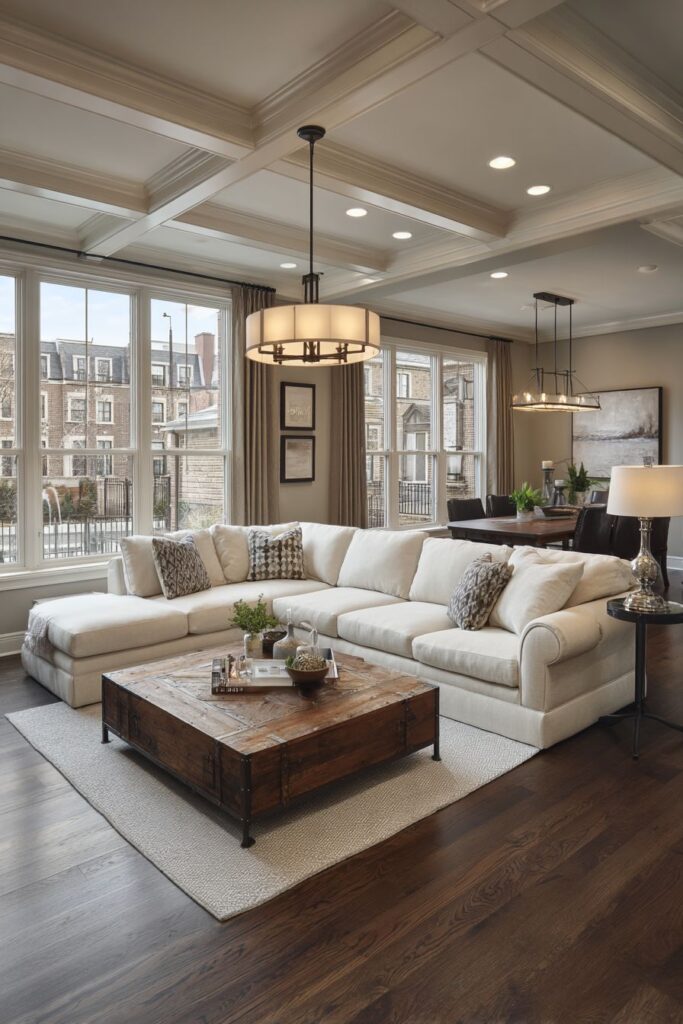
Essential elements for balancing comfort with style include choosing sectional seating with clean-lined arms like track arms for contemporary appeal within traditional proportions, incorporating rustic wood pieces with metal accents to add natural texture and industrial elements, maintaining traditional architectural features like crown molding and hardwood floors as foundational elements, using contemporary accessories like geometric pillows and modern artwork for easy style updates, and creating layered lighting with both recessed and traditional table lamps for functional flexibility.
6. Entertainment Center Excellence
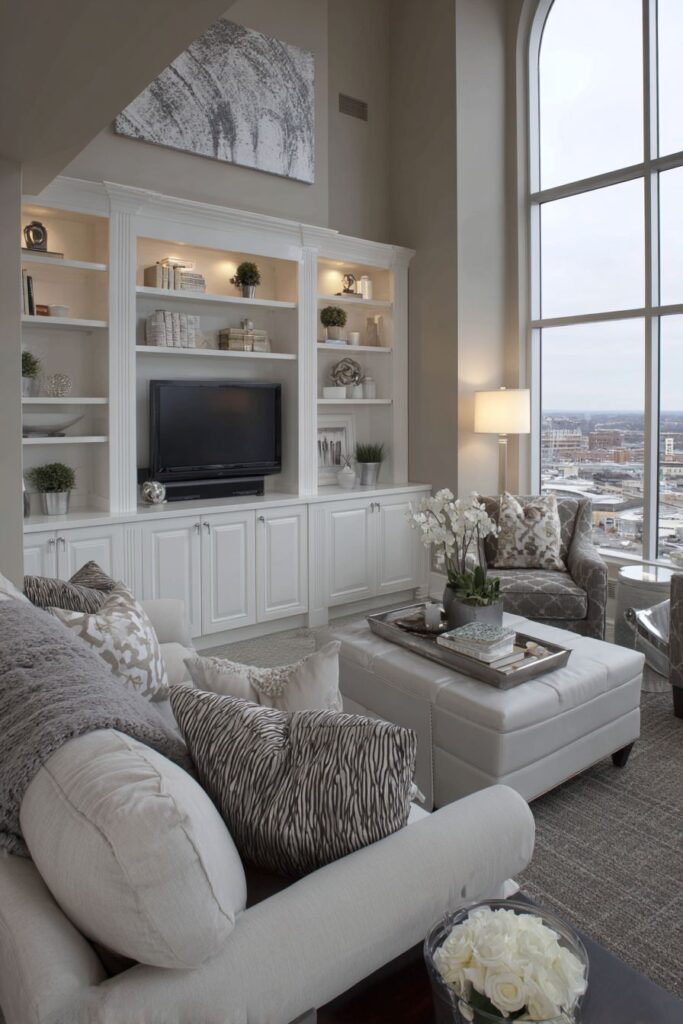
This sophisticated transitional living room demonstrates how traditional built-in cabinetry can successfully house modern entertainment technology while maintaining the room’s refined aesthetic appeal. The custom entertainment center features classic raised panel doors painted in clean white, creating substantial storage that conceals modern flat-screen televisions and contemporary media components. This approach allows technology to remain functional while preserving the room’s traditional design integrity.
The rolled-arm sofa in neutral fabric provides comfortable seating positioned for optimal television viewing while maintaining the classic silhouette that defines traditional furniture design. The neutral upholstery ensures the sofa remains versatile as technology and entertainment needs evolve, while the rolled arms add the refined detailing that elevates the piece beyond simple contemporary seating.
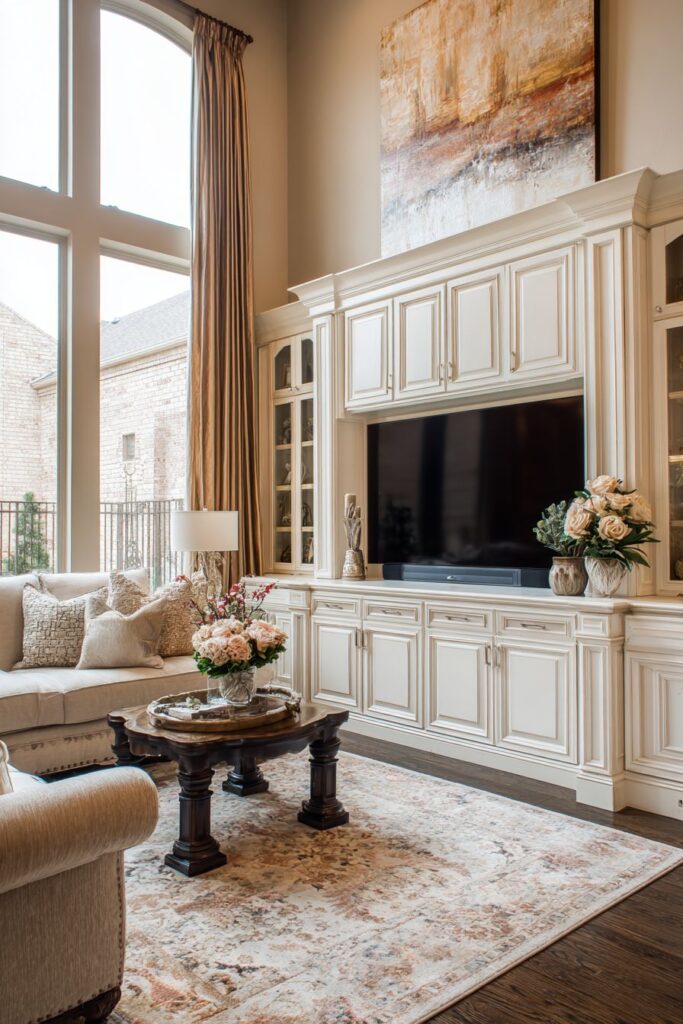
Modern accent tables introduce contemporary materials and clean lines that complement the traditional sofa without competing for visual attention. These sleek pieces provide essential surface space for remotes, beverages, or decorative objects while their minimal profiles ensure they don’t overwhelm the room’s traditional proportions. The tables’ contemporary styling helps bridge the gap between traditional furniture and modern technology.
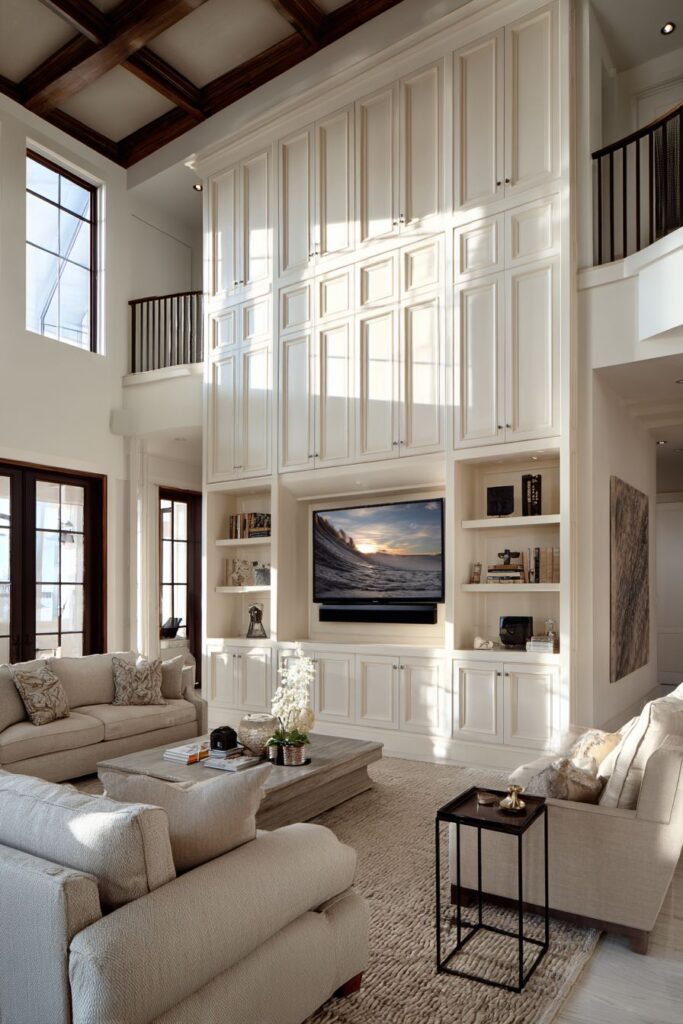
Abstract wall art adds contemporary visual interest and helps balance the substantial built-in cabinetry. These artistic elements introduce color, pattern, or texture that energizes the space while demonstrating how modern art can enhance rather than clash with traditional architectural features. The artwork’s placement above or around the entertainment center creates visual flow and prevents the technology area from feeling purely functional.
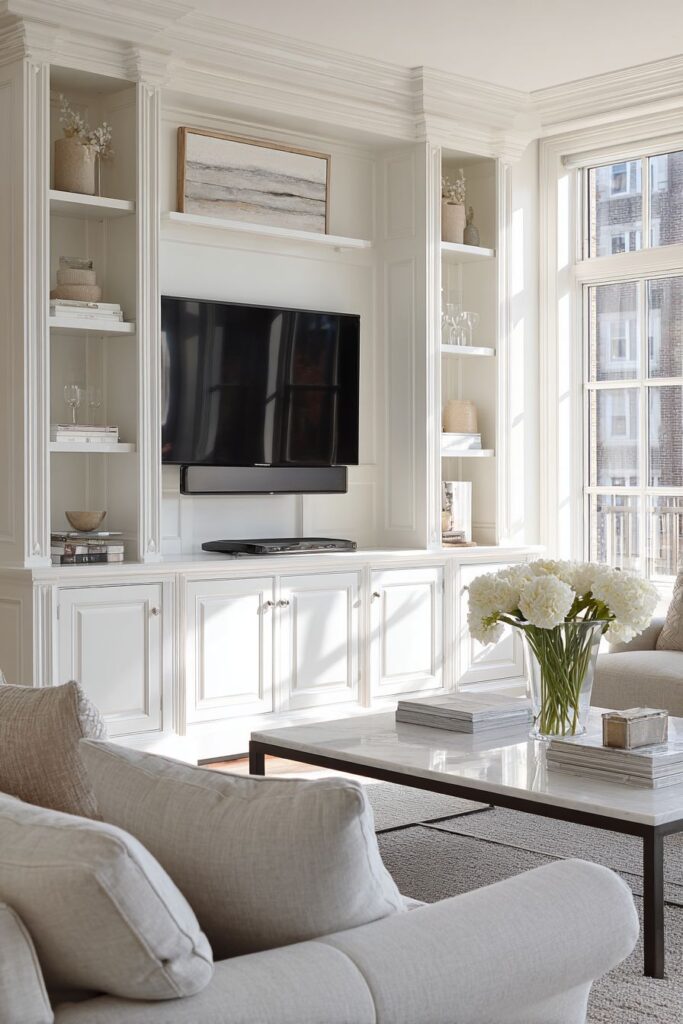
Successful entertainment integration strategies include designing built-in cabinetry with traditional details like raised panels to conceal modern technology, selecting comfortable seating with classic silhouettes positioned for optimal viewing angles, incorporating contemporary accent tables that provide function without visual competition, using abstract artwork to energize traditional built-in features and create visual balance, and ensuring natural light placement complements both traditional architecture and screen viewing needs.
7. Cozy Reading Nook Perfection
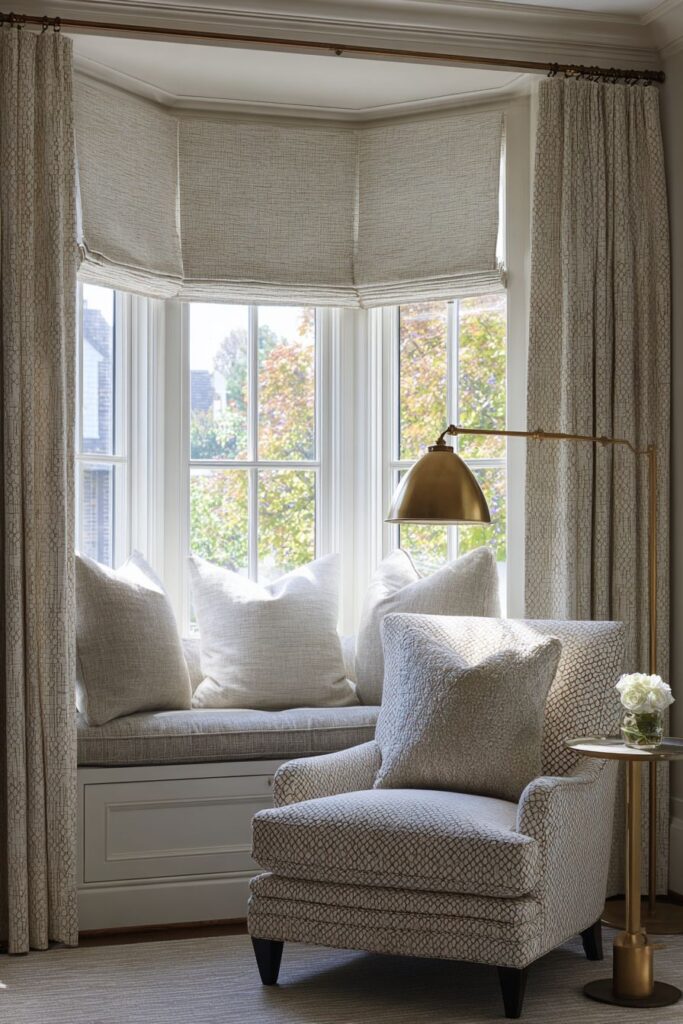
This charming transitional living room features a dedicated reading nook that exemplifies how traditional comfort can be enhanced with contemporary style updates. Positioned near large windows to capture natural light, the space centers around a classic wingback chair that has been reupholstered in a contemporary geometric pattern fabric. This update demonstrates the transitional approach of maintaining beloved traditional furniture forms while refreshing them with current materials and patterns.
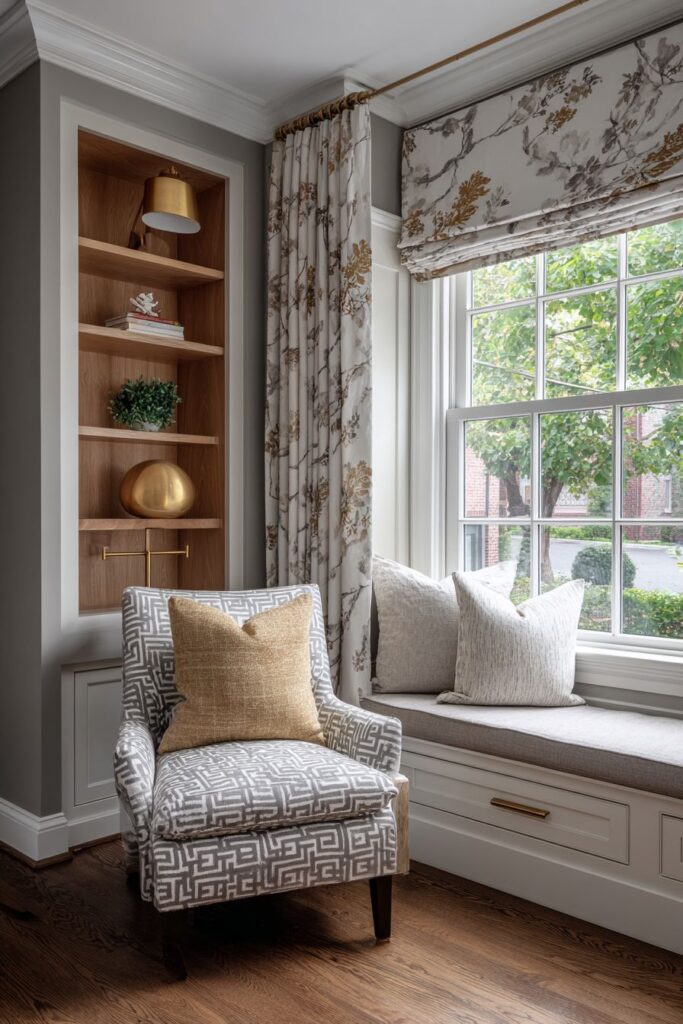
The geometric pattern fabric choice brings contemporary visual interest to the traditional wingback silhouette while maintaining the chair’s inherent comfort and classic proportions. This reupholstery approach allows homeowners to preserve quality traditional furniture pieces while adapting them to current style preferences. The pattern adds energy and personality to the reading area while the wingback design provides the essential back support for extended reading sessions.
A modern side table positioned beside the chair provides essential surface space for books, beverages, or reading glasses while its clean lines complement the chair’s updated upholstery. The table’s contemporary styling creates visual balance with the traditional chair form, ensuring neither element overwhelms the composition. The surface height is carefully proportioned to work comfortably with the wingback chair’s arm height.
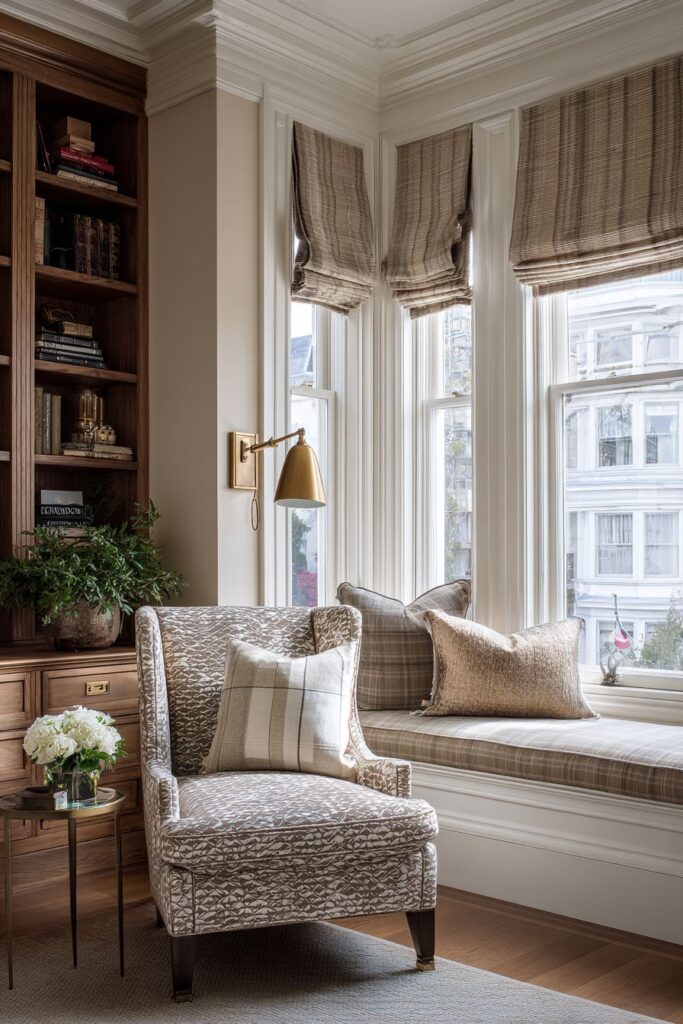
The classic brass reading lamp receives a modern update with LED technology, combining traditional aesthetic appeal with contemporary energy efficiency and functionality. This lamp choice demonstrates how traditional lighting forms can be enhanced with modern technology without sacrificing their classic appearance. The brass finish provides warmth and richness while the LED technology ensures optimal reading illumination with reduced energy consumption.
A built-in window seat with storage combines traditional woodwork with modern functionality, providing additional seating and hidden storage for books, throws, or seasonal items. This custom feature maximizes the space’s potential while maintaining the room’s refined appearance. The storage capability addresses modern organizational needs while the traditional woodwork details ensure architectural consistency.
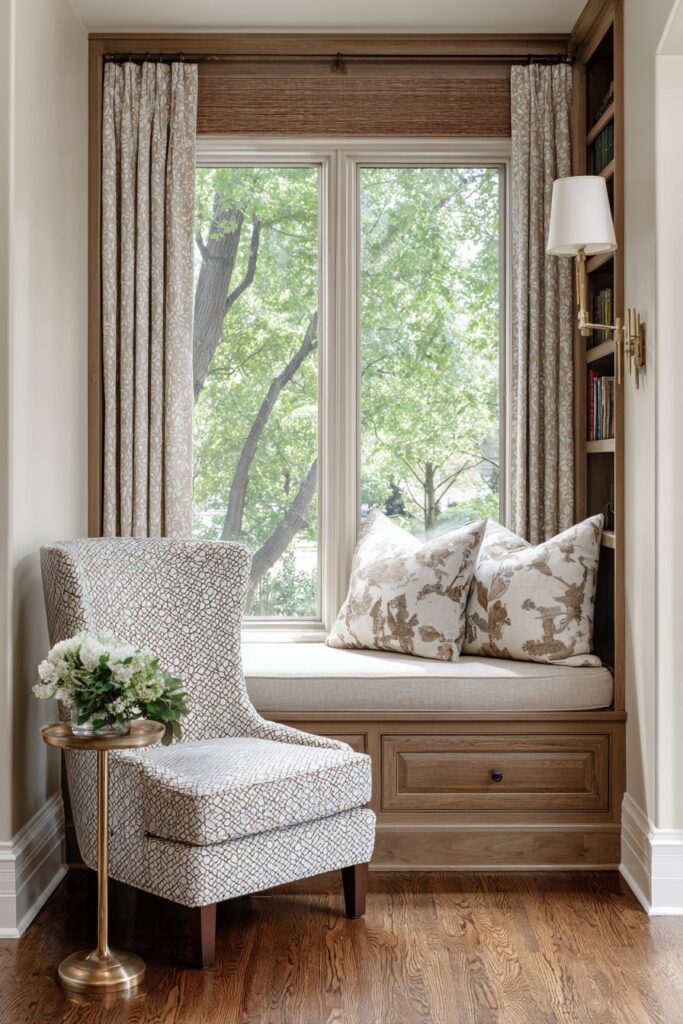
Creating an effective reading nook requires positioning seating near natural light sources for comfortable daytime reading, updating traditional furniture with contemporary fabrics to bridge style eras, incorporating modern side tables that complement rather than compete with traditional seating, selecting classic lighting forms enhanced with modern technology for both style and function, and adding built-in storage solutions that provide organization while maintaining traditional craftsmanship details.
8. Formal Elegance with Contemporary Balance
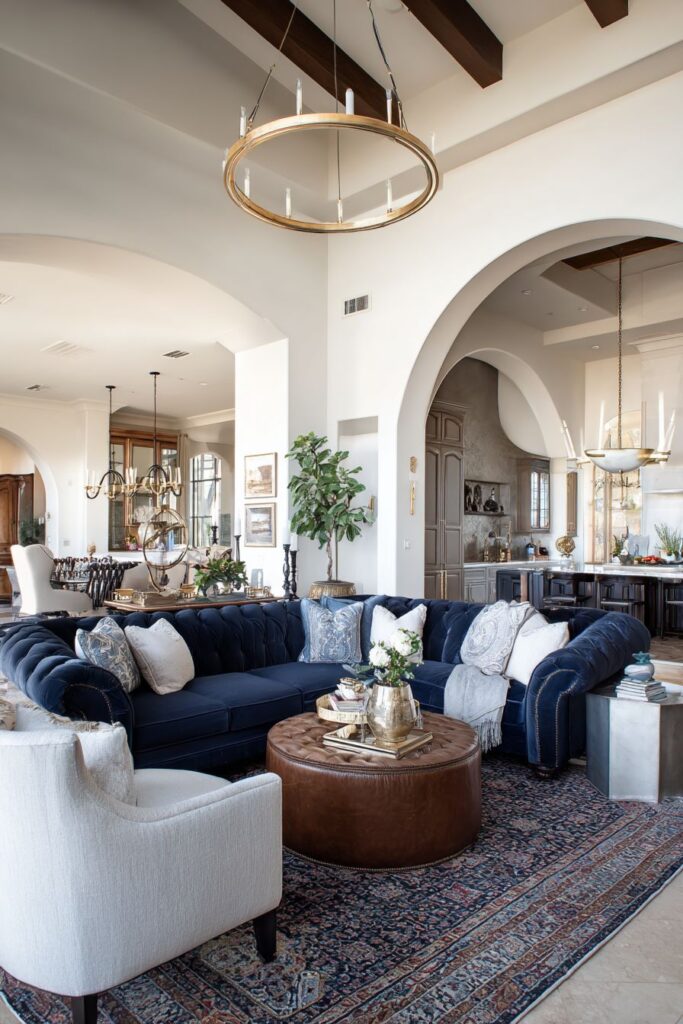
This sophisticated transitional living room presents a masterful study in formal seating arrangements where traditional elegance meets contemporary comfort. The camelback sofa in rich navy blue serves as the room’s anchor piece, its classic curved silhouette and deep jewel tone bringing immediate sophistication and traditional gravitas to the space. The camelback design represents one of furniture’s most enduring traditional forms, while the navy blue upholstery provides timeless color that works beautifully with both traditional and contemporary accent pieces.
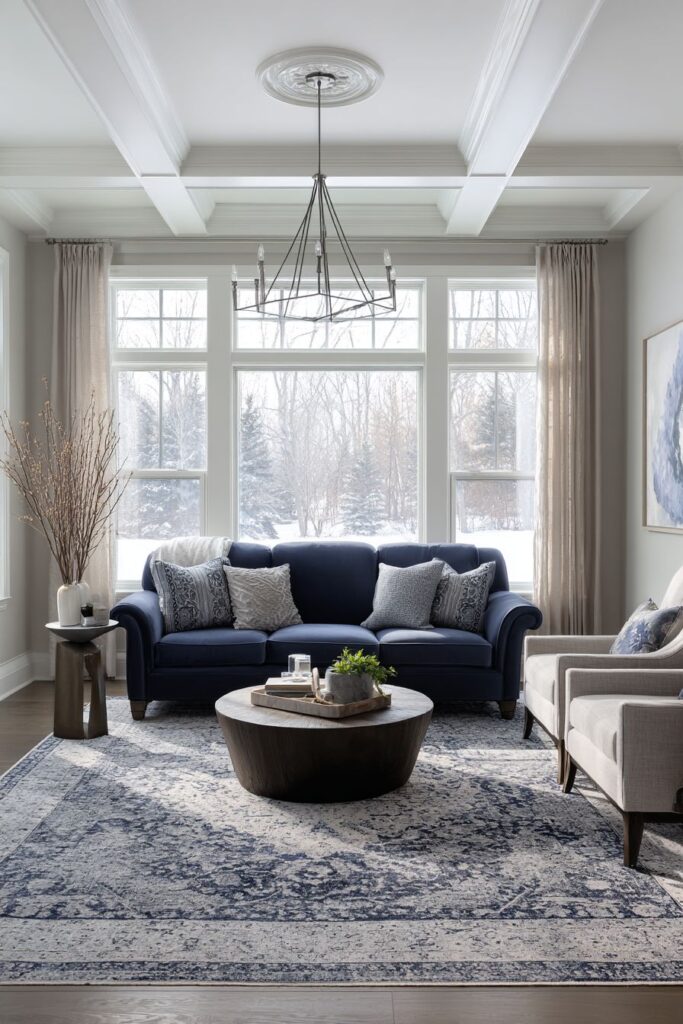
Modern accent chairs in complementary neutral tones provide additional seating while introducing contemporary proportions and clean lines that balance the sofa’s traditional curves. These chairs demonstrate how contemporary furniture can enhance rather than compete with traditional pieces when chosen in harmonious colors and appropriate scales. The neutral tones ensure the chairs remain versatile as color preferences evolve while providing visual rest areas that prevent the room from feeling overwhelming.
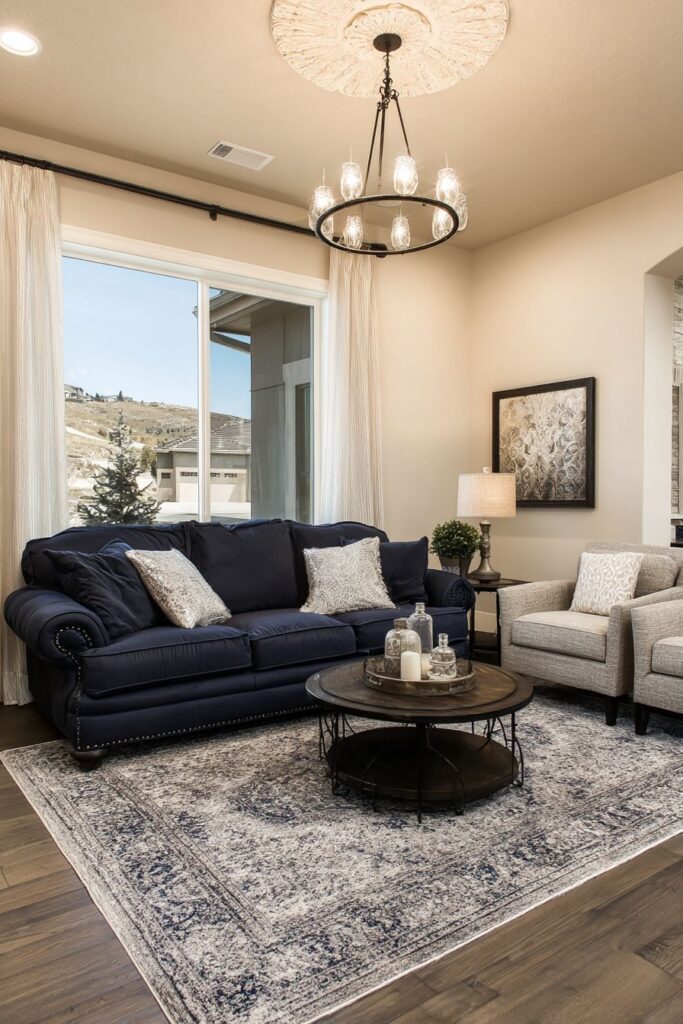
The classic Persian rug with traditional patterns serves as the foundation that anchors all furniture pieces while adding pattern, texture, and color to the floor plane. Persian rugs represent centuries of traditional craftsmanship and design, making them perfect transitional elements that bring history and beauty to contemporary spaces. The rug’s traditional patterns complement the camelback sofa’s classic styling while its colors tie together all the seating elements.
A traditional ceiling medallion houses a modern chandelier with clean lines, creating an unexpected but successful pairing that exemplifies transitional design principles. The ornate ceiling medallion honors traditional architectural details while the contemporary chandelier provides current styling and efficient illumination. This combination demonstrates how traditional architectural features can successfully frame modern lighting solutions.
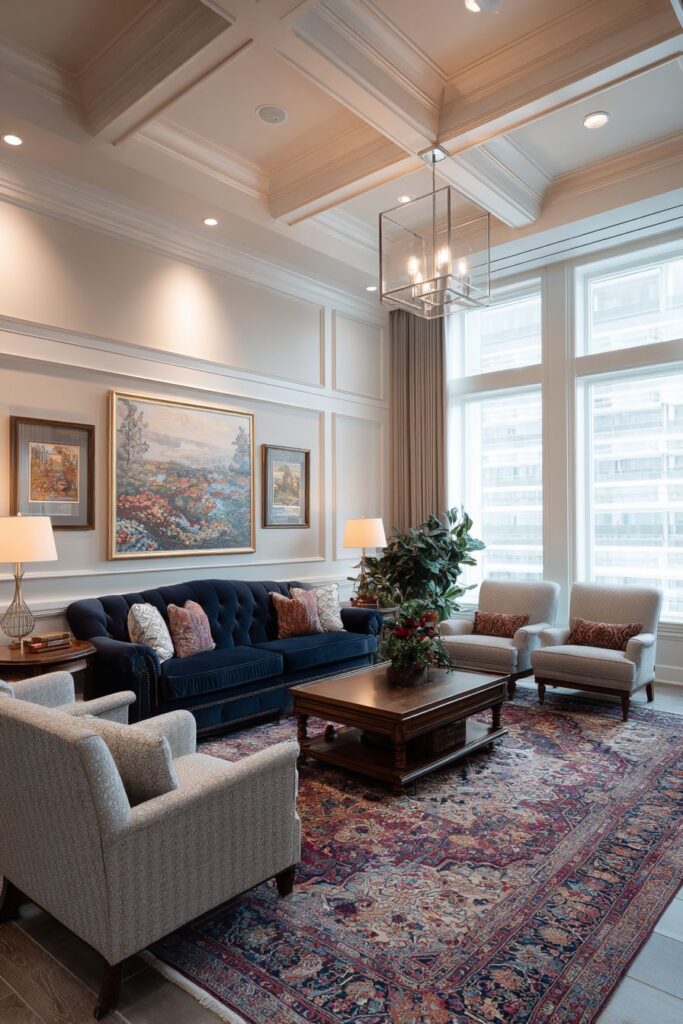
Achieving formal elegance with contemporary balance requires selecting traditional seating forms like camelback sofas in rich, timeless colors for sophisticated anchoring, incorporating contemporary accent seating in neutral tones that complement rather than compete with traditional pieces, using classic Persian or traditional rugs to unify different furniture styles and add foundational pattern, combining traditional architectural details like ceiling medallions with contemporary light fixtures for unexpected sophistication, and maintaining professional lighting that highlights both traditional craftsmanship and contemporary clean lines.
9. Open Concept Traditional Details
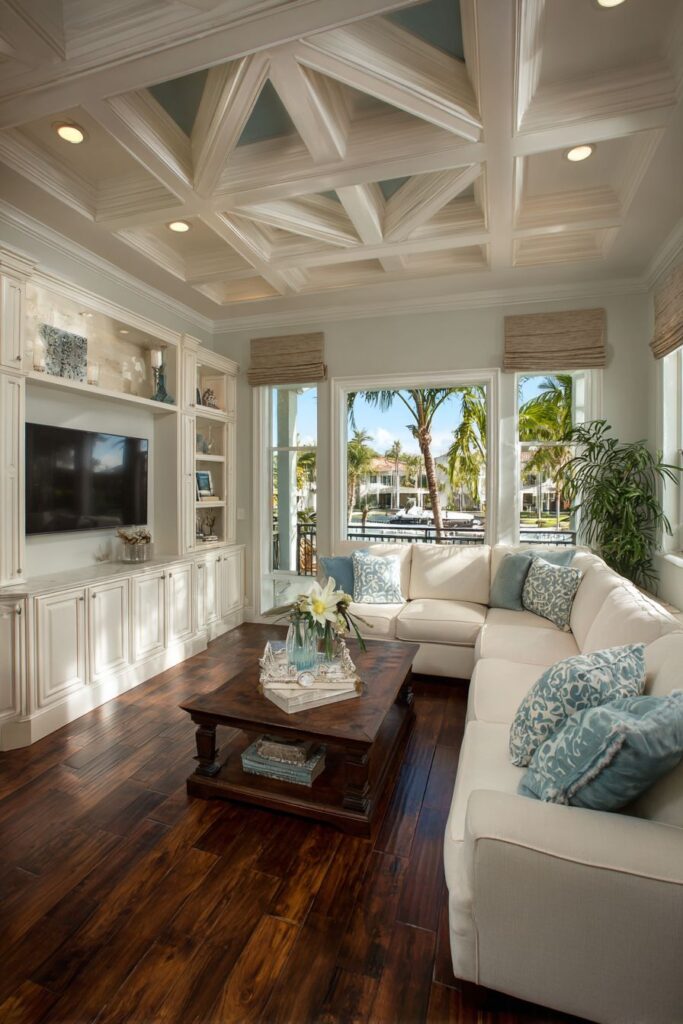
This spacious transitional living room showcases how traditional architectural details can enhance open concept design without overwhelming the contemporary lifestyle benefits of fluid, connected spaces. The coffered ceiling painted in clean white creates visual interest and architectural distinction while maintaining the bright, airy feeling essential to successful open concept living. These traditional ceiling details add character and sophistication while their white finish ensures they enhance rather than darken the space.
The low-profile sectional provides generous seating appropriate for open concept entertaining while its streamlined silhouette maintains the clean lines that prevent the large space from feeling cluttered or overwhelming. This contemporary seating choice demonstrates how modern furniture proportions can work beautifully within spaces enhanced by traditional architectural details. The sectional’s low profile ensures sight lines remain open throughout the connected living areas.
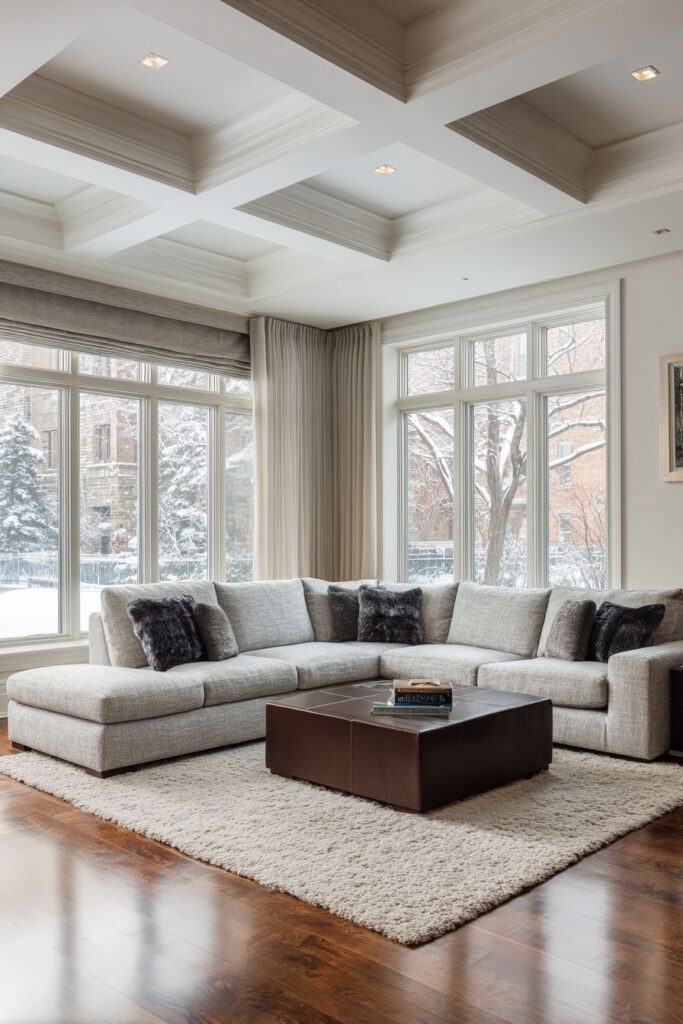
A contemporary coffee table with minimal styling complements the sectional’s clean lines while providing essential functionality for the large seating arrangement. The table’s understated design ensures it doesn’t compete with the elaborate ceiling details while offering adequate surface space for the sectional’s substantial seating capacity. The contemporary styling bridges the gap between traditional architecture and modern furniture.
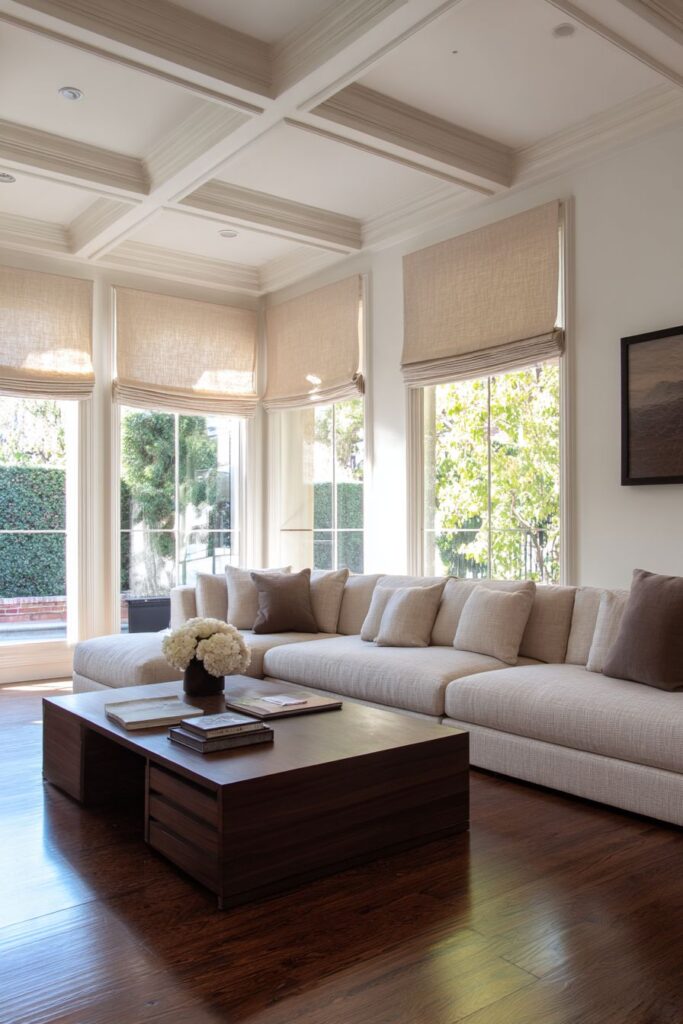
Classic hardwood floors in rich brown tones provide warmth and traditional appeal while their natural beauty complements both architectural details and contemporary furnishings. Hardwood floors represent a timeless flooring choice that works equally well with traditional and contemporary design elements. The rich brown tones add depth and warmth to the large space while providing durable functionality for high-traffic open concept areas.
Large windows with simple Roman shades maximize natural light while maintaining clean lines that complement the contemporary furniture. The Roman shades provide privacy and light control when needed while their simple styling doesn’t compete with the room’s architectural details. The window treatments’ neutral color palette ensures they enhance rather than detract from the overall design composition.
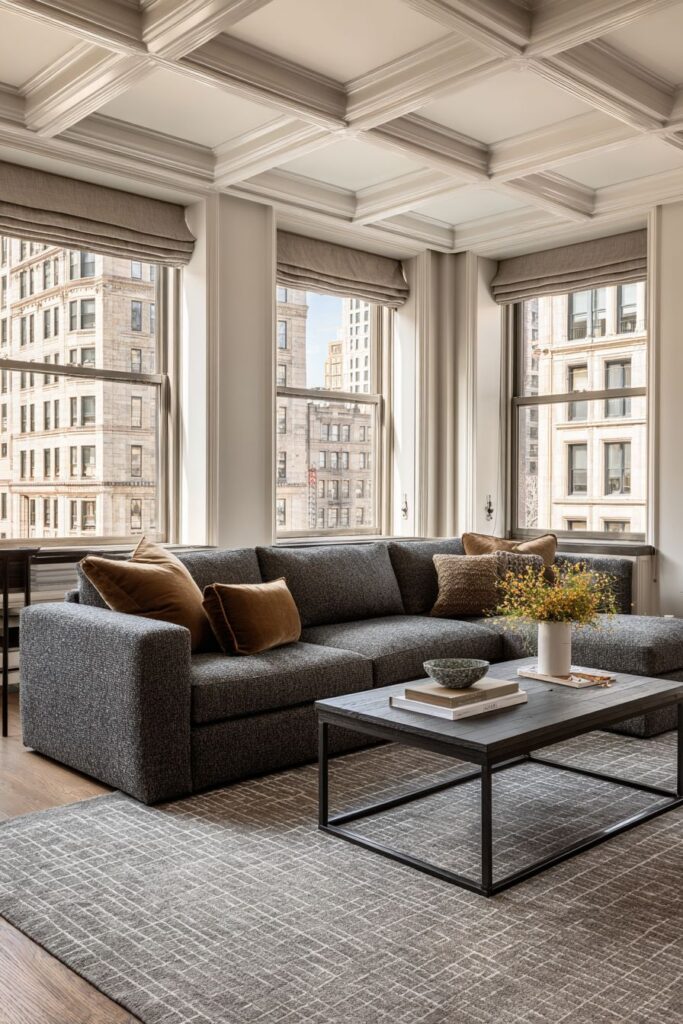
Successful open concept integration requires using traditional architectural details like coffered ceilings to add character without overwhelming open spaces, selecting low-profile contemporary seating that maintains sight lines while providing adequate capacity, incorporating understated coffee tables that provide function without visual competition, choosing classic hardwood floors that complement both traditional architecture and contemporary furniture, and utilizing simple window treatments that maximize natural light while maintaining clean aesthetic lines.
10. Productive Workspace Integration
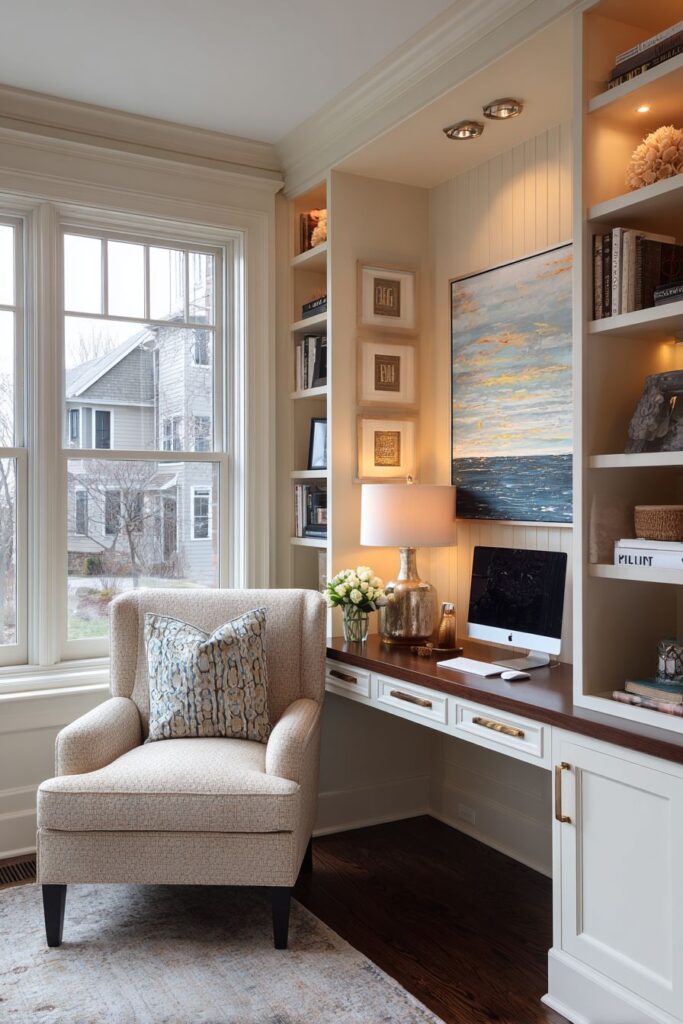
This thoughtfully designed transitional living room incorporates a dedicated workspace corner that seamlessly blends traditional craftsmanship with contemporary work-from-home functionality. The built-in desk features traditional raised panel details that maintain consistency with the room’s overall design aesthetic while providing a dedicated work surface equipped with modern technology. This custom solution demonstrates how transitional design can adapt traditional furniture forms to meet contemporary lifestyle needs.
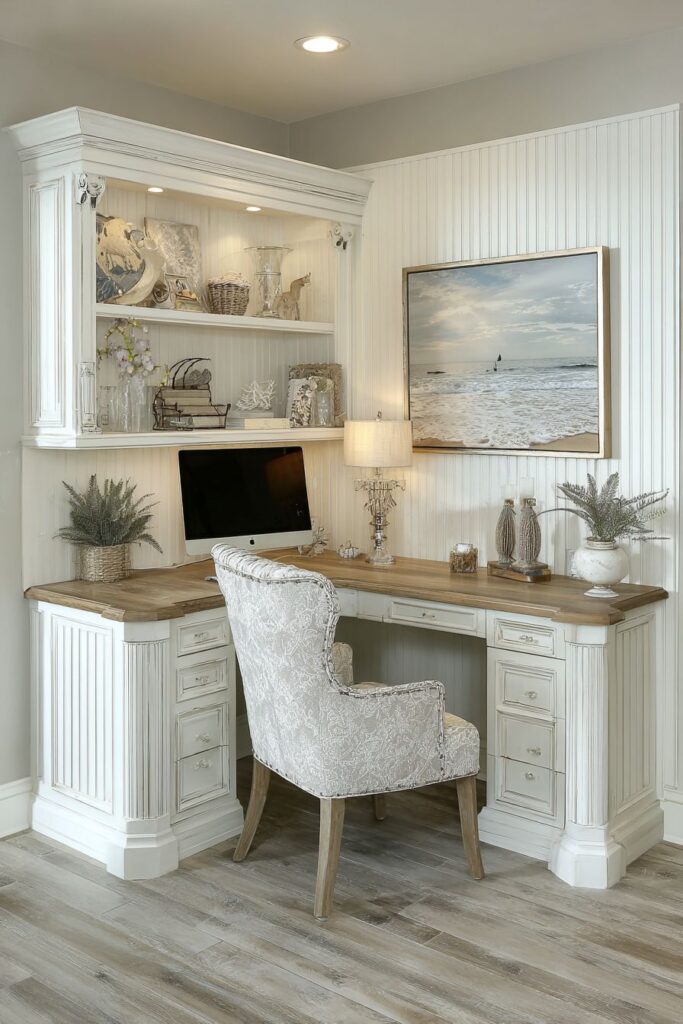
The raised panel details on the built-in desk echo traditional cabinetry styling while the desk’s proportions and functionality address modern work requirements. This approach allows the workspace to feel integrated into the room’s design rather than appearing as an afterthought or purely functional addition. The traditional detailing ensures the workspace maintains the room’s sophisticated aesthetic appeal.
A classic chair silhouette receives contemporary updating through current fabric choices, creating seating that provides both comfort for extended work sessions and visual appeal that complements the traditional desk design. This reupholstering approach demonstrates how traditional furniture forms can be refreshed to meet contemporary needs while maintaining their essential character and proportions.
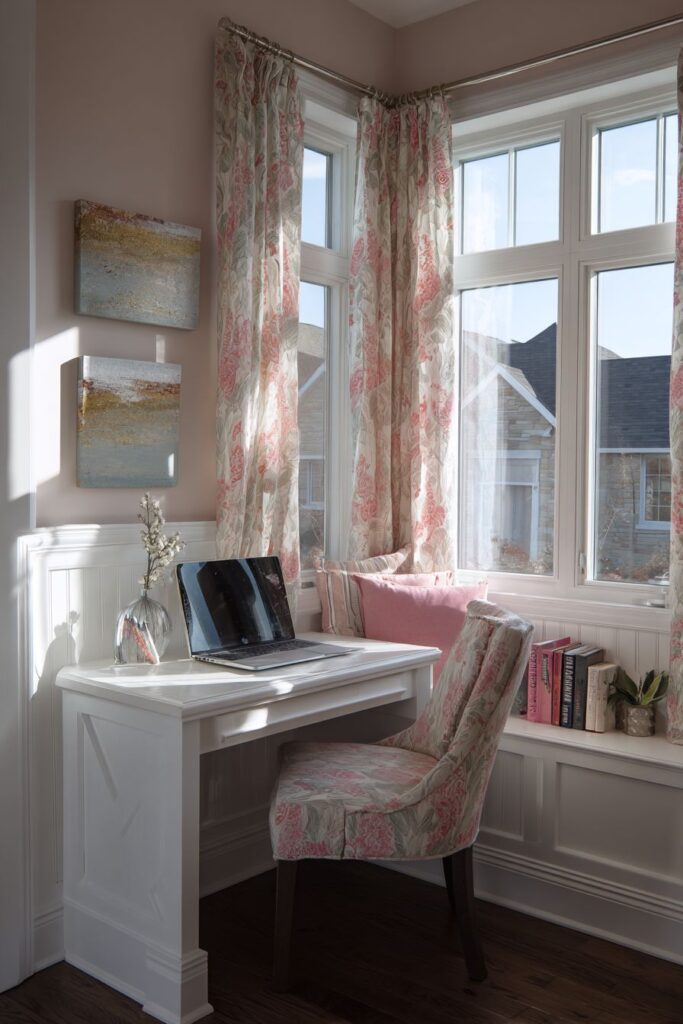
Contemporary task lighting positioned at the workspace ensures optimal illumination for computer work and paperwork while its clean styling complements the traditional desk details. Modern LED task lighting provides the focused illumination essential for productive work while energy-efficient technology reduces operational costs. The lighting’s contemporary design prevents the workspace from feeling dated or purely traditional.
Traditional wainscoting painted in soft colors provides a sophisticated backdrop for modern artwork and accessories, creating visual interest while maintaining the room’s refined atmosphere. The wainscoting adds architectural character and traditional craftsmanship details while its soft color palette ensures it enhances rather than overwhelms the workspace area. This backdrop allows modern accessories to shine while maintaining traditional architectural integrity.
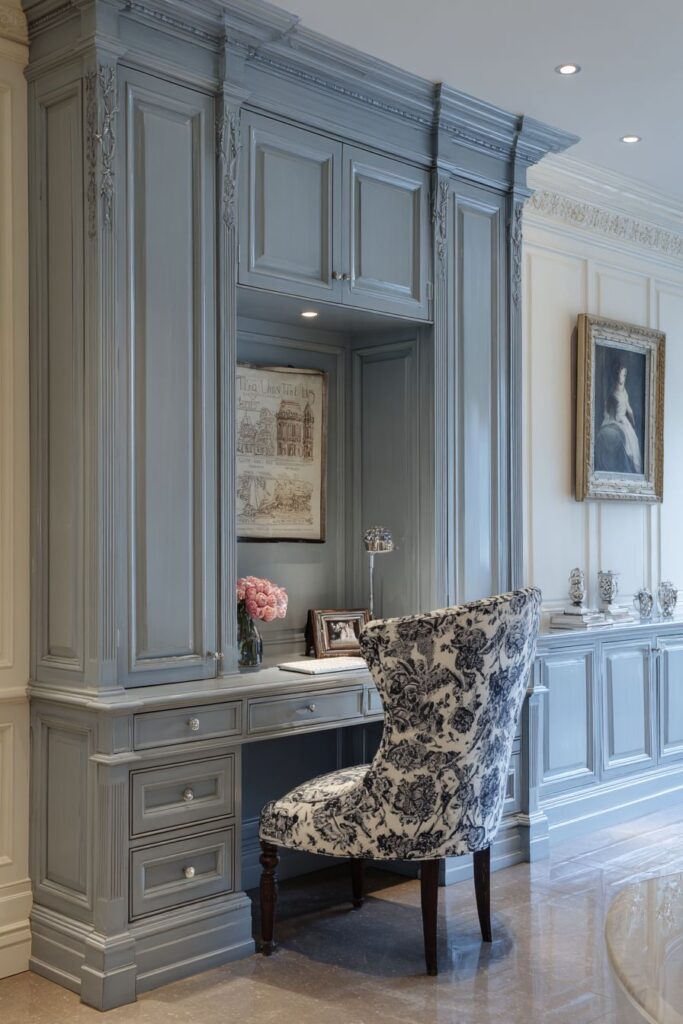
Effective workspace integration strategies include designing built-in desks with traditional details that match the room’s overall aesthetic, selecting classic chair silhouettes updated with contemporary fabrics for comfort and style continuity, incorporating modern task lighting that provides optimal work illumination without compromising design appeal, using traditional architectural details like wainscoting as sophisticated backdrops for contemporary accessories, and ensuring technology integration maintains the room’s refined appearance while providing full functionality.
11. Conversation Area Sophistication
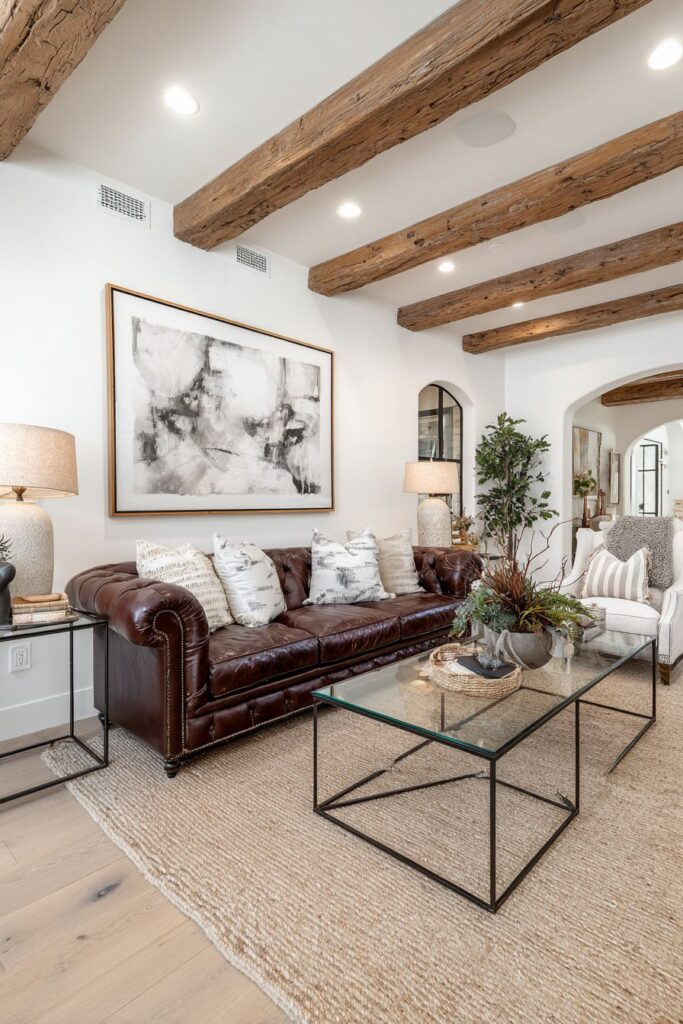
This refined transitional living room creates an intimate conversation area where traditional luxury meets contemporary simplicity in perfect harmony. The rich leather Chesterfield sofa brings immediate gravitas and established elegance to the space, its deeply tufted surface and classic silhouette representing centuries of traditional furniture craftsmanship. The leather upholstery adds both durability and sophisticated aging that improves with time, making it a perfect investment piece for transitional design.
Modern glass and metal side tables provide essential surface space while their transparent and minimal design ensures they don’t compete with the substantial Chesterfield sofa for visual attention. These contemporary pieces demonstrate how modern furniture can enhance traditional elements by providing functional support without visual competition. The glass surfaces reflect light and maintain the space’s open feeling while the metal frameworks introduce industrial materials in an elegant way.
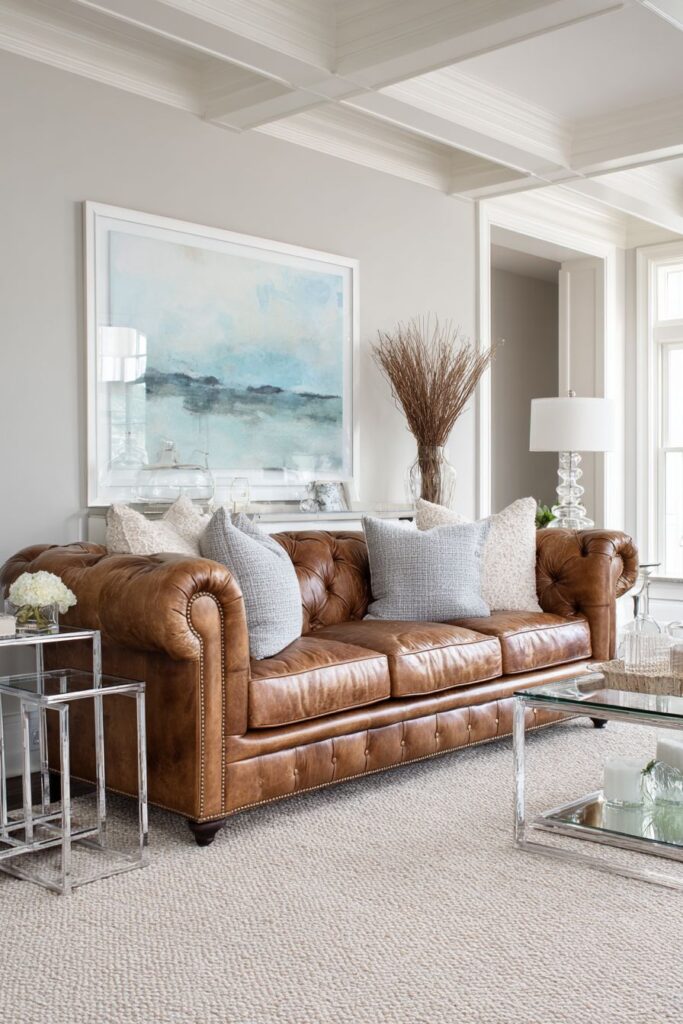
Classic architectural details including decorative ceiling beams painted white add character and traditional craftsmanship without overwhelming the contemporary elements. These structural details create visual interest overhead while their white finish maintains brightness and prevents the space from feeling heavy or dark. The beams add architectural distinction that elevates the entire room’s sophistication level.
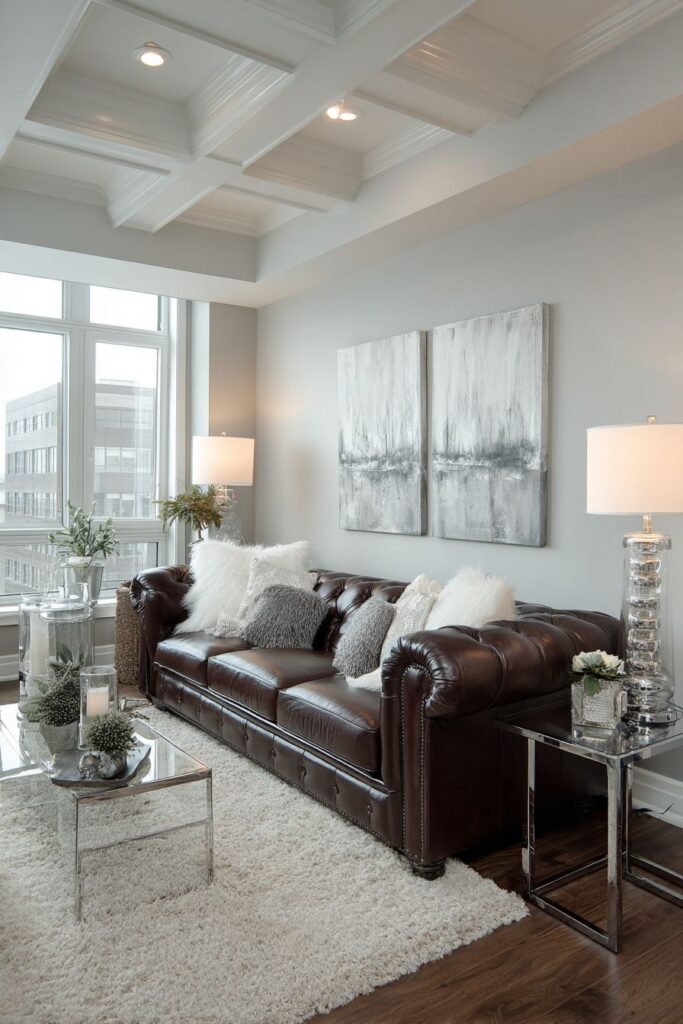
Contemporary abstract artwork provides visual focal points that energize the traditional furniture while sleek floor lamps offer both ambient and task lighting with modern efficiency. The artwork introduces color, pattern, or texture that prevents the traditional elements from feeling static, while the floor lamps provide adjustable illumination that adapts to different activities throughout the day.
A natural jute area rug serves as the perfect bridge between traditional and modern elements, its neutral texture and organic material working equally well with leather furniture and contemporary accessories. Jute provides natural beauty and durability while its neutral tone ensures it complements rather than competes with other design elements.
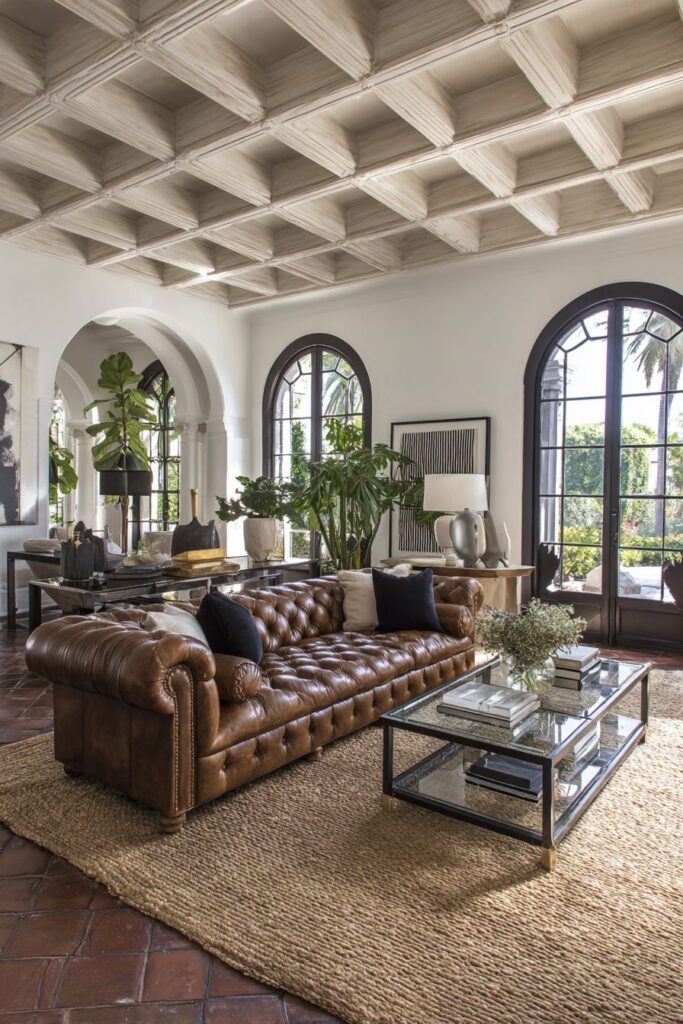
Creating sophisticated conversation areas requires selecting traditional luxury pieces like leather Chesterfield sofas for established elegance and durability, incorporating transparent modern side tables that provide function without visual competition, maintaining architectural details like ceiling beams painted in light colors for character without heaviness, using contemporary artwork and lighting to energize traditional furniture pieces, and choosing natural fiber rugs that bridge traditional and contemporary elements through neutral texture.
12. Formal Dining Integration
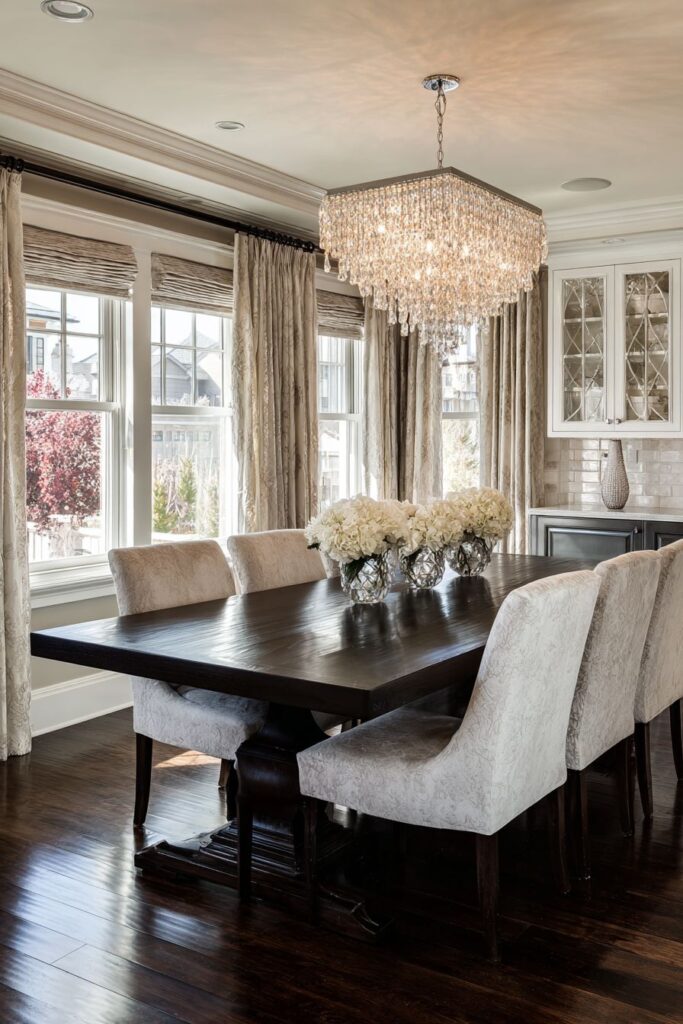
This elegant transitional living room incorporates a formal dining area that demonstrates how traditional dining furniture can coexist beautifully with contemporary design elements while maintaining sophisticated appeal for special occasions and daily use. The traditional pedestal dining table in rich dark wood provides classical elegance and substantial surface space while its timeless silhouette ensures it remains stylistically relevant as trends evolve.
Upholstered dining chairs with contemporary clean lines surround the traditional table, creating an interesting contrast that exemplifies transitional design principles. The chairs’ clean lines prevent the dining area from feeling overly formal or dated while their upholstered seats provide comfort for extended dining experiences. This combination allows the dining area to feel both sophisticated and approachable.
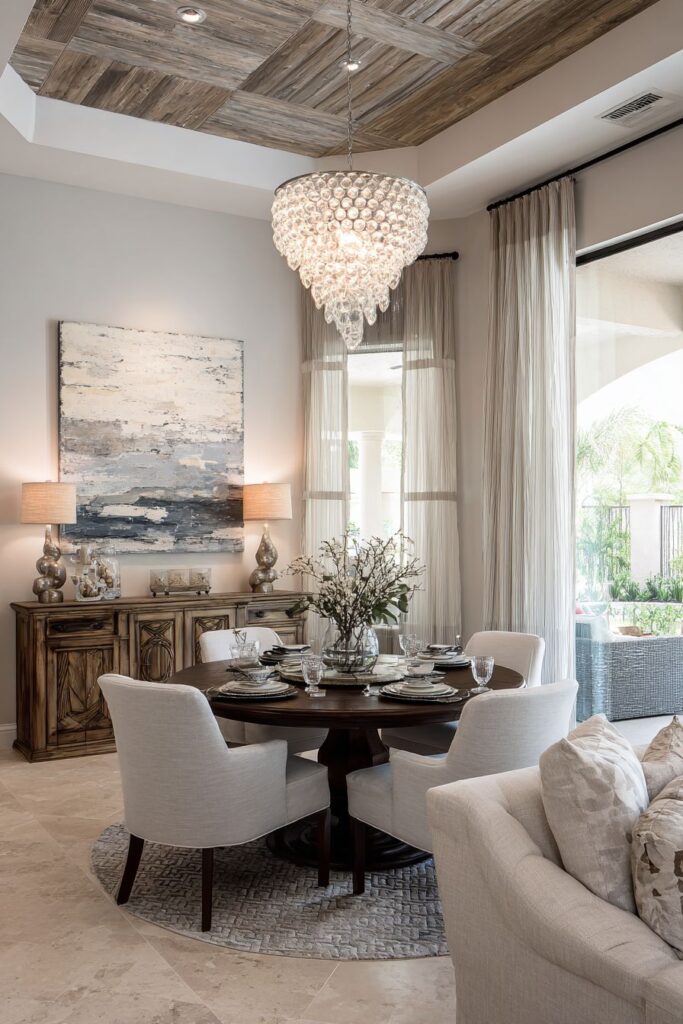
A classic crystal chandelier provides ambient lighting that enhances the formal dining experience while its traditional materials and craftsmanship add sparkle and elegance to the space. Crystal chandeliers represent timeless luxury that works beautifully in transitional settings, providing both functional illumination and decorative appeal. The chandelier’s traditional styling complements the pedestal table while adding vertical interest to the dining area.
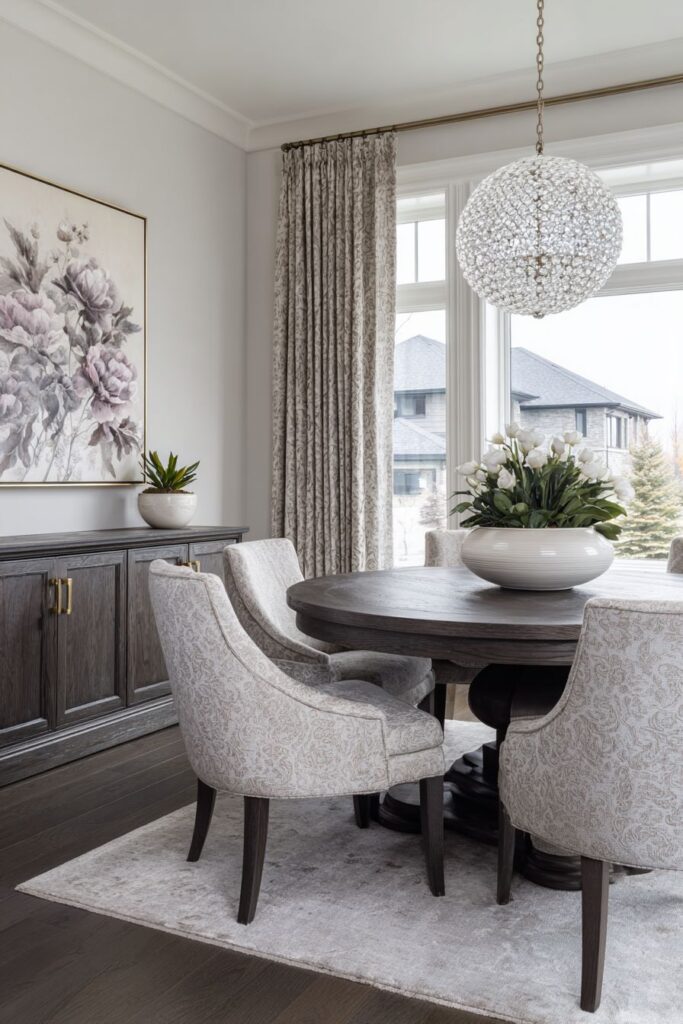
The modern buffet cabinet offers essential storage for dining accessories while its streamlined design provides contemporary balance to the traditional dining table and crystal chandelier. This storage solution addresses practical dining needs while maintaining clean lines that prevent the area from feeling cluttered or overly ornate. The buffet’s modern styling demonstrates how contemporary pieces can successfully support traditional dining arrangements.
Traditional window treatments in neutral fabrics complement both classic and contemporary elements while providing privacy and light control for intimate dining experiences. Neutral fabrics ensure the window treatments enhance rather than compete with the dining furniture while traditional styling maintains consistency with the formal dining arrangement.
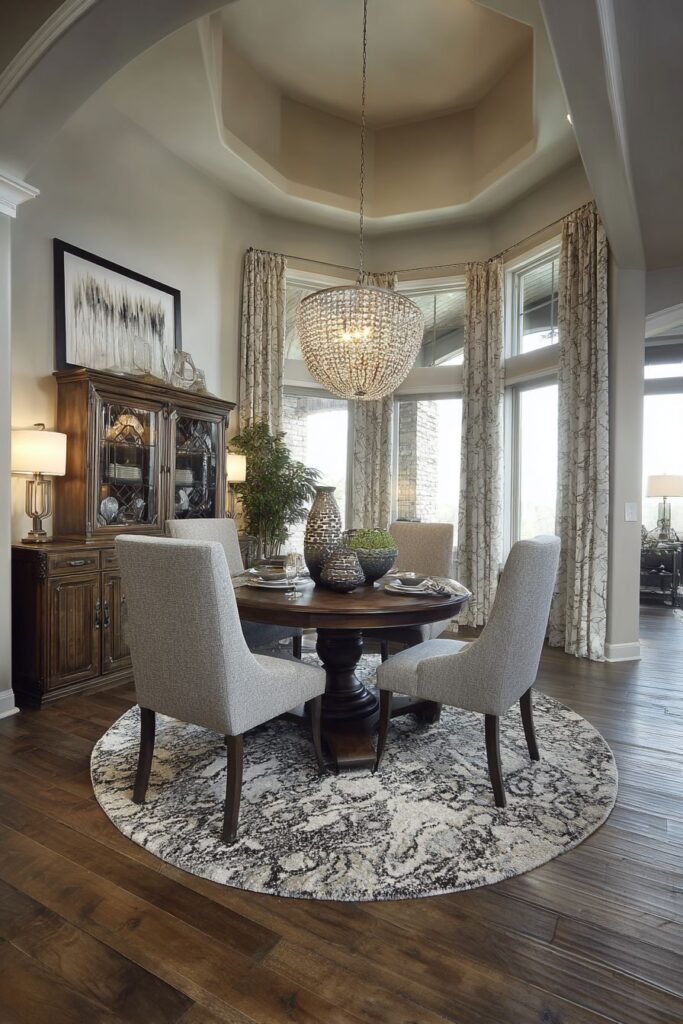
Successful dining area integration requires selecting traditional pedestal tables in rich wood finishes for timeless elegance and substantial presence, incorporating contemporary upholstered chairs that provide comfort while maintaining clean lines, using classic crystal chandeliers for both functional and decorative lighting appeal, adding modern storage pieces like buffets that provide function while maintaining streamlined contemporary design, and choosing neutral window treatments that complement both traditional and contemporary elements while providing necessary privacy and light control.
13. Sectional Arrangement with Geometric Accents
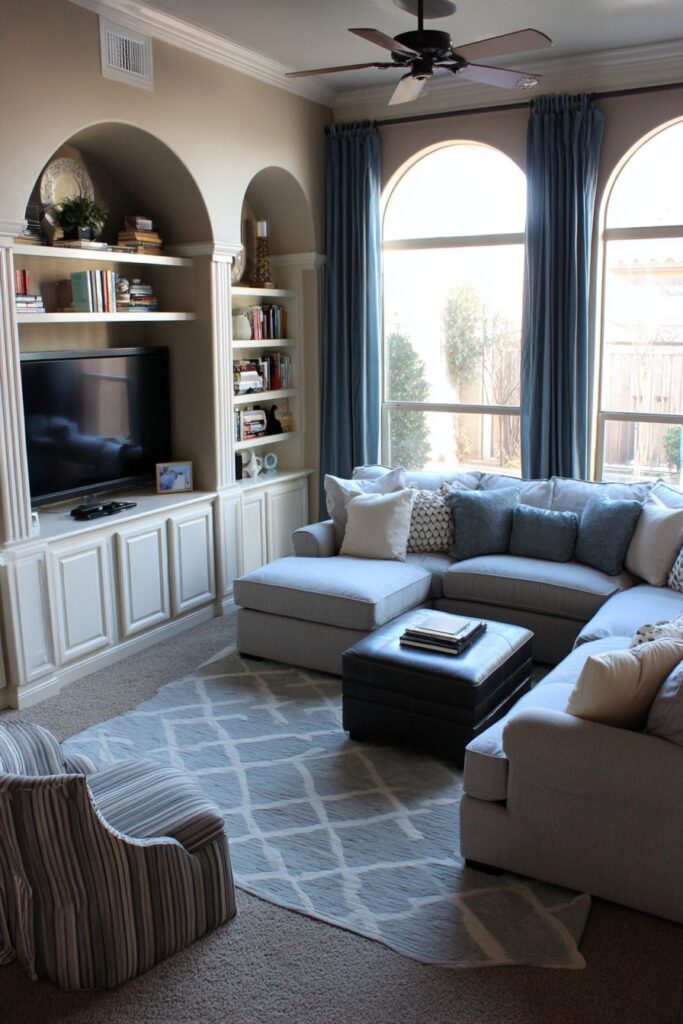
This well-planned transitional living room showcases how sectional seating with traditional details can be enhanced by contemporary accessories to create a space that feels both established and current. The sectional sofa features traditional rolled arms that provide classical detailing while contemporary fabric choices keep the overall appearance fresh and current. This combination demonstrates how traditional furniture silhouettes can be updated through modern material choices without losing their essential character.
The contemporary fabric selection for the sectional brings current color trends and texture options to the traditional rolled-arm silhouette, ensuring the substantial seating feels relevant to today’s lifestyle needs. Contemporary fabrics often offer improved stain resistance and durability while providing color and pattern options that reflect current design preferences. This approach allows homeowners to enjoy traditional furniture comfort with modern practical benefits.
A modern geometric area rug in sophisticated neutral tones anchors the entire seating arrangement while introducing contemporary pattern and visual texture. Geometric patterns represent current design trends while neutral colorways ensure the rug remains versatile as other room elements change. The rug’s size and placement unify all seating pieces while adding visual interest to the floor plane.
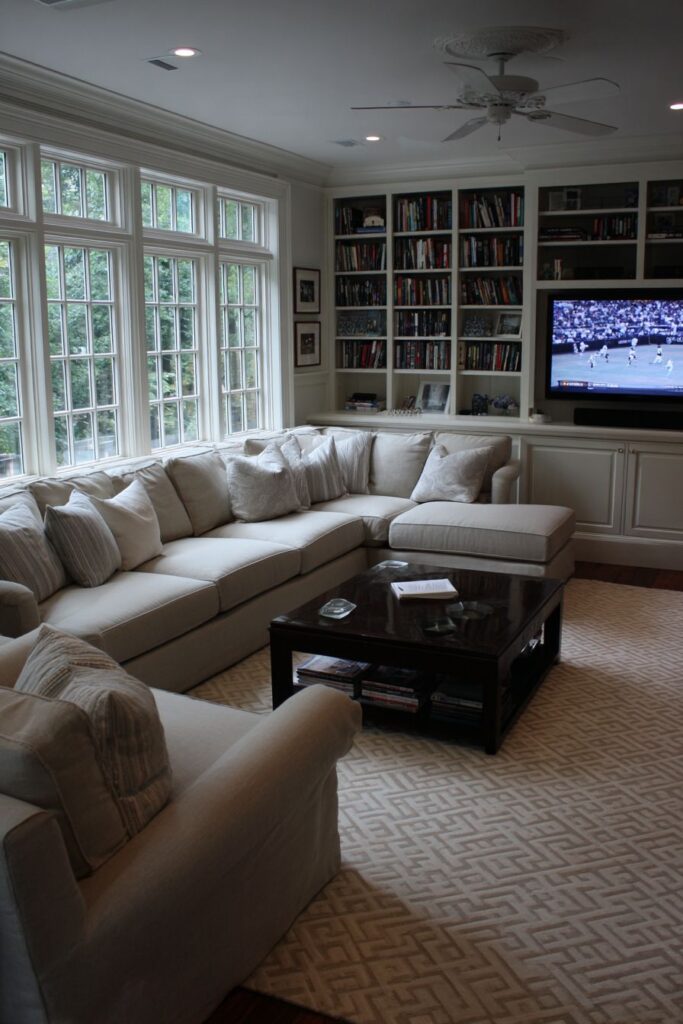
The classic built-in entertainment center with traditional raised panel doors successfully houses modern media equipment while maintaining the room’s refined aesthetic appeal. This storage solution demonstrates how traditional cabinetry can adapt to contemporary technology needs without sacrificing style. The raised panel doors provide visual texture and traditional craftsmanship details while concealing modern electronics.
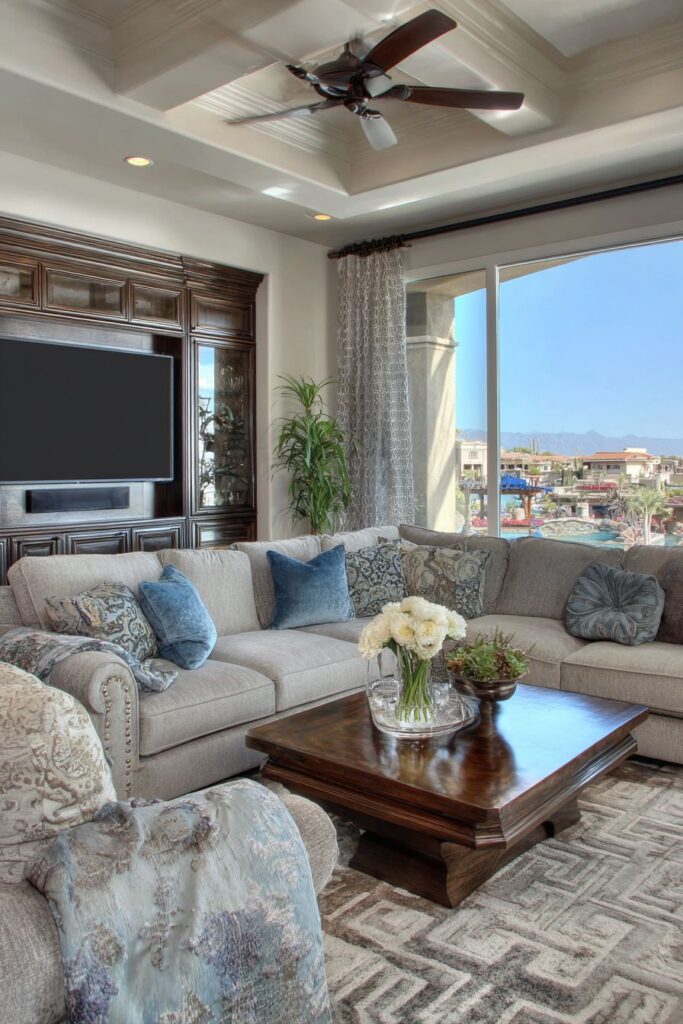
A traditional ceiling fan receives contemporary blade design updates, providing functional comfort while maintaining visual appeal appropriate for the room’s transitional styling. Modern ceiling fan technology offers improved energy efficiency and quieter operation while contemporary blade designs provide visual interest. This combination ensures comfort and function while maintaining design integrity.
Natural lighting through large windows highlights the successful integration of traditional comfort with contemporary style preferences, ensuring the space feels bright and welcoming throughout the day. Large windows maximize natural light while simple treatments maintain clean lines that complement both traditional and contemporary elements.
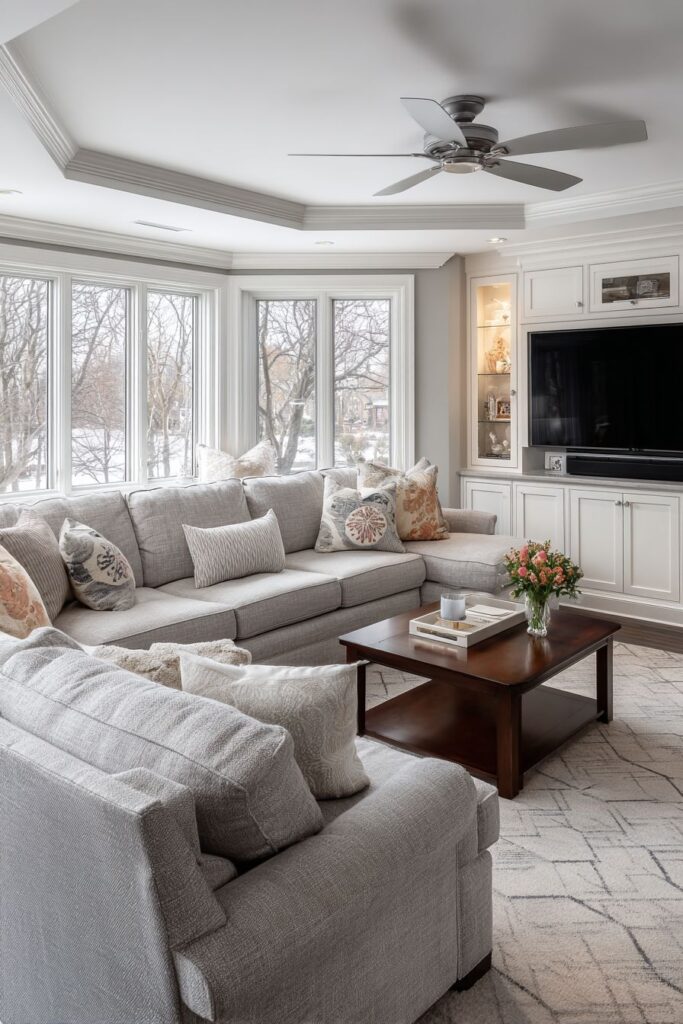
Effective sectional arrangement strategies include selecting sectional seating with traditional details like rolled arms updated with contemporary fabrics, using modern geometric area rugs in neutral tones to anchor seating arrangements while adding contemporary pattern, incorporating traditional built-in storage with raised panel details to house modern technology, updating traditional ceiling fans with contemporary blade designs for improved function and visual appeal, and maximizing natural light through large windows with simple treatments that complement both traditional and contemporary design elements.
14. Fireplace Modernization Excellence
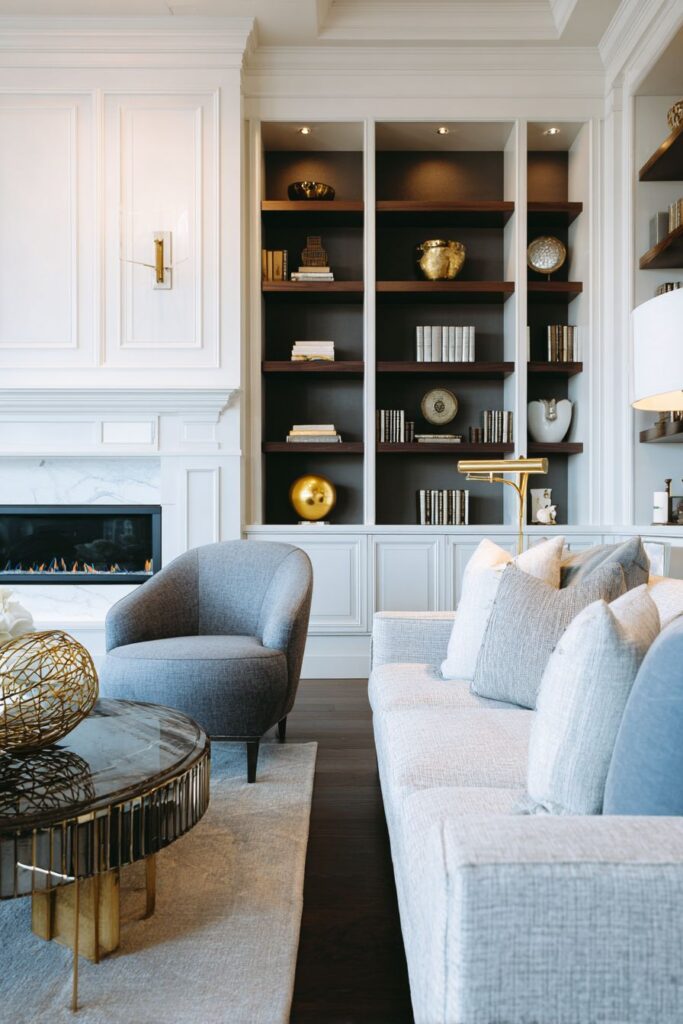
This sophisticated transitional living room demonstrates how traditional fireplace architecture can be successfully updated with modern technology while maintaining the warmth and elegance that make fireplaces such beloved focal points. The traditional fireplace surround and mantle provide classical architectural details that anchor the room’s design while the modern linear gas insert offers contemporary efficiency and clean-burning convenience.
The classic mantle and surround represent traditional craftsmanship and architectural detail while their substantial proportions provide the perfect frame for contemporary fireplace technology. This combination allows homeowners to enjoy both the visual appeal of traditional architecture and the convenience of modern heating technology. The traditional surround adds character and elegance while the modern insert provides efficient operation.
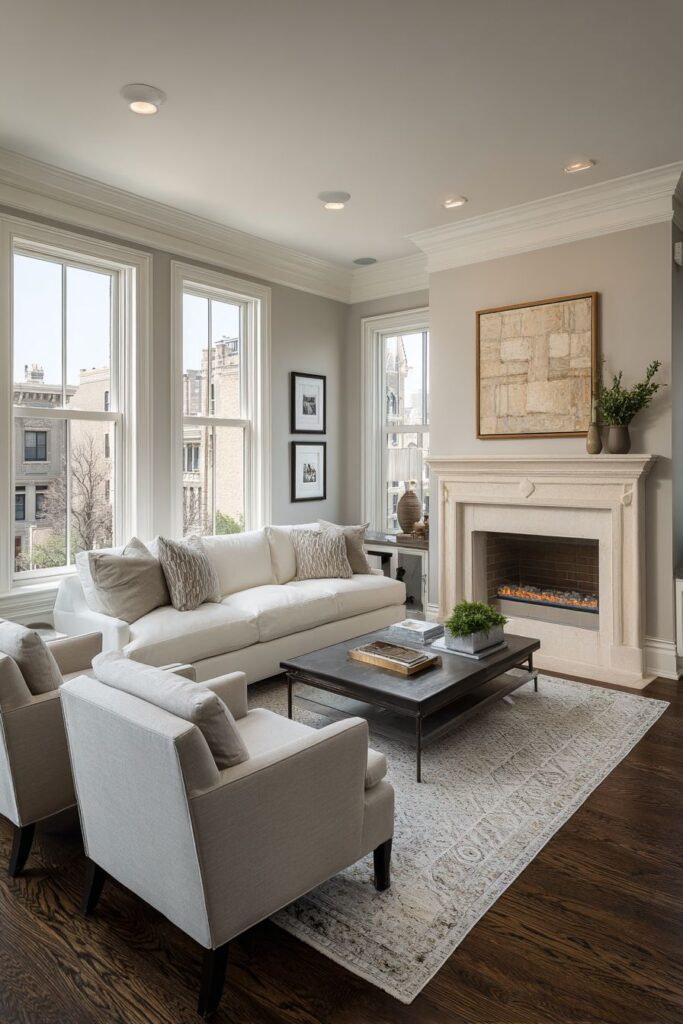
Contemporary accessories positioned on the mantle and surrounding areas introduce current design elements while respecting the traditional architecture’s proportions and styling. These accessories might include modern sculptures, contemporary pottery, or sleek candlesticks that add current appeal without overwhelming the classical framework. The key is selecting pieces that complement rather than compete with the traditional architecture.
The classic sofa silhouette in updated neutral fabric provides comfortable seating positioned to enjoy the fireplace while maintaining traditional furniture proportions that complement the architectural details. Neutral fabrics ensure the sofa remains versatile as style preferences evolve while the classic silhouette maintains consistency with the traditional fireplace architecture. This approach creates a cohesive furniture arrangement that feels both timeless and current.
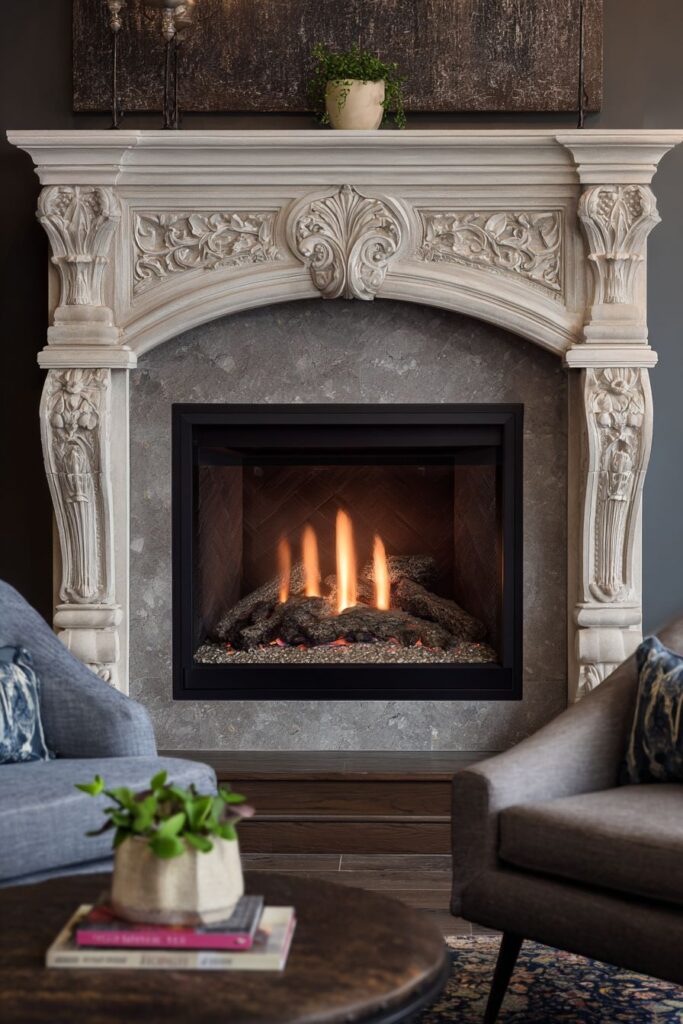
Modern accent chairs introduce contemporary seating options while their clean lines and updated proportions provide visual balance to the traditional sofa and fireplace combination. These chairs offer additional seating while their modern styling prevents the room from feeling overly traditional or formal. The contemporary seating adds flexibility and current appeal to the traditional furniture arrangement.
A contemporary coffee table provides essential functionality while its modern materials and clean lines bridge the gap between traditional architecture and updated furnishings. The coffee table’s contemporary styling ensures it complements both traditional and modern elements while providing practical surface space for books, beverages, or decorative objects.
Traditional hardwood floors complement both classical architectural features and contemporary furniture choices while providing natural beauty and durability that improves with age. Hardwood floors represent a timeless flooring choice that works equally well with traditional and contemporary design elements while adding warmth and natural texture to the space.
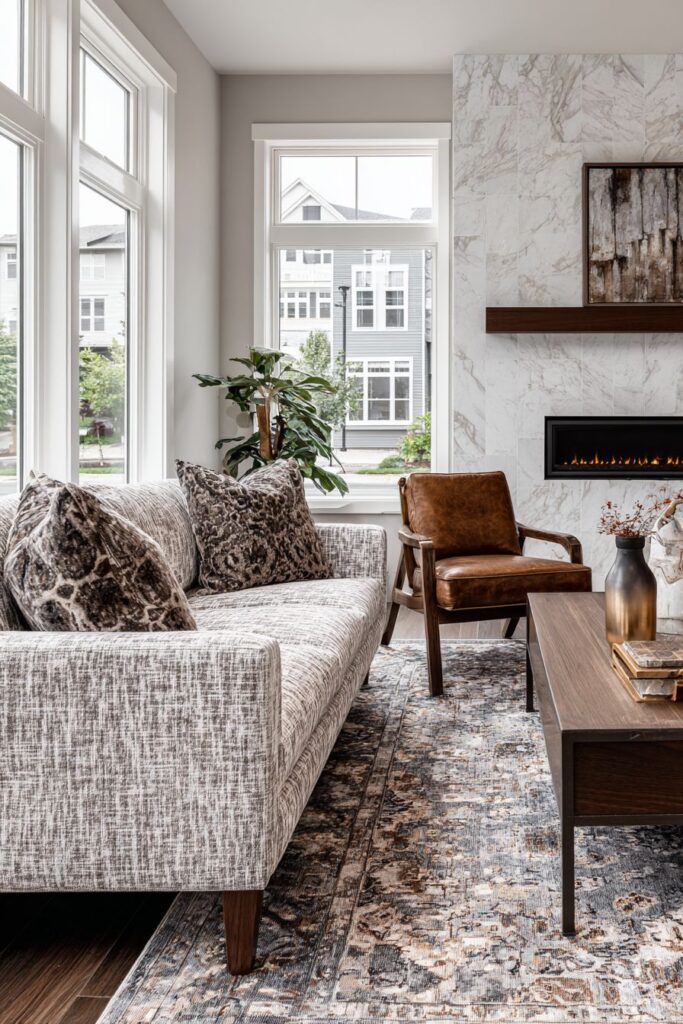
Successful fireplace modernization requires maintaining traditional surrounds and mantles while updating with modern gas or electric inserts for improved efficiency, selecting contemporary accessories that complement rather than compete with traditional architectural proportions, choosing classic furniture silhouettes in updated neutral fabrics for timeless appeal with contemporary comfort, incorporating modern accent seating that provides visual balance to traditional pieces, adding contemporary coffee tables that bridge traditional architecture with updated furnishings, and using traditional hardwood floors that complement both classical and contemporary elements.
15. Bay Window Seating Excellence
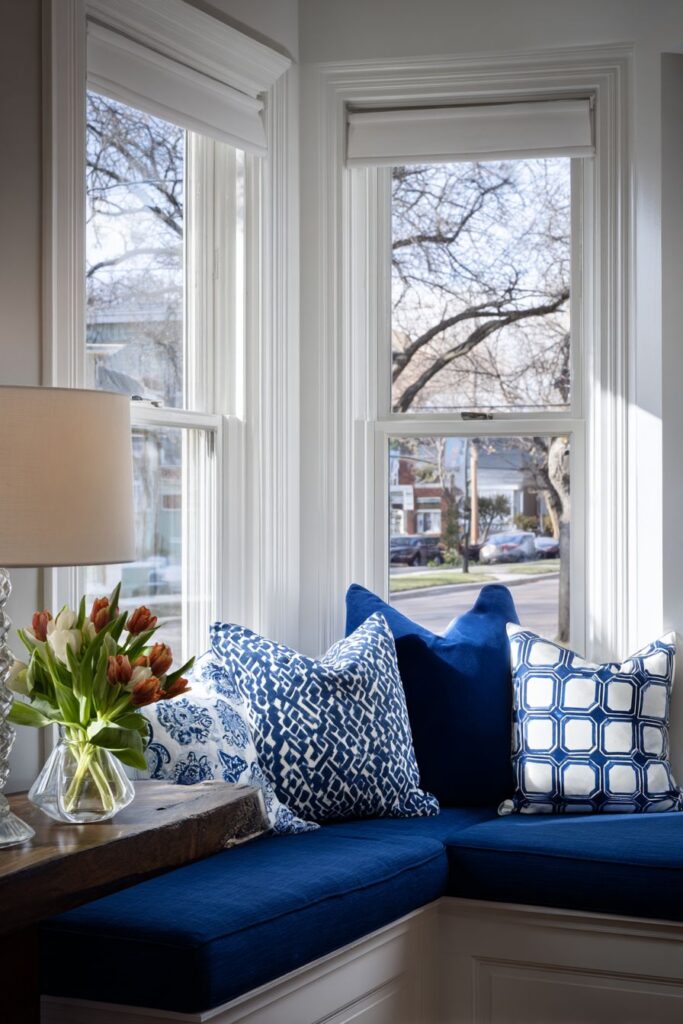
This charming transitional living room maximizes the potential of traditional bay window architecture through built-in seating solutions that combine classical woodwork with contemporary comfort and functionality. The built-in storage benches provide both additional seating and hidden storage opportunities while their custom design ensures perfect integration with the bay window’s architectural proportions.
The storage benches receive contemporary fabric upholstery that introduces current color and texture options while providing comfortable cushioning for extended seating. This upholstery approach allows the benches to serve multiple functions: they provide extra seating for large gatherings, create a cozy reading spot with natural light, and offer hidden storage for seasonal items, throw blankets, or games.
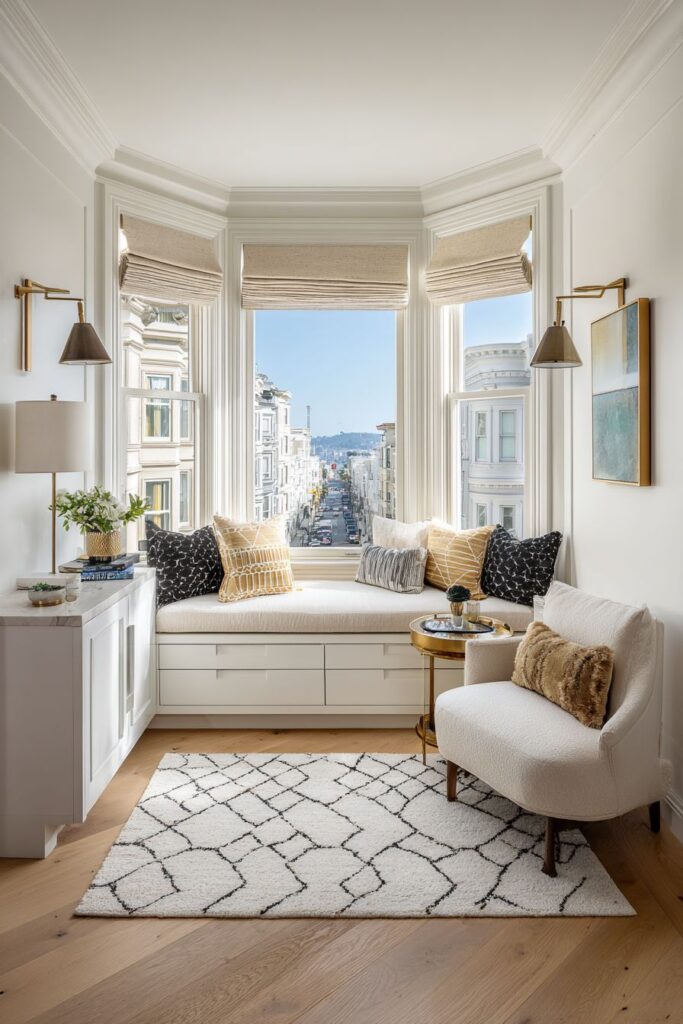
Modern throw pillows in geometric patterns add contemporary visual interest and comfort while their patterns and colors can be easily updated as style preferences change. Geometric patterns represent current design trends while their placement on traditional built-in seating demonstrates how contemporary accessories can enliven traditional architecture. These pillows provide opportunities to introduce seasonal colors or trending patterns without major investment.
Classic window trim painted white frames beautiful views while maintaining traditional architectural integrity that complements the room’s overall design approach. White-painted trim provides clean contrast while highlighting the window’s architectural details. This treatment ensures the bay window area feels integrated with the room’s overall color palette while maintaining its special architectural significance.
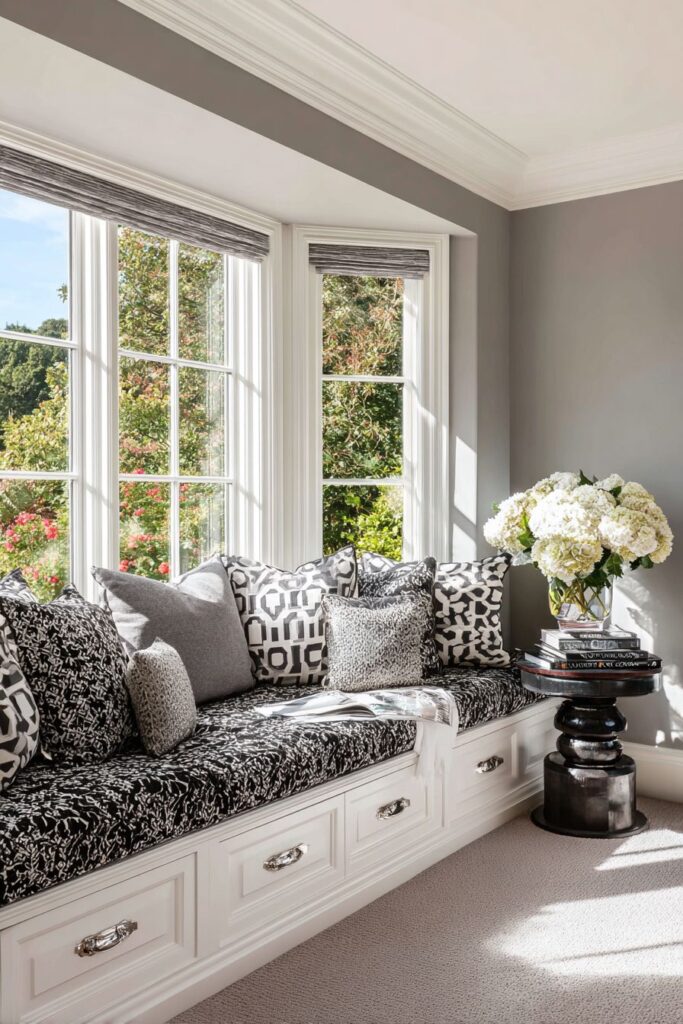
Contemporary Roman shades provide privacy and light control when needed while their simple styling doesn’t compete with the bay window’s architectural details or the built-in seating arrangement. Roman shades offer practical window covering solutions while their clean lines maintain contemporary appeal. The simple styling ensures they enhance rather than overwhelm the bay window’s special architecture.
Traditional side tables positioned near the bay window seating provide essential surface space for books, beverages, or table lamps while their classic styling maintains consistency with the built-in woodwork. These tables ensure the bay window seating area remains functional for reading, conversation, or relaxation while their traditional design maintains architectural harmony.
Modern lamps positioned near the seating area provide task lighting for reading while their contemporary styling adds current design elements to the traditional bay window architecture. These lighting solutions ensure the bay window area remains functional during evening hours while their modern design prevents the space from feeling dated or overly traditional.
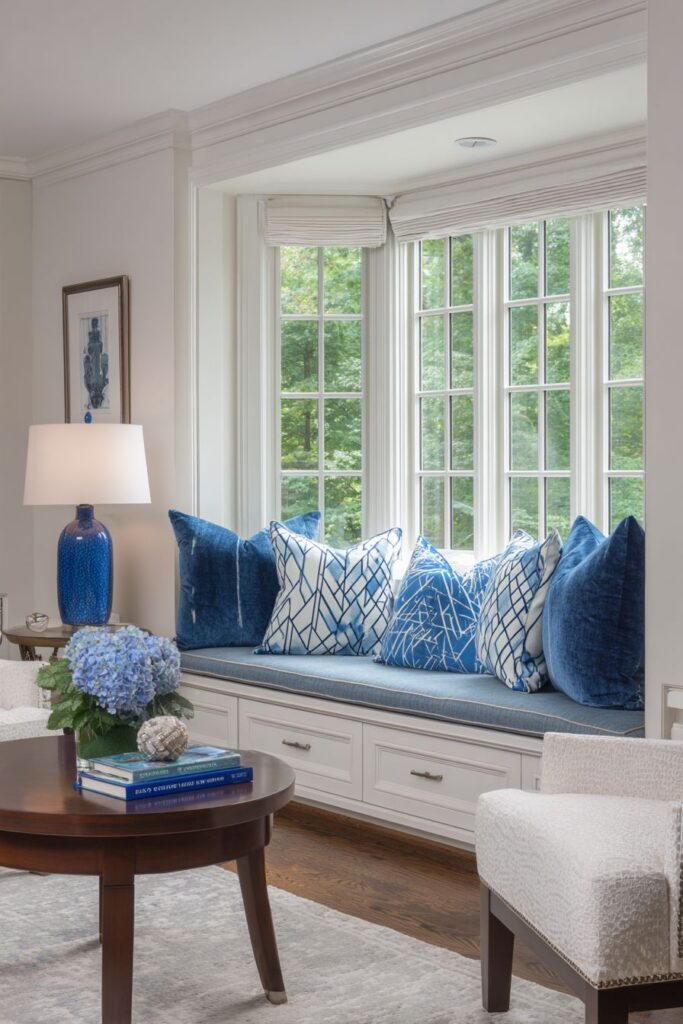
Maximizing bay window potential requires creating built-in storage benches that provide seating, storage, and architectural integration, using contemporary upholstery fabrics that add comfort and current appeal to traditional woodwork, incorporating modern throw pillows with geometric patterns for easily updated contemporary interest, maintaining classic window trim painted white for architectural integrity and visual contrast, selecting simple Roman shades that provide function without competing with architectural details, positioning traditional side tables that maintain architectural harmony while providing practical function, and adding modern task lighting that ensures evening functionality while contributing contemporary design elements.
16. Button Tufted Elegance
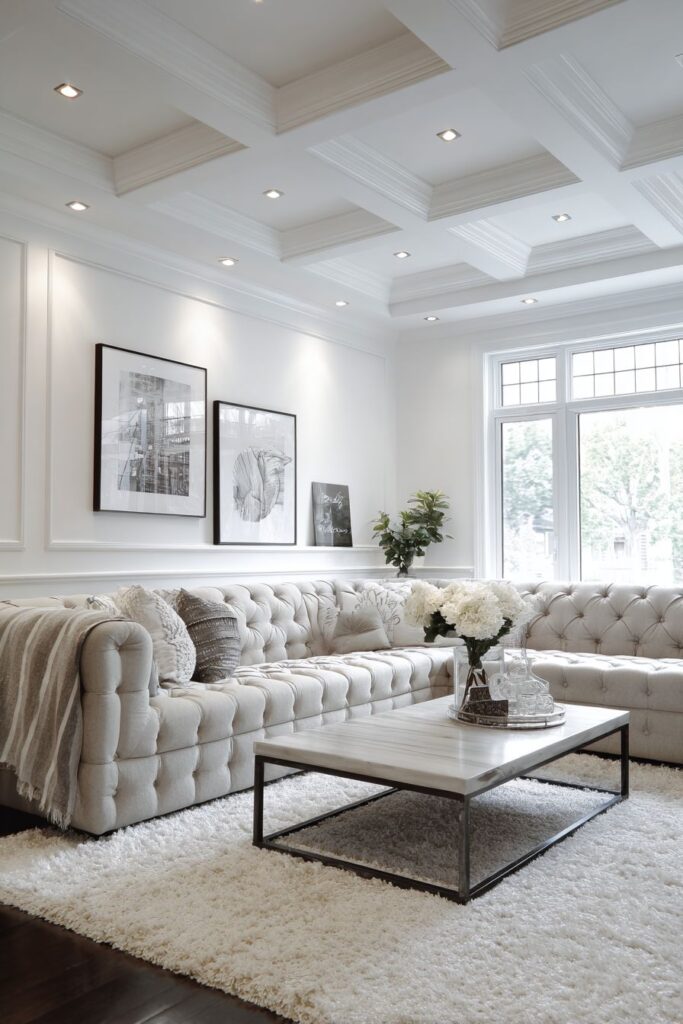
This refined transitional living room showcases how traditional button tufting details can add sophisticated texture and visual interest while contemporary materials and clean lines prevent the space from feeling overly formal or dated. The sectional seating features classic button tufting that creates dimensional texture and traditional craftsmanship appeal while its substantial size ensures comfortable seating for modern family living.
The button tufting technique represents centuries of upholstery craftsmanship while its dimensional texture adds visual interest and sophisticated detail to large seating pieces. This traditional technique prevents flat upholstered surfaces from appearing boring while adding the kind of handcrafted detail that elevates furniture beyond basic contemporary pieces. The tufting creates shadow and light patterns that change throughout the day as natural lighting shifts.
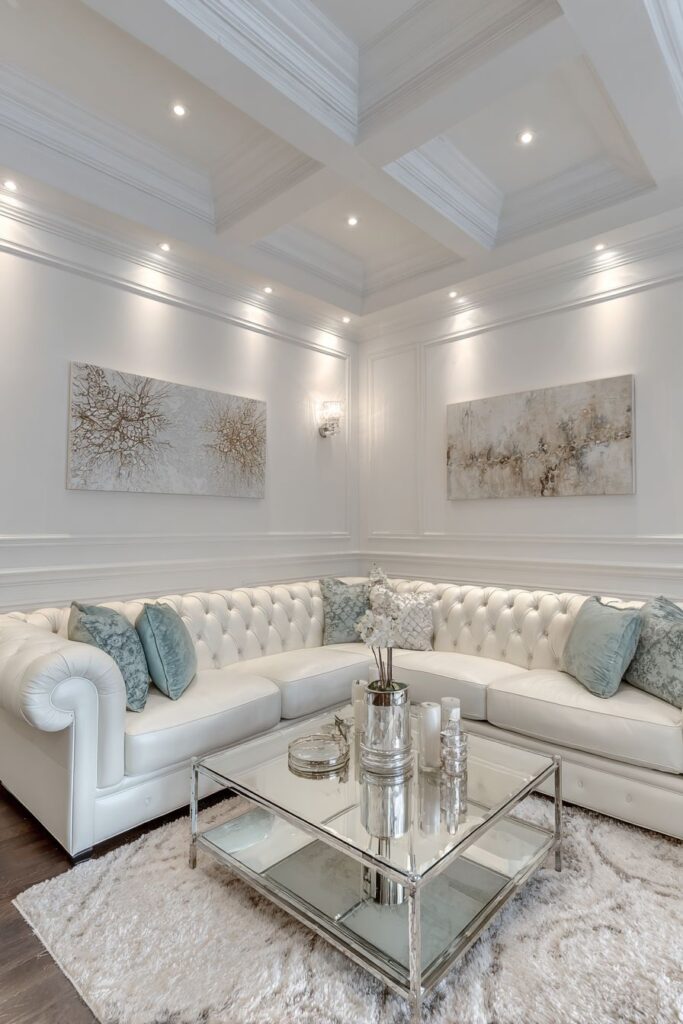
A contemporary coffee table with clean geometric lines provides striking contrast to the traditional tufted seating while offering essential functionality for daily use. The table’s modern materials and minimal styling ensure it doesn’t compete with the sectional’s elaborate tufting while providing adequate surface space for books, beverages, or decorative objects. This pairing demonstrates how contemporary pieces can enhance traditional elements through thoughtful contrast.
Classic crown molding and chair rail details painted in soft white provide traditional architectural framework while their light color prevents them from overwhelming contemporary furnishings. These architectural details add character and craftsmanship appeal while creating visual boundaries that enhance the room’s proportions. The white paint ensures these traditional elements enhance rather than darken the space.
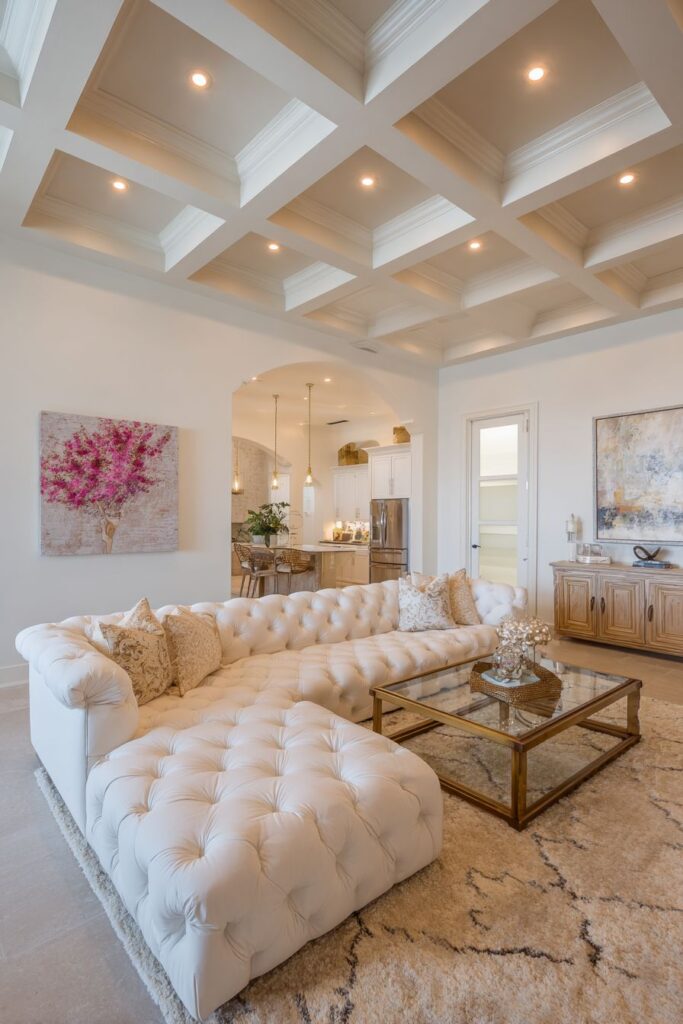
Modern artwork positioned throughout the space provides contemporary focal points while contemporary accessories add current appeal without overwhelming the traditional architectural and furniture details. The artwork introduces color, pattern, or texture that energizes the traditional elements while demonstrating how modern art can enhance rather than clash with classical design features.
Natural lighting combined with updated recessed fixtures creates layered illumination that highlights both traditional craftsmanship details and contemporary design elements throughout the day and evening. This lighting approach ensures both traditional tufting details and contemporary accessories receive appropriate illumination while providing functional lighting for various activities.
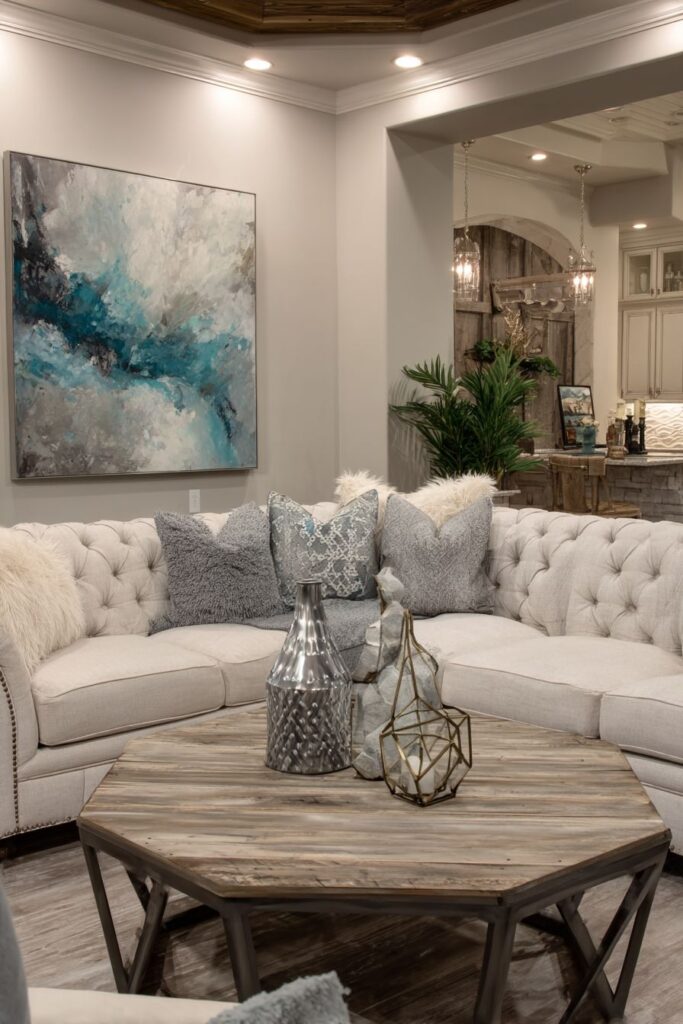
Achieving tufted elegance requires selecting sectional seating with traditional button tufting for sophisticated texture and handcrafted appeal, incorporating contemporary coffee tables with clean lines that provide functional contrast to elaborate upholstery details, maintaining traditional architectural elements like crown molding painted in light colors for character without heaviness, using modern artwork and accessories to energize traditional furniture and architectural elements, and creating layered lighting with both natural and recessed fixtures that highlights both traditional craftsmanship and contemporary design features.
17. Library Wall Sophistication
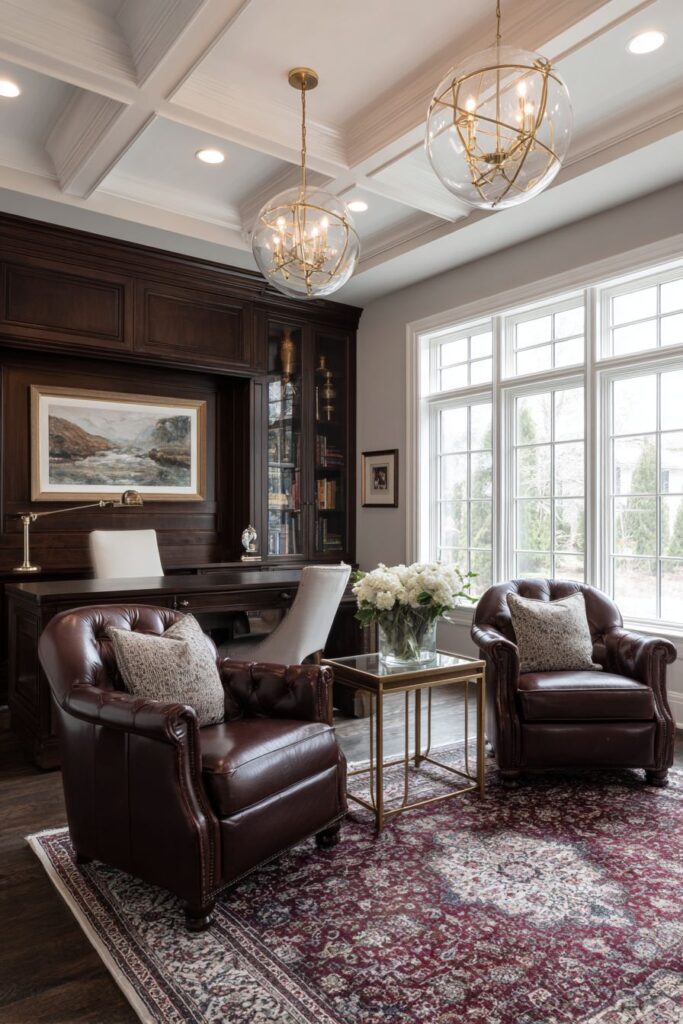
This intellectually sophisticated transitional living room features a stunning library wall that demonstrates how traditional built-in bookcases can be enhanced with modern functionality while maintaining the scholarly elegance that makes home libraries so appealing. The built-in bookcases crafted in rich wood finish provide substantial storage for books and display objects while their traditional proportions and craftsmanship details create impressive architectural impact.
The rich wood finish on the built-in bookcases adds warmth and traditional craftsmanship appeal while providing durable surfaces that improve with age. Traditional wood finishes represent centuries of furniture-making expertise while their natural beauty complements both traditional and contemporary design elements. The rich tones create a sophisticated backdrop for books and decorative objects.
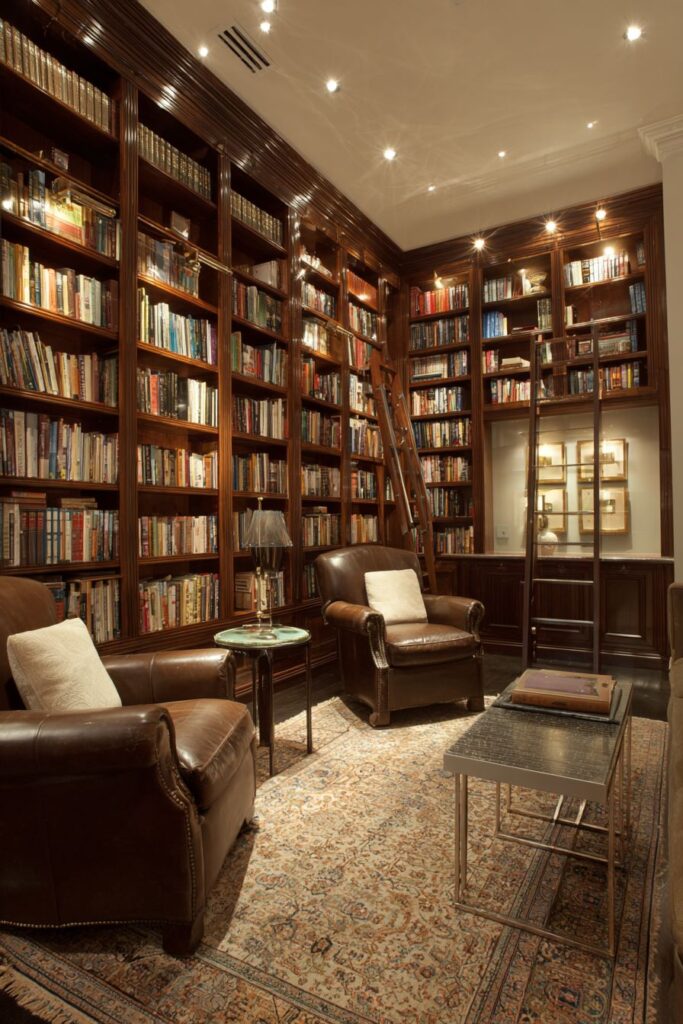
Modern ladder hardware introduces contemporary functionality and visual interest while providing practical access to higher shelving areas. This hardware represents contemporary innovation applied to traditional library design, ensuring the bookcases remain fully functional while adding industrial design elements that bridge traditional and contemporary aesthetics. The ladder becomes both a functional tool and an interesting design feature.
Contemporary lighting fixtures positioned throughout the library area provide optimal illumination for reading and book selection while their modern styling adds current design elements to the traditional bookcase architecture. These fixtures ensure the library remains functional during evening hours while their contemporary design prevents the space from feeling dated or purely traditional.
Classic leather reading chairs with traditional silhouettes receive updates through current color choices, creating seating that provides both comfort for extended reading sessions and visual appeal that complements the traditional bookcase design. The leather upholstery adds durability and develops beautiful patina over time while current color selections ensure the chairs feel fresh and relevant. These chairs demonstrate how traditional furniture forms can be refreshed through contemporary color palettes while maintaining their essential comfort and proportions.
Modern side tables positioned beside the reading chairs provide essential surface space for beverages, reading glasses, or note-taking materials while their contemporary styling prevents the library area from feeling overly traditional or formal. These tables offer functional support for the reading experience while their clean lines create visual balance with the elaborate bookcase architecture.
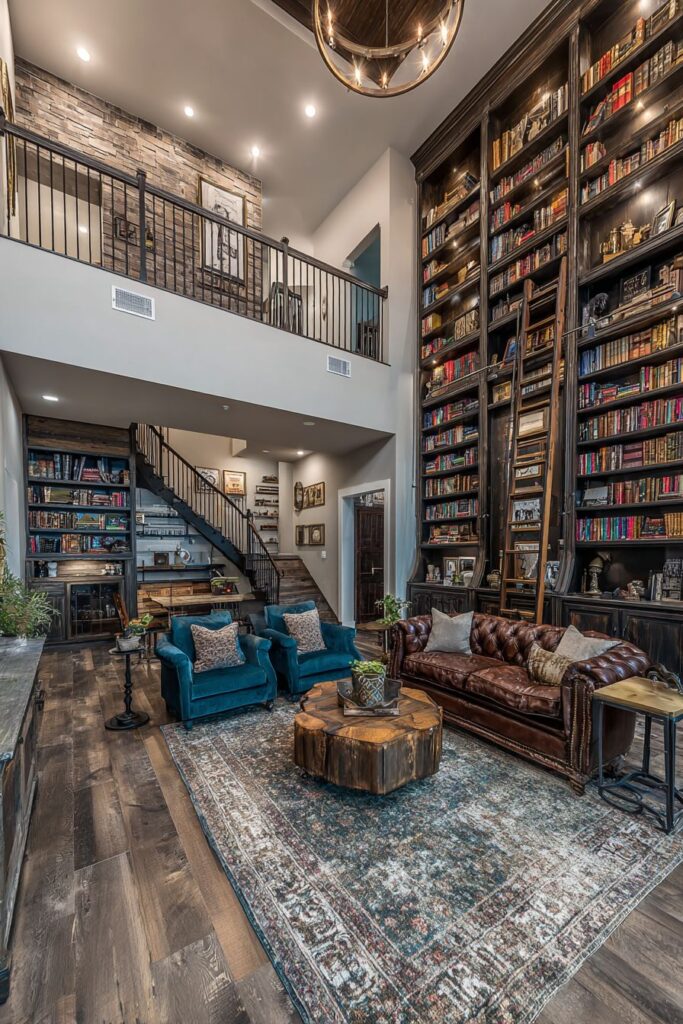
A traditional Persian rug in muted colors anchors the entire library seating area while adding pattern, texture, and warmth to the floor plane. Persian rugs represent centuries of traditional craftsmanship and their intricate patterns complement the intellectual sophistication of a home library. The muted color palette ensures the rug enhances rather than competes with the rich wood bookcases and leather seating.
The combination of traditional built-in architecture with contemporary functionality creates a library space that honors the intellectual tradition of home libraries while addressing modern storage and lighting needs. This approach ensures the library remains a practical and inviting space for reading, research, or quiet contemplation while maintaining the sophisticated aesthetic appeal that makes libraries such treasured home features.
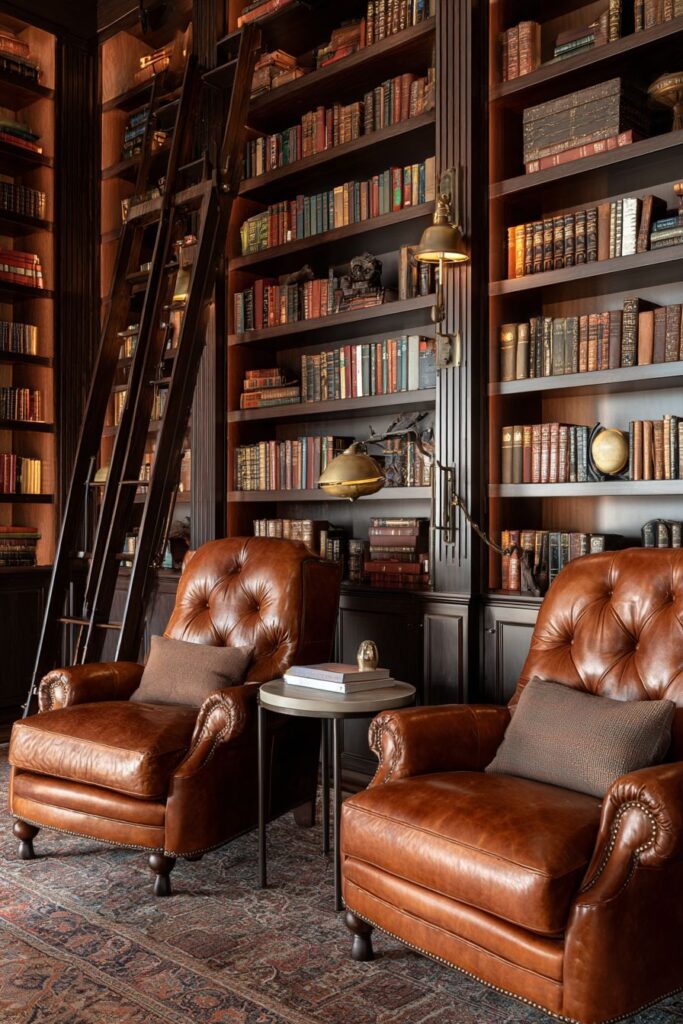
Creating library wall sophistication requires designing built-in bookcases in rich wood finishes that provide substantial storage while adding architectural impact, incorporating modern ladder hardware that adds both contemporary functionality and visual interest, using contemporary lighting fixtures that provide optimal reading illumination while adding current design elements, selecting classic leather seating updated with current colors for comfort and contemporary appeal, adding modern side tables that provide practical function while maintaining visual balance with traditional architecture, and anchoring the space with traditional Persian rugs in muted colors that complement rich wood and leather elements.
18. Formal Traditional Balance
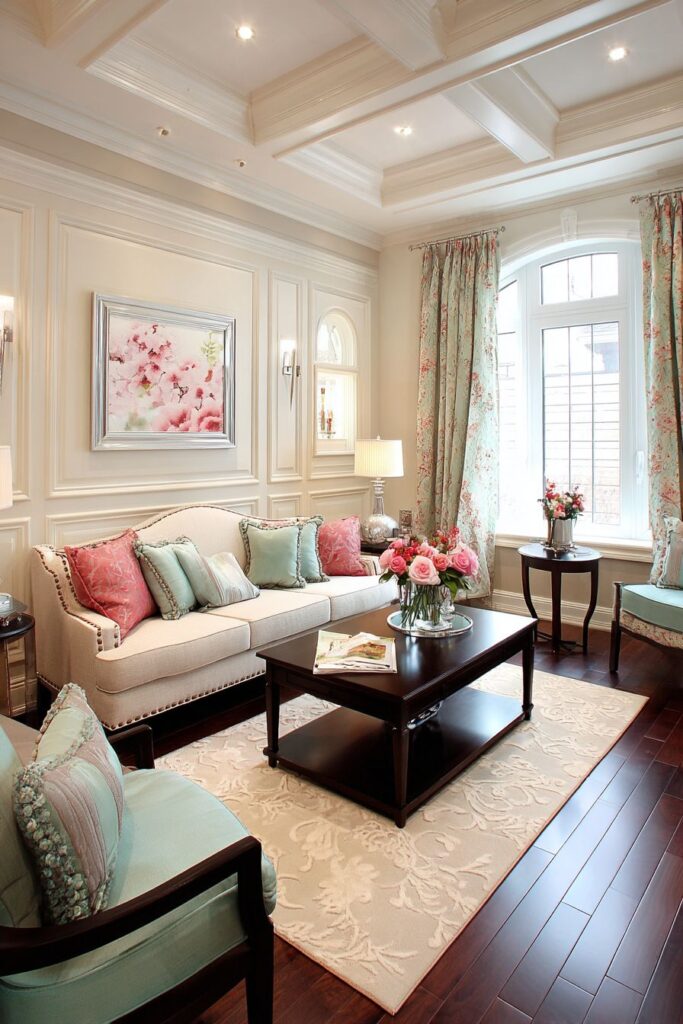
This elegantly appointed transitional living room achieves the perfect balance between formal traditional elements and relaxed contemporary living through careful selection and placement of furniture and accessories. The classic sofa featuring nail head trim and rolled arms provides sophisticated traditional styling while its substantial proportions ensure comfortable seating for modern family living. The nail head trim adds handcrafted detail and visual interest while the rolled arms create the refined silhouette that defines traditional furniture design.
Contemporary accent pieces including modern side tables and updated table lamps introduce current design elements while their carefully chosen proportions ensure they complement rather than compete with the traditional sofa’s elaborate details. These contemporary pieces demonstrate how modern furniture can enhance traditional elements by providing functional support and visual balance without overwhelming the established formal elements.
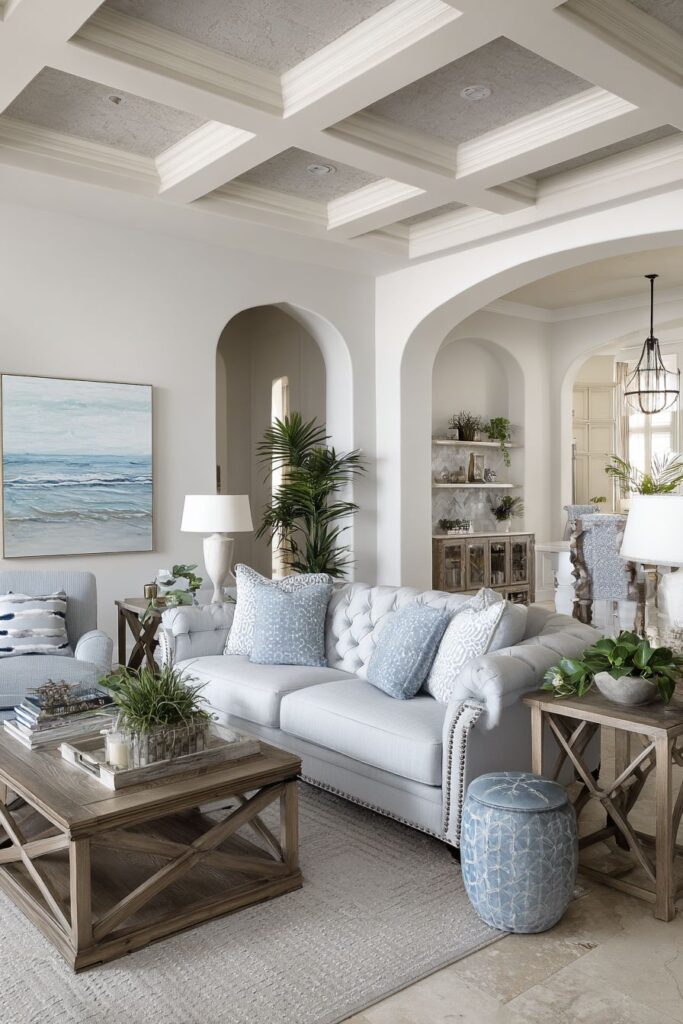
Classic architectural details including decorative wall panels painted in soft colors provide sophisticated backdrop and traditional craftsmanship appeal while their light color palette prevents them from overwhelming contemporary accessories. These architectural features add character and visual texture while creating the kind of refined framework that allows both traditional and contemporary elements to shine.
Contemporary artwork and accessories add current style and visual interest while their thoughtful placement ensures they energize rather than clash with the formal traditional furniture and architectural elements. The artwork provides opportunities to introduce color, pattern, or texture that reflects current preferences while the accessories allow for seasonal updates and personal expression within the formal framework.
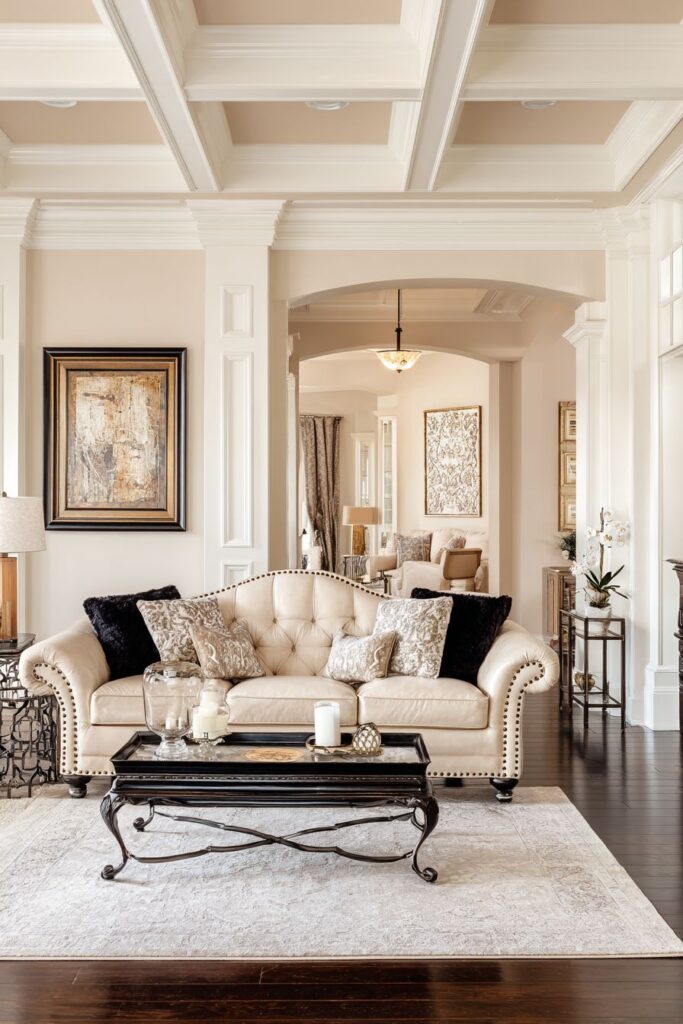
The soft color palette used throughout the space creates harmony between traditional and contemporary elements while providing a sophisticated backdrop that allows both formal furniture and casual accessories to coexist beautifully. Soft colors prevent the formal elements from feeling overwhelming while ensuring contemporary pieces feel appropriate and integrated.
Professional lighting design highlights the refined blend of formal traditional elements with relaxed contemporary accessories, ensuring both traditional craftsmanship details and modern pieces receive appropriate illumination throughout the day. This lighting approach creates the kind of sophisticated ambiance that makes formal spaces feel welcoming and livable.
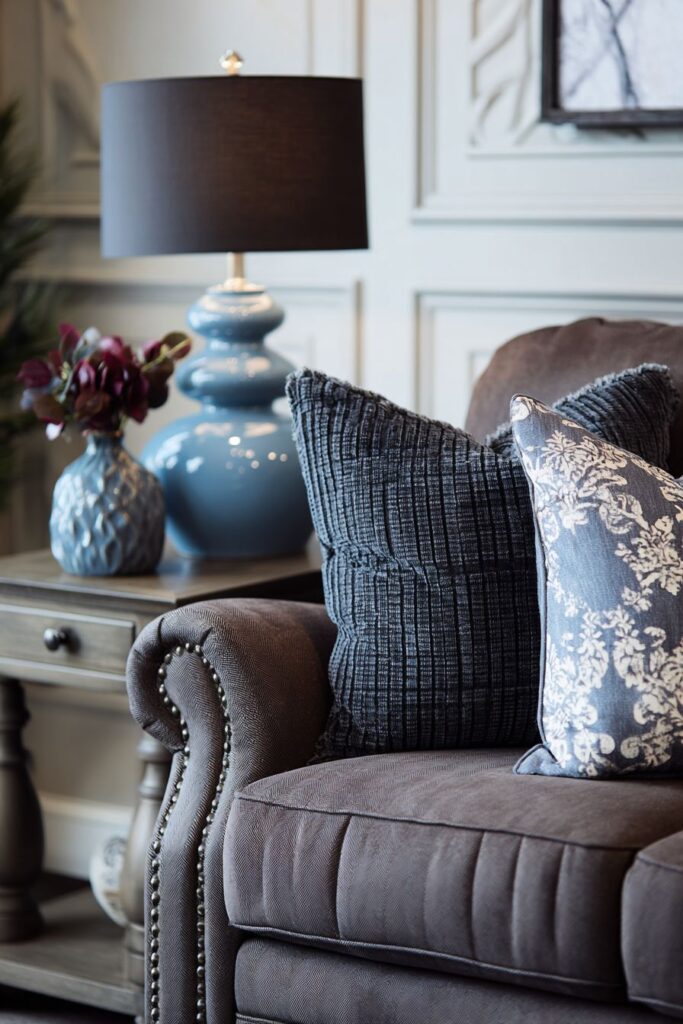
Achieving formal traditional balance requires selecting traditional seating with classic details like nail head trim for sophisticated anchoring while ensuring comfortable proportions, incorporating contemporary accent pieces that provide functional support without overwhelming traditional formal elements, maintaining classic architectural details like decorative wall panels in soft colors for sophisticated backdrop, using contemporary artwork and accessories to energize formal traditional furniture while adding current appeal, choosing soft color palettes that create harmony between formal and casual elements, and implementing professional lighting that highlights both traditional craftsmanship and contemporary accessories.
19. Contemporary Accent Integration
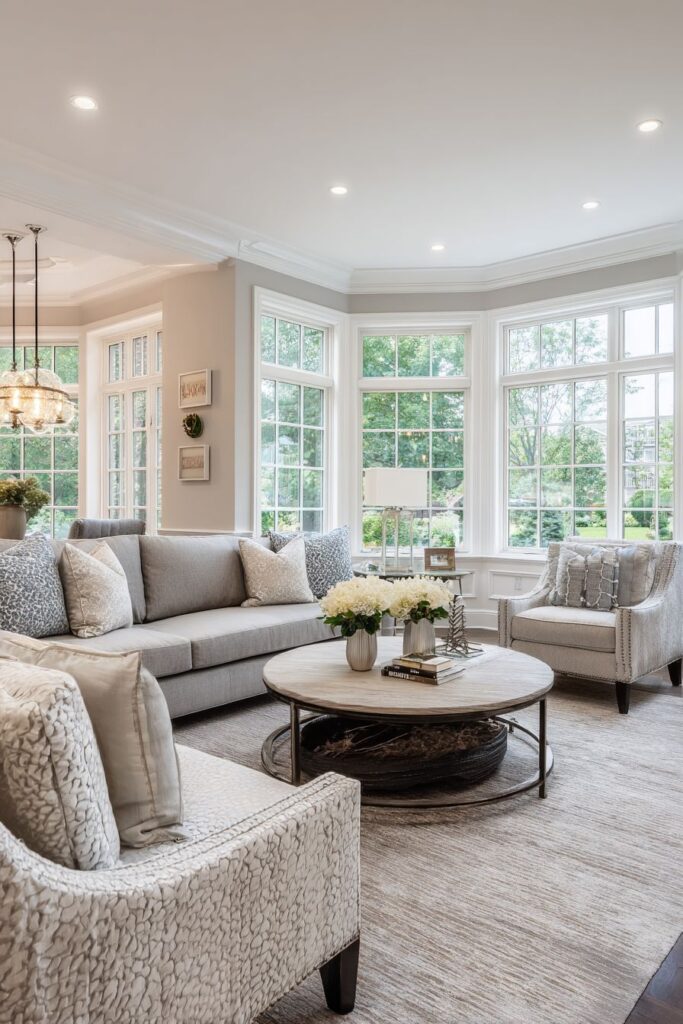
This thoughtfully designed transitional living room demonstrates how contemporary accent pieces can successfully enhance traditional furniture arrangements while maintaining the comfort and sophistication that make transitional design so appealing to modern families. The traditional furniture arrangement centers around a classic sectional in neutral fabric that provides generous seating while maintaining the refined proportions and comfortable styling that define quality traditional furniture.
Contemporary accent chairs in updated patterns introduce current design trends while their carefully chosen scale ensures they complement rather than compete with the traditional sectional for visual attention. These chairs demonstrate how contemporary furniture can add variety and current appeal to traditional arrangements while providing additional seating options for entertaining or family gatherings.
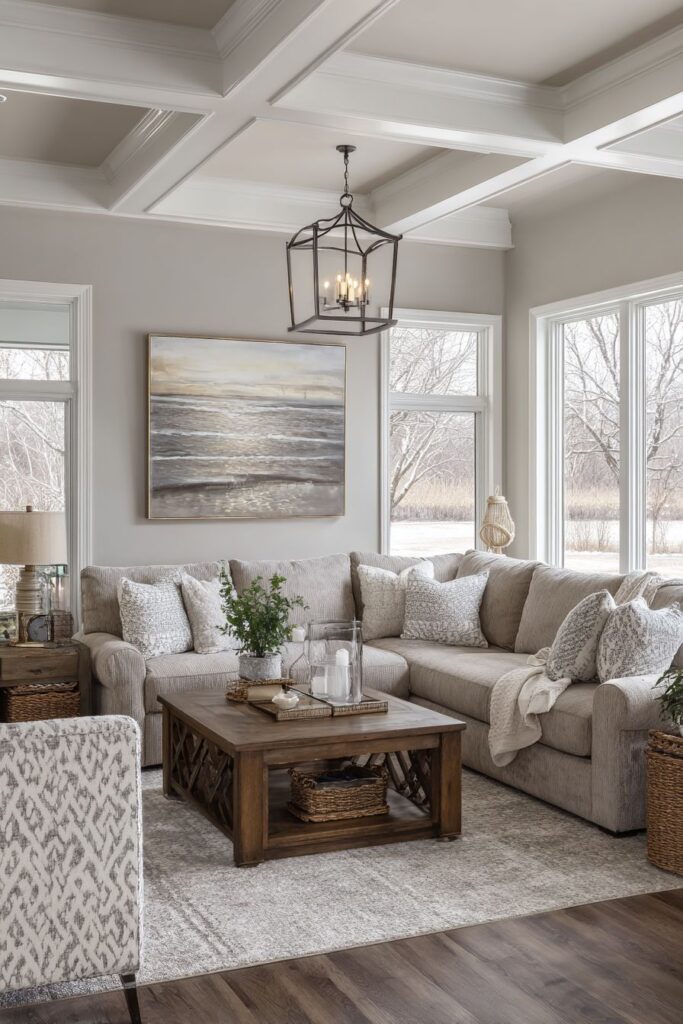
A modern coffee table with mixed materials creates an interesting focal point while providing essential functionality for the large seating arrangement. The mixed materials approach might include combinations like wood and metal, glass and stone, or other contemporary material pairings that add visual interest while maintaining practical functionality. This contemporary piece bridges traditional and modern elements through thoughtful material selection.
Traditional ceiling details including crown molding painted white provide architectural character and traditional craftsmanship appeal while their light color ensures they enhance rather than overwhelm contemporary furnishings. These architectural elements add the kind of refined detail that elevates the entire room’s sophistication level while maintaining compatibility with both traditional and contemporary design elements.
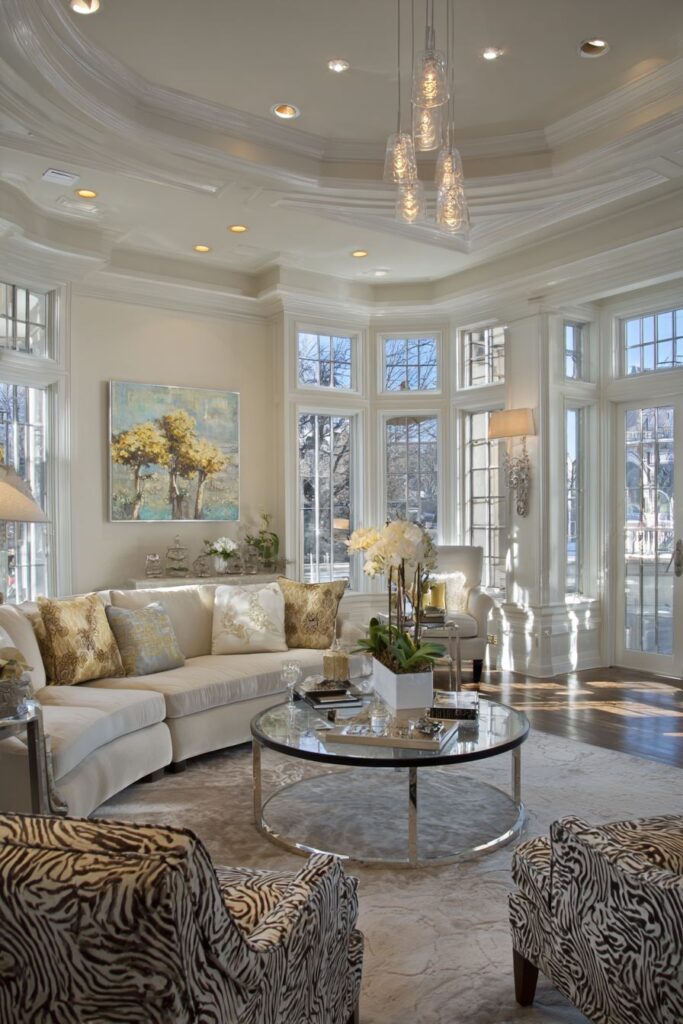
Contemporary pendant lighting provides modern illumination solutions while its clean styling adds current design elements without competing with traditional architectural features. Modern pendant lighting offers efficient illumination and adjustable placement while its contemporary design ensures the lighting feels current and appropriate for today’s lifestyle needs.
Natural light through large windows with classic trim work highlights the seamless integration of traditional comfort with contemporary style preferences, ensuring the space feels bright and welcoming while maintaining architectural integrity. The classic trim work provides traditional detailing while the large windows maximize natural light that benefits both traditional and contemporary elements.
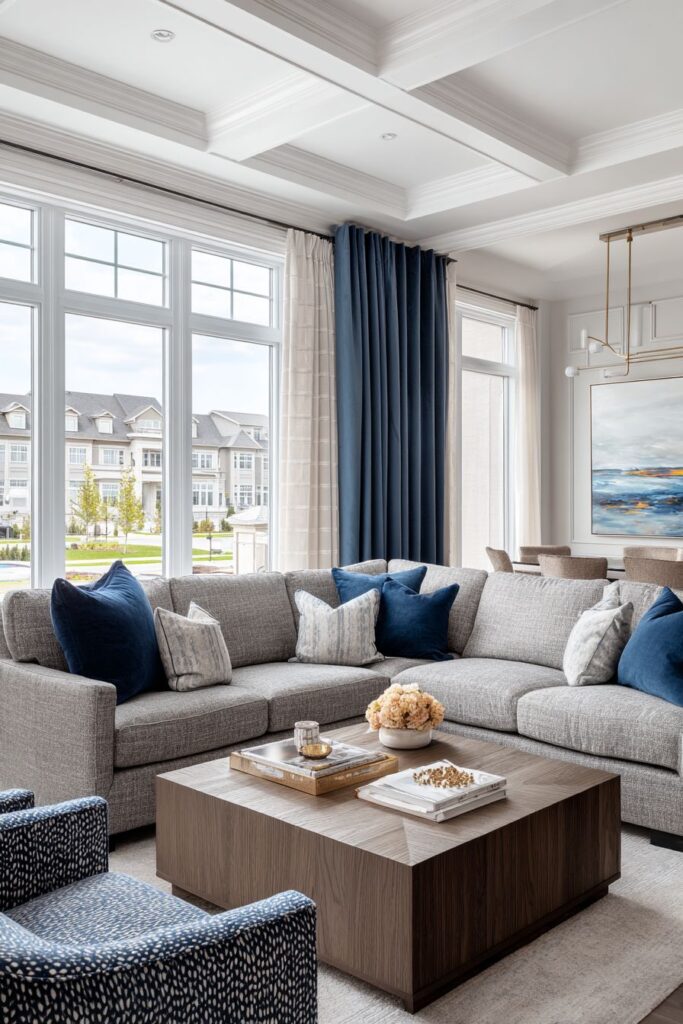
Successful contemporary accent integration requires selecting traditional sectional seating in neutral fabrics for comfortable anchoring with timeless appeal, incorporating contemporary accent chairs in updated patterns that add current interest without overwhelming traditional pieces, using modern coffee tables with mixed materials to create focal points while bridging traditional and contemporary elements, maintaining traditional ceiling details like crown molding in light colors for architectural character, adding contemporary pendant lighting that provides modern function while complementing traditional architecture, and maximizing natural light through large windows with classic trim that highlights both traditional and contemporary design elements.
20. Great Room Concept Excellence
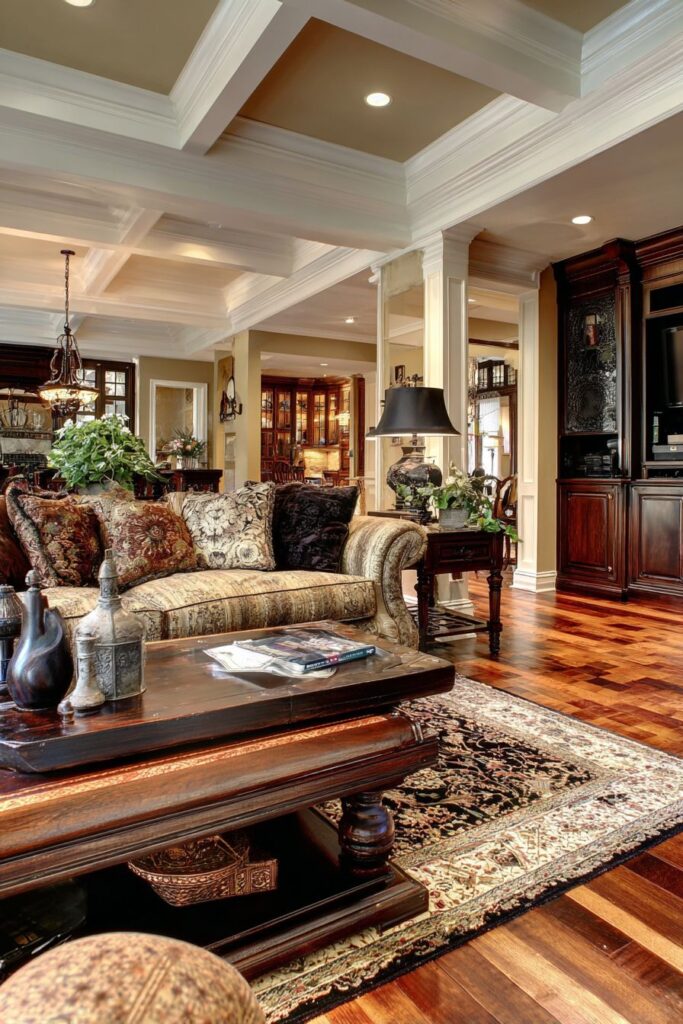
This expansive transitional living room showcases how the great room concept can successfully incorporate traditional furniture and architectural elements while maintaining the open, connected feeling that makes great rooms so appealing for modern family living. The traditional furniture arrangement includes classic rolled-arm sofas and traditional coffee tables that provide substantial seating and surface space appropriate for large, multi-functional spaces.
The rolled-arm sofa represents traditional furniture craftsmanship while its generous proportions ensure comfortable seating for the great room’s substantial scale. Traditional coffee tables provide essential surface space and storage while their classic styling maintains consistency with the traditional seating arrangement. These substantial pieces ensure the great room feels furnished and comfortable rather than empty or overwhelming.
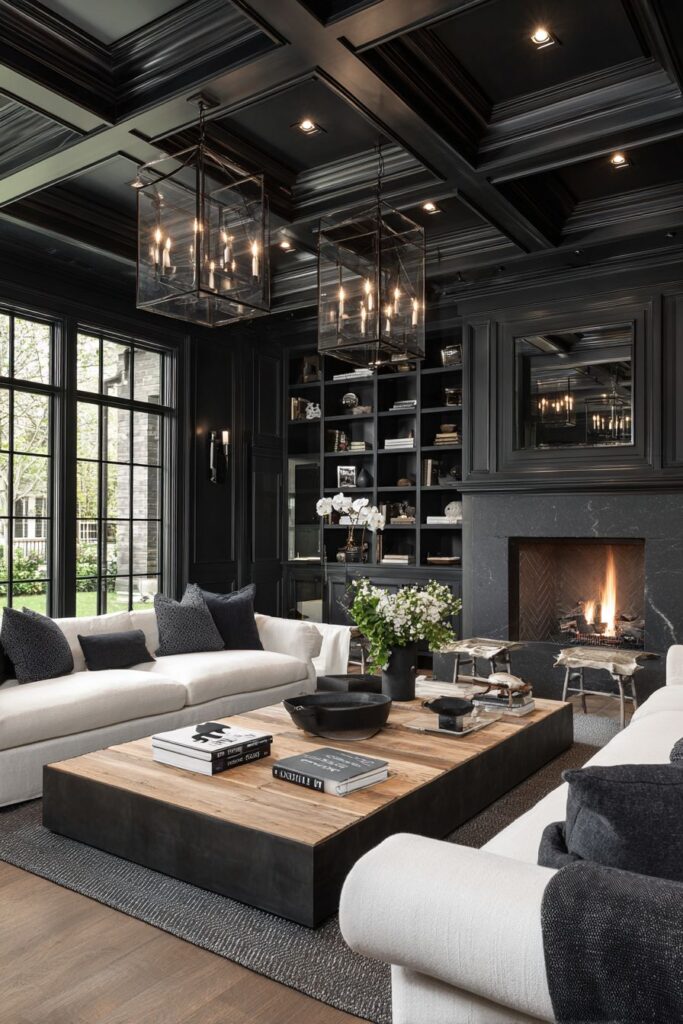
Contemporary accessories and modern lighting solutions introduce current design elements while their thoughtful placement ensures they enhance rather than compete with the traditional furniture pieces. Contemporary accessories might include modern sculptures, updated textiles, or current pottery that adds visual interest while demonstrating how traditional and contemporary elements can coexist successfully in large spaces.
Traditional hardwood floors provide natural beauty and durability while their warm tones complement both classical furniture pieces and contemporary accents throughout the expansive space. Hardwood floors represent a timeless flooring choice that works equally well with traditional and contemporary design elements while providing the kind of durable, beautiful surface that improves with age.
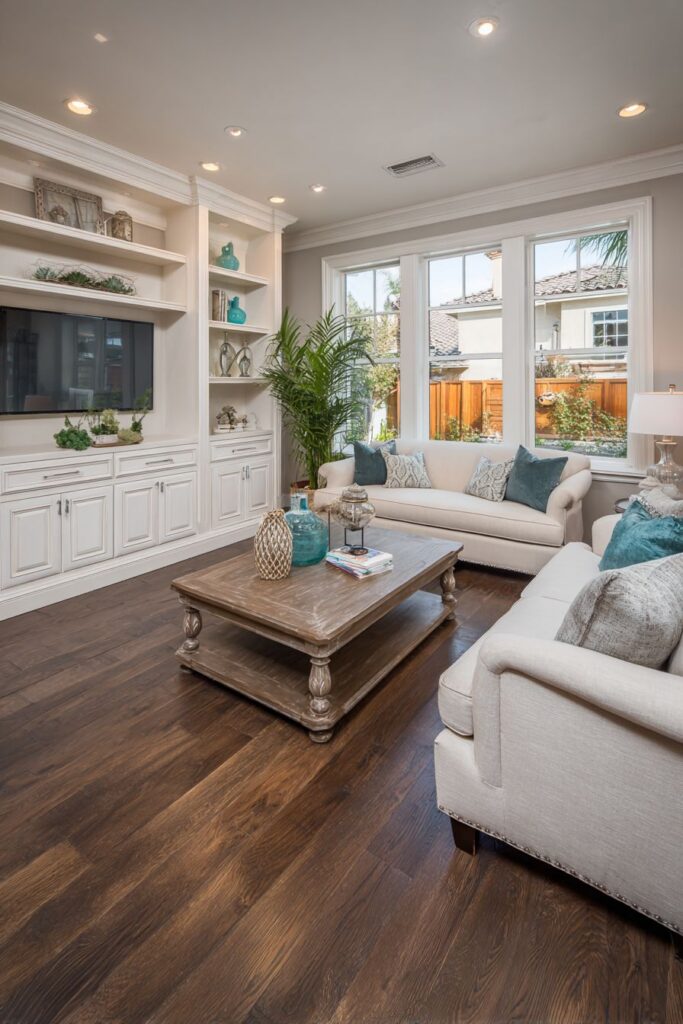
Built-in cabinetry with traditional raised panel doors successfully houses modern entertainment technology while maintaining the room’s refined aesthetic appeal and providing essential storage for the great room’s multiple functions. This storage solution addresses the practical needs of great room living while maintaining traditional craftsmanship details that complement the furniture arrangement.
Modern entertainment technology integration ensures the great room remains functional for contemporary family living while traditional architectural and furniture elements provide the kind of established elegance that makes great rooms feel sophisticated rather than purely casual. This balance ensures the space works for both daily family activities and formal entertaining.
The spacious scale of the great room concept allows traditional and contemporary elements adequate space to coexist without competing, while the open layout ensures natural light reaches all areas and enhances both traditional craftsmanship details and contemporary accessories throughout the day.
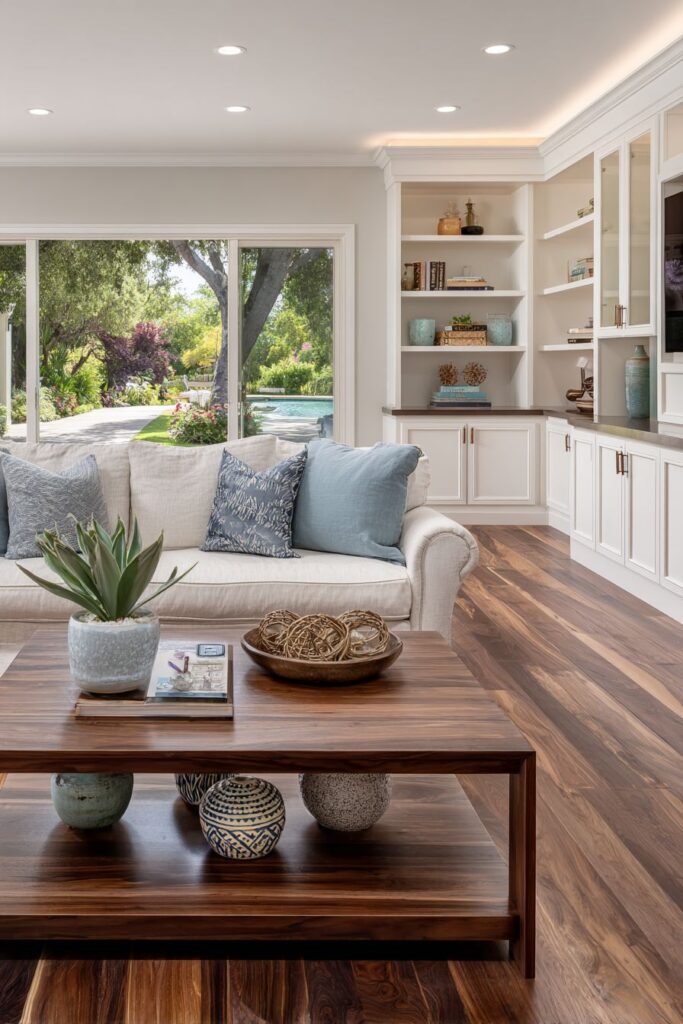
Achieving great room excellence requires selecting traditional furniture with substantial proportions appropriate for large spaces while maintaining classic styling, incorporating contemporary accessories and lighting that enhance rather than compete with traditional pieces, using traditional hardwood floors that complement both classical and contemporary elements while providing durable beauty, adding built-in storage with traditional details that houses modern technology while maintaining refined aesthetics, ensuring modern entertainment integration supports contemporary lifestyle while respecting traditional design elements, and maintaining spacious scale that allows traditional and contemporary elements adequate space to coexist successfully.
Why These Transitional Designs Represent the Best in Contemporary Living
Each of these twenty transitional living room designs demonstrates why this approach has become the preferred choice for discerning homeowners who appreciate both traditional craftsmanship and contemporary convenience. The transitional style’s greatest strength lies in its flexibility and timeless appeal, allowing homeowners to create spaces that honor architectural heritage while embracing modern lifestyle needs.
The neutral color palettes featured throughout these designs provide sophisticated backdrops that enhance both traditional furniture pieces and contemporary accessories. These carefully chosen colors ensure rooms remain timeless while offering flexibility for seasonal updates and evolving personal preferences. The neutral foundation allows homeowners to introduce trendy colors through easily changed accessories while maintaining long-term design investment in larger furniture pieces.
The combination of traditional architectural details with contemporary functionality addresses the practical needs of modern living while maintaining the kind of refined atmosphere that makes homes feel special and sophisticated. Crown molding, wainscoting, and built-in cabinetry provide traditional craftsmanship appeal while updated lighting, modern technology integration, and contemporary furniture ensure spaces remain functional and current.
Quality traditional furniture forms like Chesterfield sofas, wingback chairs, and sectional seating with rolled arms provide the kind of comfortable, durable seating that improves with age while contemporary coffee tables, side tables, and accent pieces introduce current materials and clean lines that prevent spaces from feeling dated or overly formal.
The layered lighting approaches featured in these designs demonstrate how traditional table lamps, contemporary pendant lighting, and modern recessed fixtures can work together to create both functional illumination and sophisticated ambiance. This lighting variety ensures rooms remain beautiful and functional throughout the day while highlighting both traditional craftsmanship details and contemporary design elements.
The successful integration of modern technology within traditional architectural frameworks proves that homeowners don’t need to sacrifice aesthetic appeal for contemporary convenience. Built-in entertainment centers, updated fireplace inserts, and contemporary task lighting ensure these traditional spaces remain fully functional for modern family living while maintaining their refined appeal.
Conclusion
The transitional living room represents the perfect synthesis of traditional elegance and contemporary functionality, creating spaces that feel both timeless and thoroughly current. Through careful selection of classic furniture forms updated with modern materials, traditional architectural details enhanced with contemporary lighting, and neutral color palettes that accommodate both formal and casual elements, these designs demonstrate how thoughtful design can honor the past while embracing the present.
These twenty distinct approaches to transitional design prove that this style offers endless possibilities for creating personalized spaces that reflect individual tastes while maintaining broad appeal and long-term relevance. Whether incorporating built-in storage solutions, creating cozy reading nooks, or designing sophisticated entertainment areas, transitional design provides the framework for spaces that grow and evolve with changing needs and preferences.
The key to successful transitional design lies in understanding that it’s not about compromise—it’s about creating harmony between different design eras through thoughtful selection, careful proportioning, and respect for both traditional craftsmanship and contemporary innovation. By embracing this approach, homeowners can create living spaces that feel both established and fresh, sophisticated yet comfortable, and perfectly suited to the way we live today while honoring the design traditions that have proven their enduring appeal over time.
